The Role of Epidemiology in Reducing Negative Health Effects of Smoking on Women
VerifiedAdded on 2023/01/12
|49
|13230
|1
AI Summary
This dissertation focuses on the role of epidemiology in reducing the negative health effects of smoking on women. It explores the benefits of smoking cessation, ways to minimize the negative effects, and the impact of epidemiology in minimizing these effects. The research aims to provide insights into the effectiveness of epidemiology in improving women's health in relation to smoking.
Contribute Materials
Your contribution can guide someone’s learning journey. Share your
documents today.

1
Secure Best Marks with AI Grader
Need help grading? Try our AI Grader for instant feedback on your assignments.
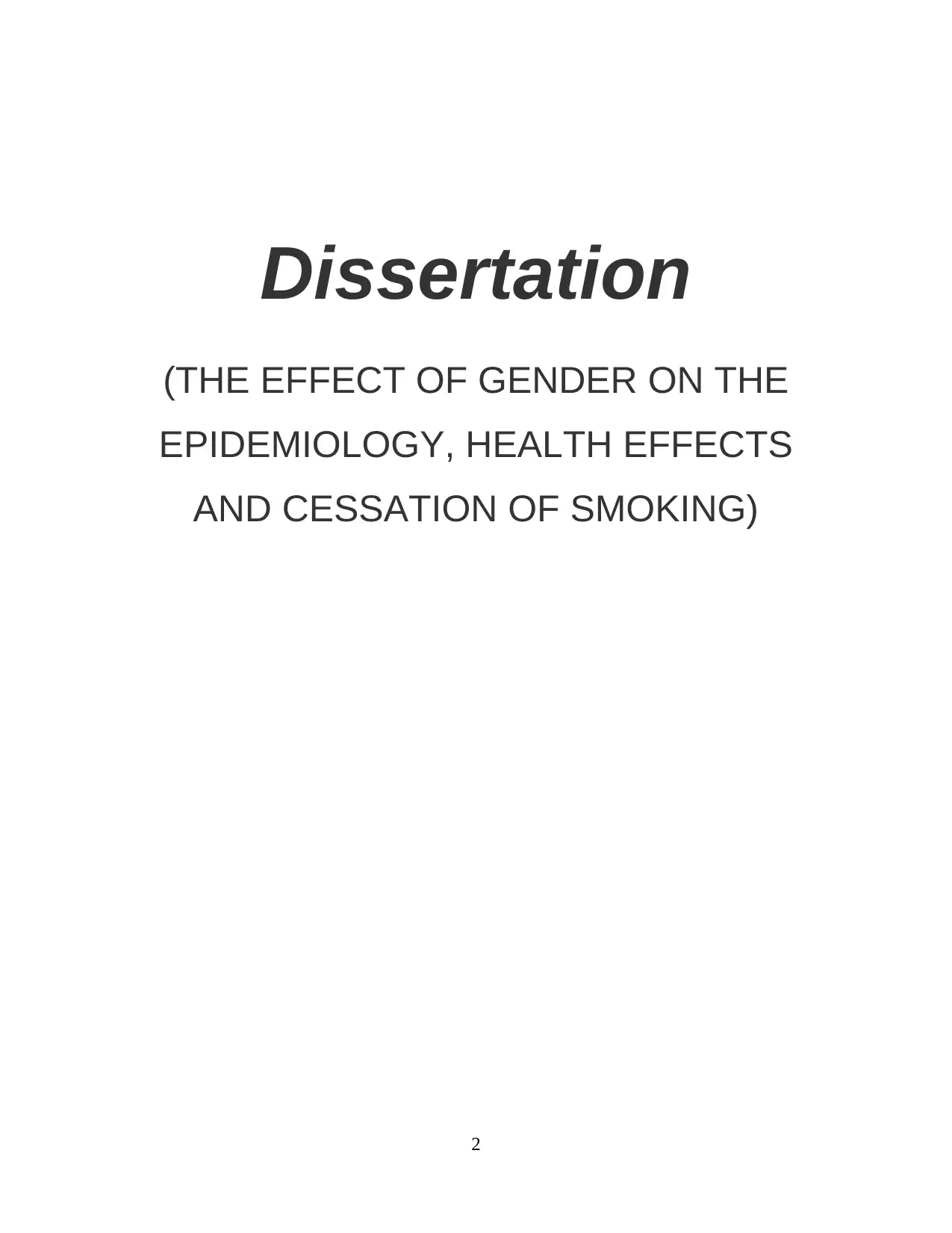
Dissertation
(THE EFFECT OF GENDER ON THE
EPIDEMIOLOGY, HEALTH EFFECTS
AND CESSATION OF SMOKING)
2
(THE EFFECT OF GENDER ON THE
EPIDEMIOLOGY, HEALTH EFFECTS
AND CESSATION OF SMOKING)
2
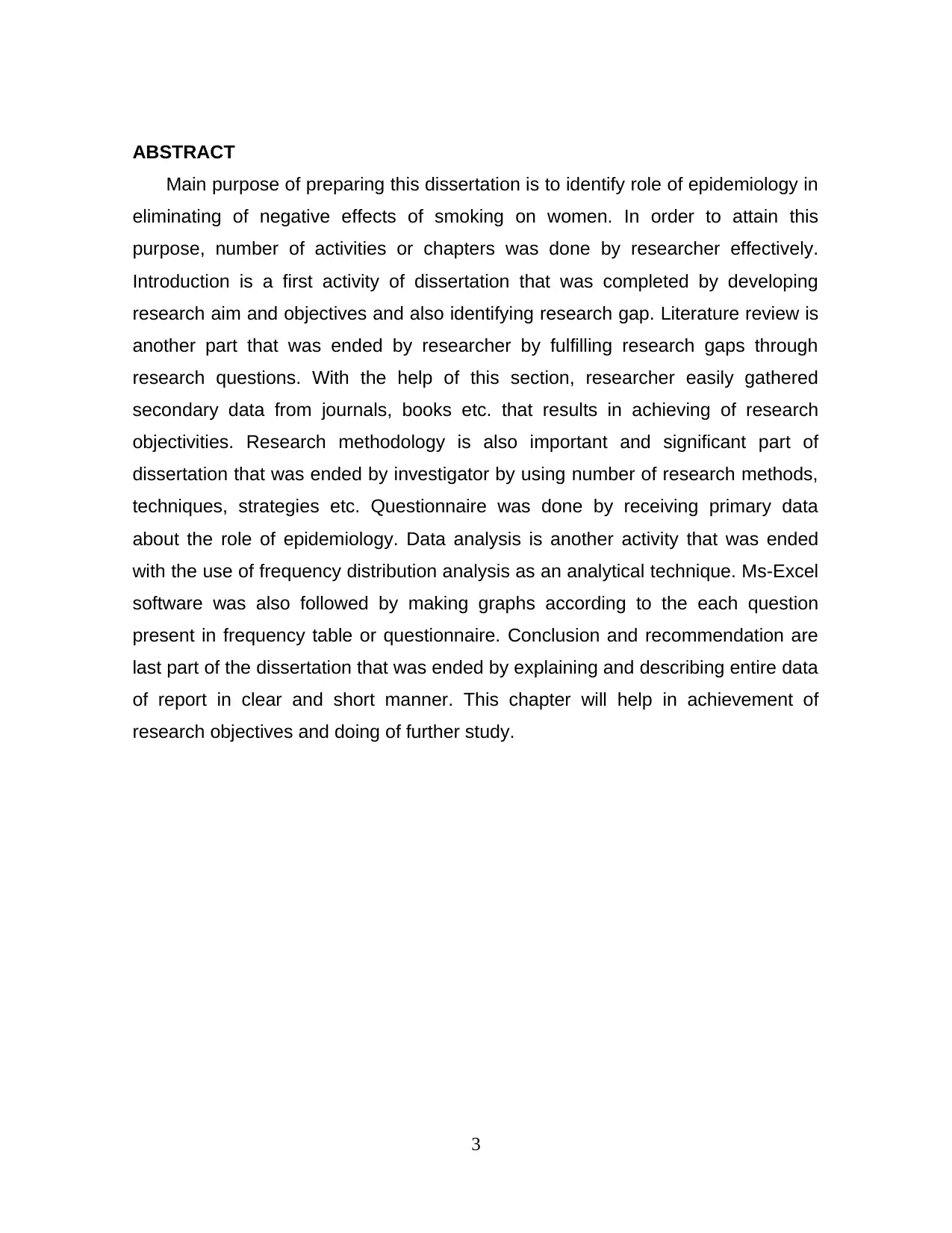
ABSTRACT
Main purpose of preparing this dissertation is to identify role of epidemiology in
eliminating of negative effects of smoking on women. In order to attain this
purpose, number of activities or chapters was done by researcher effectively.
Introduction is a first activity of dissertation that was completed by developing
research aim and objectives and also identifying research gap. Literature review is
another part that was ended by researcher by fulfilling research gaps through
research questions. With the help of this section, researcher easily gathered
secondary data from journals, books etc. that results in achieving of research
objectivities. Research methodology is also important and significant part of
dissertation that was ended by investigator by using number of research methods,
techniques, strategies etc. Questionnaire was done by receiving primary data
about the role of epidemiology. Data analysis is another activity that was ended
with the use of frequency distribution analysis as an analytical technique. Ms-Excel
software was also followed by making graphs according to the each question
present in frequency table or questionnaire. Conclusion and recommendation are
last part of the dissertation that was ended by explaining and describing entire data
of report in clear and short manner. This chapter will help in achievement of
research objectives and doing of further study.
3
Main purpose of preparing this dissertation is to identify role of epidemiology in
eliminating of negative effects of smoking on women. In order to attain this
purpose, number of activities or chapters was done by researcher effectively.
Introduction is a first activity of dissertation that was completed by developing
research aim and objectives and also identifying research gap. Literature review is
another part that was ended by researcher by fulfilling research gaps through
research questions. With the help of this section, researcher easily gathered
secondary data from journals, books etc. that results in achieving of research
objectivities. Research methodology is also important and significant part of
dissertation that was ended by investigator by using number of research methods,
techniques, strategies etc. Questionnaire was done by receiving primary data
about the role of epidemiology. Data analysis is another activity that was ended
with the use of frequency distribution analysis as an analytical technique. Ms-Excel
software was also followed by making graphs according to the each question
present in frequency table or questionnaire. Conclusion and recommendation are
last part of the dissertation that was ended by explaining and describing entire data
of report in clear and short manner. This chapter will help in achievement of
research objectives and doing of further study.
3

Contents
ABSTRACT ...............................................................................................................2
ACKNOWLEDGEMENT ...........................................................................................4
CHAPTER 1: INTRODUCTION ................................................................................5
Overview of the research title ................................................................................5
Rationale of research ...........................................................................................5
Research question.................................................................................................5
Aims and Objectives...............................................................................................6
Research gap.........................................................................................................6
Structure of the dissertation .................................................................................6
CHAPTER 2: LITERATURE REVIEW ......................................................................8
What are the roles of epidemiology in improving human health? .........................8
What are the benefits of smoking cessation on health of women? ......................9
What are the several ways through which negative effect of smoking on women
health can be minimised? ...................................................................................11
What are the impacts of epidemiology in minimising negative health effects of
smoking on women? ...........................................................................................12
Conclusion of literature ........................................................................................14
CHAPTER 3: RESEARCH METHODOLOGY ........................................................15
CHAPTER 4: DATA ANALYSIS/RESULTS AND DISCUSSION ...........................19
CHAPTER 5: CONCLUSION AND RECOMMENDATIONS...................................32
Conclusion ...........................................................................................................32
Recommendations ..............................................................................................32
REFLECTION .........................................................................................................35
................................................................................................................................36
REFERENCES ........................................................................................................37
Appendix..................................................................................................................40
Questionnaire ......................................................................................................40
................................................................................................................................41
4
ABSTRACT ...............................................................................................................2
ACKNOWLEDGEMENT ...........................................................................................4
CHAPTER 1: INTRODUCTION ................................................................................5
Overview of the research title ................................................................................5
Rationale of research ...........................................................................................5
Research question.................................................................................................5
Aims and Objectives...............................................................................................6
Research gap.........................................................................................................6
Structure of the dissertation .................................................................................6
CHAPTER 2: LITERATURE REVIEW ......................................................................8
What are the roles of epidemiology in improving human health? .........................8
What are the benefits of smoking cessation on health of women? ......................9
What are the several ways through which negative effect of smoking on women
health can be minimised? ...................................................................................11
What are the impacts of epidemiology in minimising negative health effects of
smoking on women? ...........................................................................................12
Conclusion of literature ........................................................................................14
CHAPTER 3: RESEARCH METHODOLOGY ........................................................15
CHAPTER 4: DATA ANALYSIS/RESULTS AND DISCUSSION ...........................19
CHAPTER 5: CONCLUSION AND RECOMMENDATIONS...................................32
Conclusion ...........................................................................................................32
Recommendations ..............................................................................................32
REFLECTION .........................................................................................................35
................................................................................................................................36
REFERENCES ........................................................................................................37
Appendix..................................................................................................................40
Questionnaire ......................................................................................................40
................................................................................................................................41
4
Secure Best Marks with AI Grader
Need help grading? Try our AI Grader for instant feedback on your assignments.

ACKNOWLEDGEMENT
I would like to acknowledge each and every person who played an important
role in completion of my dissertation over the topic of the role of epidemiology in
terminating negative health effects of smoking on women.
I would like to thank my seniors by providing me an effective chance for doing
dissertation on interesting and valuable topic. I also express thanks to my parents,
by providing me an accurate guidance that helped me in completion of this
dissertation.
I would also thank my friends and juniors for their best support and
encouragement in executing the dissertation work.
5
I would like to acknowledge each and every person who played an important
role in completion of my dissertation over the topic of the role of epidemiology in
terminating negative health effects of smoking on women.
I would like to thank my seniors by providing me an effective chance for doing
dissertation on interesting and valuable topic. I also express thanks to my parents,
by providing me an accurate guidance that helped me in completion of this
dissertation.
I would also thank my friends and juniors for their best support and
encouragement in executing the dissertation work.
5

CHAPTER 1: INTRODUCTION
Overview of the research title
Epidemiology is a branch of medical science that basically deals with the
incidence and control of disease within a population (What is Epidemiology? 2020).
In addition, it is the sum of the factors that helps in controlling of absence or
presence of a pathogen or disease. There are number of effects of smoking on the
users such as cancer, lung diseases, asthma attacks etc. Smoking also has bad or
negative effects on women in different ways such as have more irregular or painful
periods, risk of heart disease, increased risk of cervical cancer, higher risk of being
born too early, higher risk of serious birth defects and many others. All these are
major issues of smoking for women who use on daily basis. In order to overcome
this effect on women, Epidemiology plays an important role by studding about the
diseases in population.
Background of epidemiology
Epidemiology is defined as the study of the patterns, causes, and
effects of health and disease conditions in defined populations (Sanders
and Fink, 2016). This is known as the way by which different aspects like
public health, and informs policy decisions and evidence-based medicine
are identified within disease context. The study by Epidemiologists helps
with study design, collection and statistical analysis of data, and
interpretation and dissemination of results. The Greek physician
Hippocrates is known as the father of medicine, and was the first
epidemiologist. Hippocrates sought a logic to sickness. He is the first
person known to have examined the relationships between the
occurrence of disease and environmental influences. Hippocrates
believed sickness of the human body to be caused by an imbalance of
the four Humors (air, fire, water and earth “atoms”). The cure to the
sickness was to remove or add the humor in question to balance the
6
Overview of the research title
Epidemiology is a branch of medical science that basically deals with the
incidence and control of disease within a population (What is Epidemiology? 2020).
In addition, it is the sum of the factors that helps in controlling of absence or
presence of a pathogen or disease. There are number of effects of smoking on the
users such as cancer, lung diseases, asthma attacks etc. Smoking also has bad or
negative effects on women in different ways such as have more irregular or painful
periods, risk of heart disease, increased risk of cervical cancer, higher risk of being
born too early, higher risk of serious birth defects and many others. All these are
major issues of smoking for women who use on daily basis. In order to overcome
this effect on women, Epidemiology plays an important role by studding about the
diseases in population.
Background of epidemiology
Epidemiology is defined as the study of the patterns, causes, and
effects of health and disease conditions in defined populations (Sanders
and Fink, 2016). This is known as the way by which different aspects like
public health, and informs policy decisions and evidence-based medicine
are identified within disease context. The study by Epidemiologists helps
with study design, collection and statistical analysis of data, and
interpretation and dissemination of results. The Greek physician
Hippocrates is known as the father of medicine, and was the first
epidemiologist. Hippocrates sought a logic to sickness. He is the first
person known to have examined the relationships between the
occurrence of disease and environmental influences. Hippocrates
believed sickness of the human body to be caused by an imbalance of
the four Humors (air, fire, water and earth “atoms”). The cure to the
sickness was to remove or add the humor in question to balance the
6
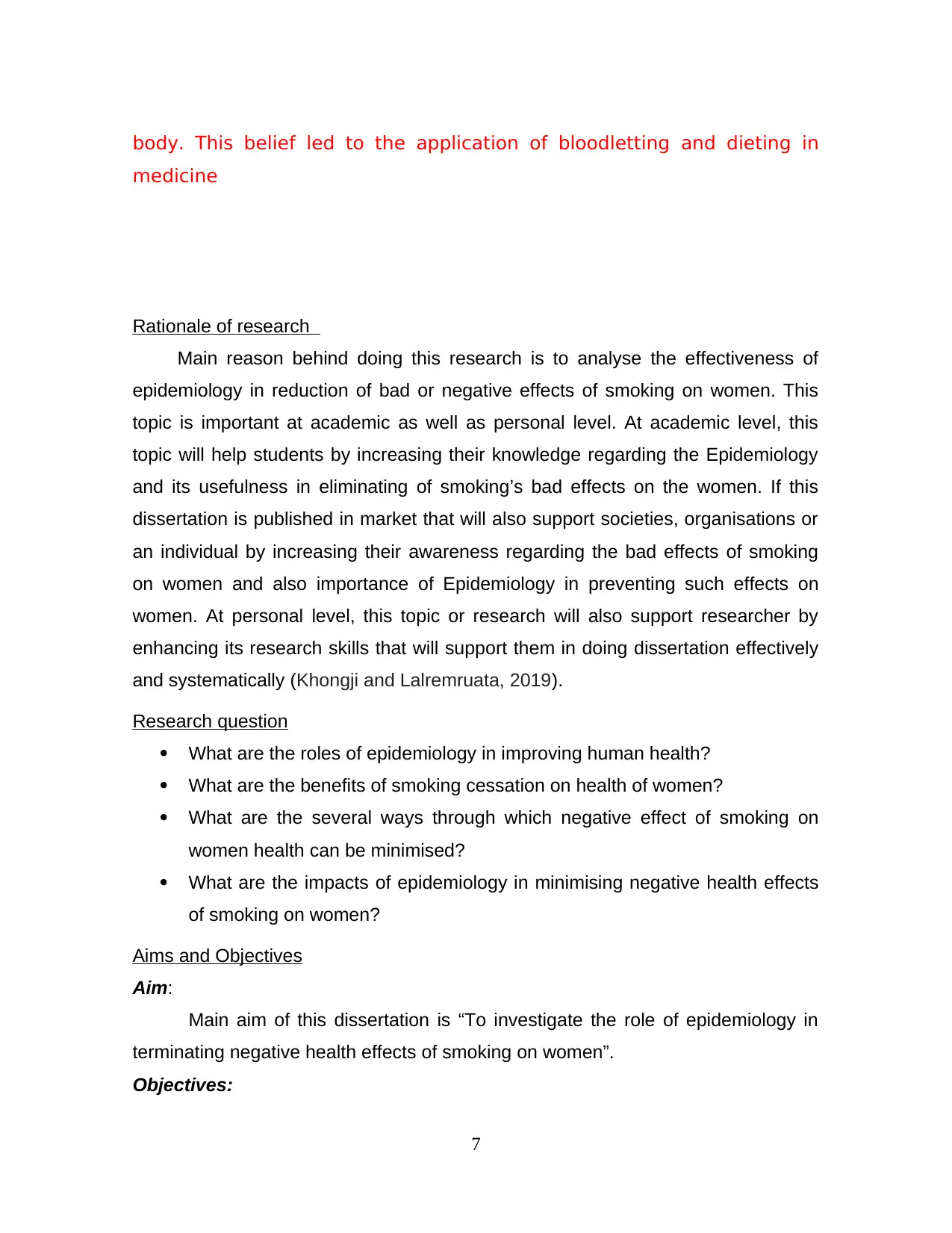
body. This belief led to the application of bloodletting and dieting in
medicine
Rationale of research
Main reason behind doing this research is to analyse the effectiveness of
epidemiology in reduction of bad or negative effects of smoking on women. This
topic is important at academic as well as personal level. At academic level, this
topic will help students by increasing their knowledge regarding the Epidemiology
and its usefulness in eliminating of smoking’s bad effects on the women. If this
dissertation is published in market that will also support societies, organisations or
an individual by increasing their awareness regarding the bad effects of smoking
on women and also importance of Epidemiology in preventing such effects on
women. At personal level, this topic or research will also support researcher by
enhancing its research skills that will support them in doing dissertation effectively
and systematically (Khongji and Lalremruata, 2019).
Research question
What are the roles of epidemiology in improving human health?
What are the benefits of smoking cessation on health of women?
What are the several ways through which negative effect of smoking on
women health can be minimised?
What are the impacts of epidemiology in minimising negative health effects
of smoking on women?
Aims and Objectives
Aim:
Main aim of this dissertation is “To investigate the role of epidemiology in
terminating negative health effects of smoking on women”.
Objectives:
7
medicine
Rationale of research
Main reason behind doing this research is to analyse the effectiveness of
epidemiology in reduction of bad or negative effects of smoking on women. This
topic is important at academic as well as personal level. At academic level, this
topic will help students by increasing their knowledge regarding the Epidemiology
and its usefulness in eliminating of smoking’s bad effects on the women. If this
dissertation is published in market that will also support societies, organisations or
an individual by increasing their awareness regarding the bad effects of smoking
on women and also importance of Epidemiology in preventing such effects on
women. At personal level, this topic or research will also support researcher by
enhancing its research skills that will support them in doing dissertation effectively
and systematically (Khongji and Lalremruata, 2019).
Research question
What are the roles of epidemiology in improving human health?
What are the benefits of smoking cessation on health of women?
What are the several ways through which negative effect of smoking on
women health can be minimised?
What are the impacts of epidemiology in minimising negative health effects
of smoking on women?
Aims and Objectives
Aim:
Main aim of this dissertation is “To investigate the role of epidemiology in
terminating negative health effects of smoking on women”.
Objectives:
7
Paraphrase This Document
Need a fresh take? Get an instant paraphrase of this document with our AI Paraphraser
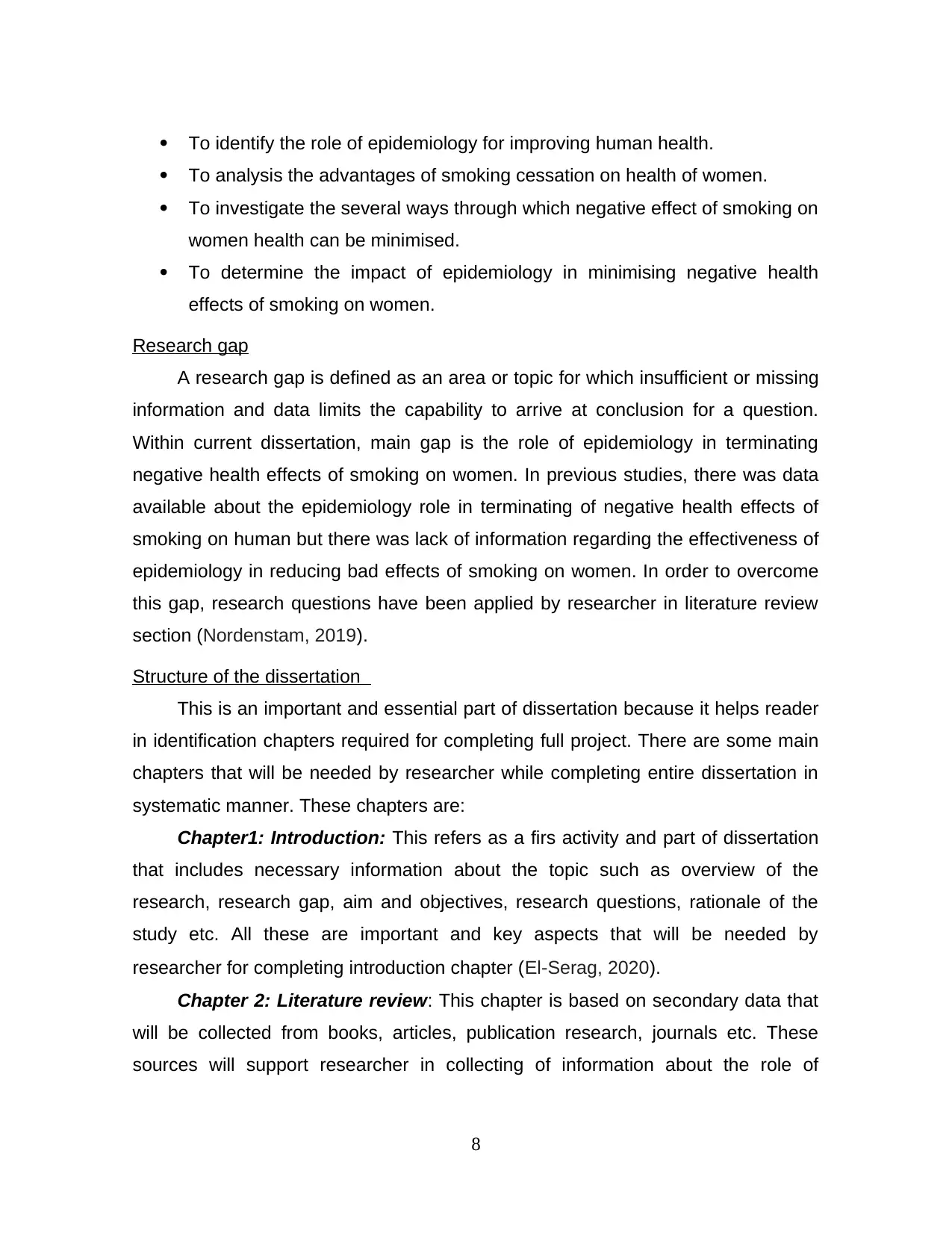
To identify the role of epidemiology for improving human health.
To analysis the advantages of smoking cessation on health of women.
To investigate the several ways through which negative effect of smoking on
women health can be minimised.
To determine the impact of epidemiology in minimising negative health
effects of smoking on women.
Research gap
A research gap is defined as an area or topic for which insufficient or missing
information and data limits the capability to arrive at conclusion for a question.
Within current dissertation, main gap is the role of epidemiology in terminating
negative health effects of smoking on women. In previous studies, there was data
available about the epidemiology role in terminating of negative health effects of
smoking on human but there was lack of information regarding the effectiveness of
epidemiology in reducing bad effects of smoking on women. In order to overcome
this gap, research questions have been applied by researcher in literature review
section (Nordenstam, 2019).
Structure of the dissertation
This is an important and essential part of dissertation because it helps reader
in identification chapters required for completing full project. There are some main
chapters that will be needed by researcher while completing entire dissertation in
systematic manner. These chapters are:
Chapter1: Introduction: This refers as a firs activity and part of dissertation
that includes necessary information about the topic such as overview of the
research, research gap, aim and objectives, research questions, rationale of the
study etc. All these are important and key aspects that will be needed by
researcher for completing introduction chapter (El‐Serag, 2020).
Chapter 2: Literature review: This chapter is based on secondary data that
will be collected from books, articles, publication research, journals etc. These
sources will support researcher in collecting of information about the role of
8
To analysis the advantages of smoking cessation on health of women.
To investigate the several ways through which negative effect of smoking on
women health can be minimised.
To determine the impact of epidemiology in minimising negative health
effects of smoking on women.
Research gap
A research gap is defined as an area or topic for which insufficient or missing
information and data limits the capability to arrive at conclusion for a question.
Within current dissertation, main gap is the role of epidemiology in terminating
negative health effects of smoking on women. In previous studies, there was data
available about the epidemiology role in terminating of negative health effects of
smoking on human but there was lack of information regarding the effectiveness of
epidemiology in reducing bad effects of smoking on women. In order to overcome
this gap, research questions have been applied by researcher in literature review
section (Nordenstam, 2019).
Structure of the dissertation
This is an important and essential part of dissertation because it helps reader
in identification chapters required for completing full project. There are some main
chapters that will be needed by researcher while completing entire dissertation in
systematic manner. These chapters are:
Chapter1: Introduction: This refers as a firs activity and part of dissertation
that includes necessary information about the topic such as overview of the
research, research gap, aim and objectives, research questions, rationale of the
study etc. All these are important and key aspects that will be needed by
researcher for completing introduction chapter (El‐Serag, 2020).
Chapter 2: Literature review: This chapter is based on secondary data that
will be collected from books, articles, publication research, journals etc. These
sources will support researcher in collecting of information about the role of
8
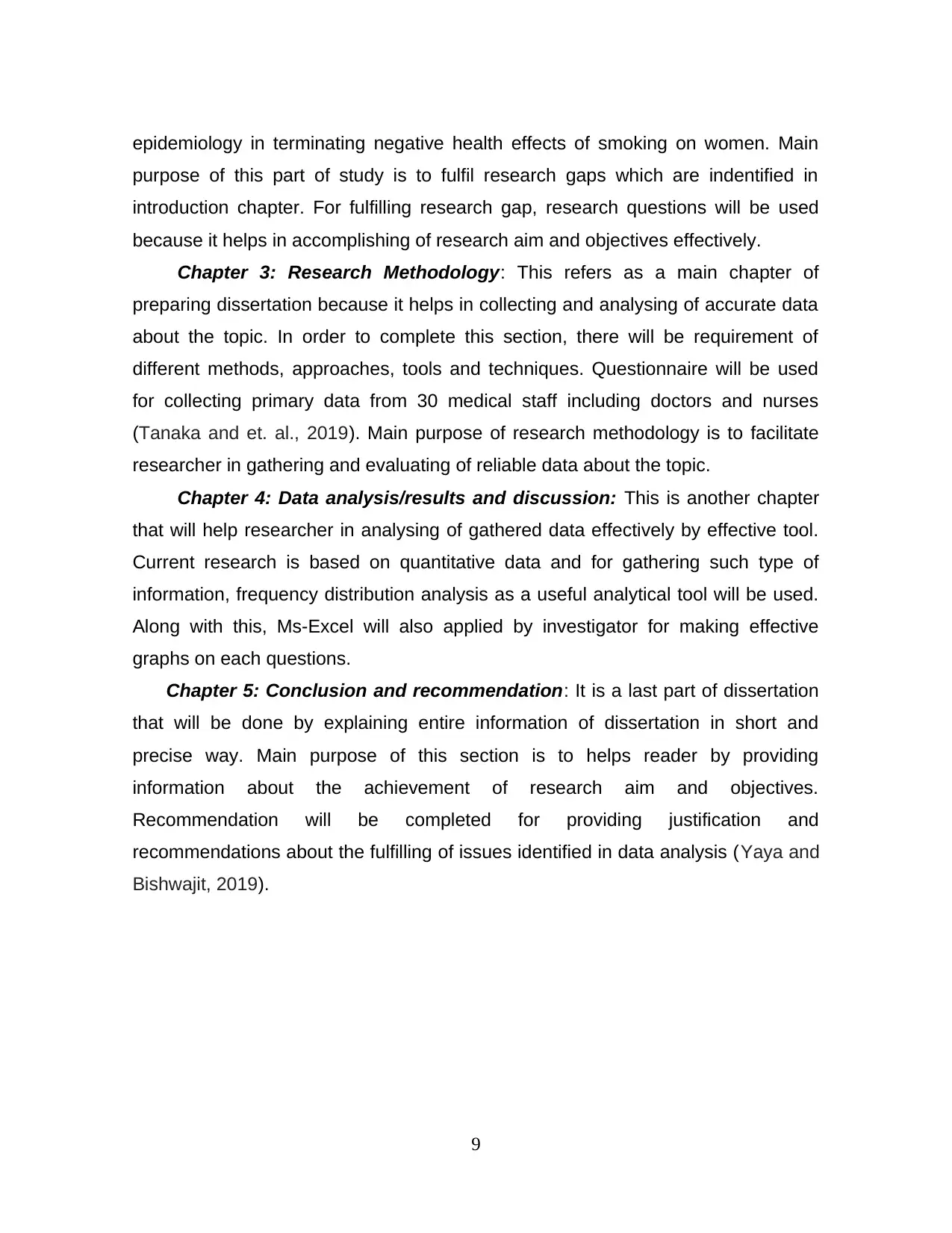
epidemiology in terminating negative health effects of smoking on women. Main
purpose of this part of study is to fulfil research gaps which are indentified in
introduction chapter. For fulfilling research gap, research questions will be used
because it helps in accomplishing of research aim and objectives effectively.
Chapter 3: Research Methodology: This refers as a main chapter of
preparing dissertation because it helps in collecting and analysing of accurate data
about the topic. In order to complete this section, there will be requirement of
different methods, approaches, tools and techniques. Questionnaire will be used
for collecting primary data from 30 medical staff including doctors and nurses
(Tanaka and et. al., 2019). Main purpose of research methodology is to facilitate
researcher in gathering and evaluating of reliable data about the topic.
Chapter 4: Data analysis/results and discussion: This is another chapter
that will help researcher in analysing of gathered data effectively by effective tool.
Current research is based on quantitative data and for gathering such type of
information, frequency distribution analysis as a useful analytical tool will be used.
Along with this, Ms-Excel will also applied by investigator for making effective
graphs on each questions.
Chapter 5: Conclusion and recommendation: It is a last part of dissertation
that will be done by explaining entire information of dissertation in short and
precise way. Main purpose of this section is to helps reader by providing
information about the achievement of research aim and objectives.
Recommendation will be completed for providing justification and
recommendations about the fulfilling of issues identified in data analysis (Yaya and
Bishwajit, 2019).
9
purpose of this part of study is to fulfil research gaps which are indentified in
introduction chapter. For fulfilling research gap, research questions will be used
because it helps in accomplishing of research aim and objectives effectively.
Chapter 3: Research Methodology: This refers as a main chapter of
preparing dissertation because it helps in collecting and analysing of accurate data
about the topic. In order to complete this section, there will be requirement of
different methods, approaches, tools and techniques. Questionnaire will be used
for collecting primary data from 30 medical staff including doctors and nurses
(Tanaka and et. al., 2019). Main purpose of research methodology is to facilitate
researcher in gathering and evaluating of reliable data about the topic.
Chapter 4: Data analysis/results and discussion: This is another chapter
that will help researcher in analysing of gathered data effectively by effective tool.
Current research is based on quantitative data and for gathering such type of
information, frequency distribution analysis as a useful analytical tool will be used.
Along with this, Ms-Excel will also applied by investigator for making effective
graphs on each questions.
Chapter 5: Conclusion and recommendation: It is a last part of dissertation
that will be done by explaining entire information of dissertation in short and
precise way. Main purpose of this section is to helps reader by providing
information about the achievement of research aim and objectives.
Recommendation will be completed for providing justification and
recommendations about the fulfilling of issues identified in data analysis (Yaya and
Bishwajit, 2019).
9
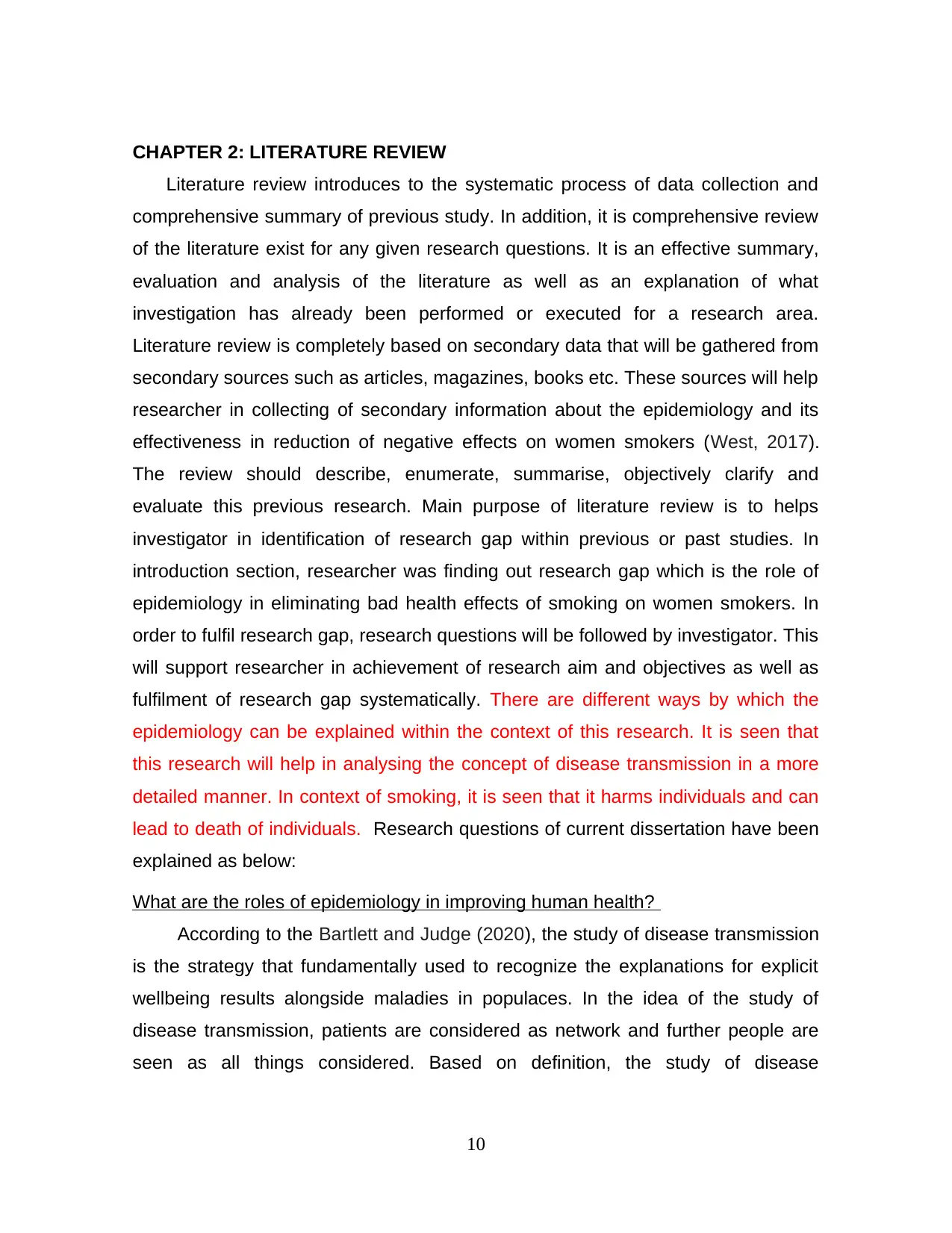
CHAPTER 2: LITERATURE REVIEW
Literature review introduces to the systematic process of data collection and
comprehensive summary of previous study. In addition, it is comprehensive review
of the literature exist for any given research questions. It is an effective summary,
evaluation and analysis of the literature as well as an explanation of what
investigation has already been performed or executed for a research area.
Literature review is completely based on secondary data that will be gathered from
secondary sources such as articles, magazines, books etc. These sources will help
researcher in collecting of secondary information about the epidemiology and its
effectiveness in reduction of negative effects on women smokers (West, 2017).
The review should describe, enumerate, summarise, objectively clarify and
evaluate this previous research. Main purpose of literature review is to helps
investigator in identification of research gap within previous or past studies. In
introduction section, researcher was finding out research gap which is the role of
epidemiology in eliminating bad health effects of smoking on women smokers. In
order to fulfil research gap, research questions will be followed by investigator. This
will support researcher in achievement of research aim and objectives as well as
fulfilment of research gap systematically. There are different ways by which the
epidemiology can be explained within the context of this research. It is seen that
this research will help in analysing the concept of disease transmission in a more
detailed manner. In context of smoking, it is seen that it harms individuals and can
lead to death of individuals. Research questions of current dissertation have been
explained as below:
What are the roles of epidemiology in improving human health?
According to the Bartlett and Judge (2020), the study of disease transmission
is the strategy that fundamentally used to recognize the explanations for explicit
wellbeing results alongside maladies in populaces. In the idea of the study of
disease transmission, patients are considered as network and further people are
seen as all things considered. Based on definition, the study of disease
10
Literature review introduces to the systematic process of data collection and
comprehensive summary of previous study. In addition, it is comprehensive review
of the literature exist for any given research questions. It is an effective summary,
evaluation and analysis of the literature as well as an explanation of what
investigation has already been performed or executed for a research area.
Literature review is completely based on secondary data that will be gathered from
secondary sources such as articles, magazines, books etc. These sources will help
researcher in collecting of secondary information about the epidemiology and its
effectiveness in reduction of negative effects on women smokers (West, 2017).
The review should describe, enumerate, summarise, objectively clarify and
evaluate this previous research. Main purpose of literature review is to helps
investigator in identification of research gap within previous or past studies. In
introduction section, researcher was finding out research gap which is the role of
epidemiology in eliminating bad health effects of smoking on women smokers. In
order to fulfil research gap, research questions will be followed by investigator. This
will support researcher in achievement of research aim and objectives as well as
fulfilment of research gap systematically. There are different ways by which the
epidemiology can be explained within the context of this research. It is seen that
this research will help in analysing the concept of disease transmission in a more
detailed manner. In context of smoking, it is seen that it harms individuals and can
lead to death of individuals. Research questions of current dissertation have been
explained as below:
What are the roles of epidemiology in improving human health?
According to the Bartlett and Judge (2020), the study of disease transmission
is the strategy that fundamentally used to recognize the explanations for explicit
wellbeing results alongside maladies in populaces. In the idea of the study of
disease transmission, patients are considered as network and further people are
seen as all things considered. Based on definition, the study of disease
10
Secure Best Marks with AI Grader
Need help grading? Try our AI Grader for instant feedback on your assignments.
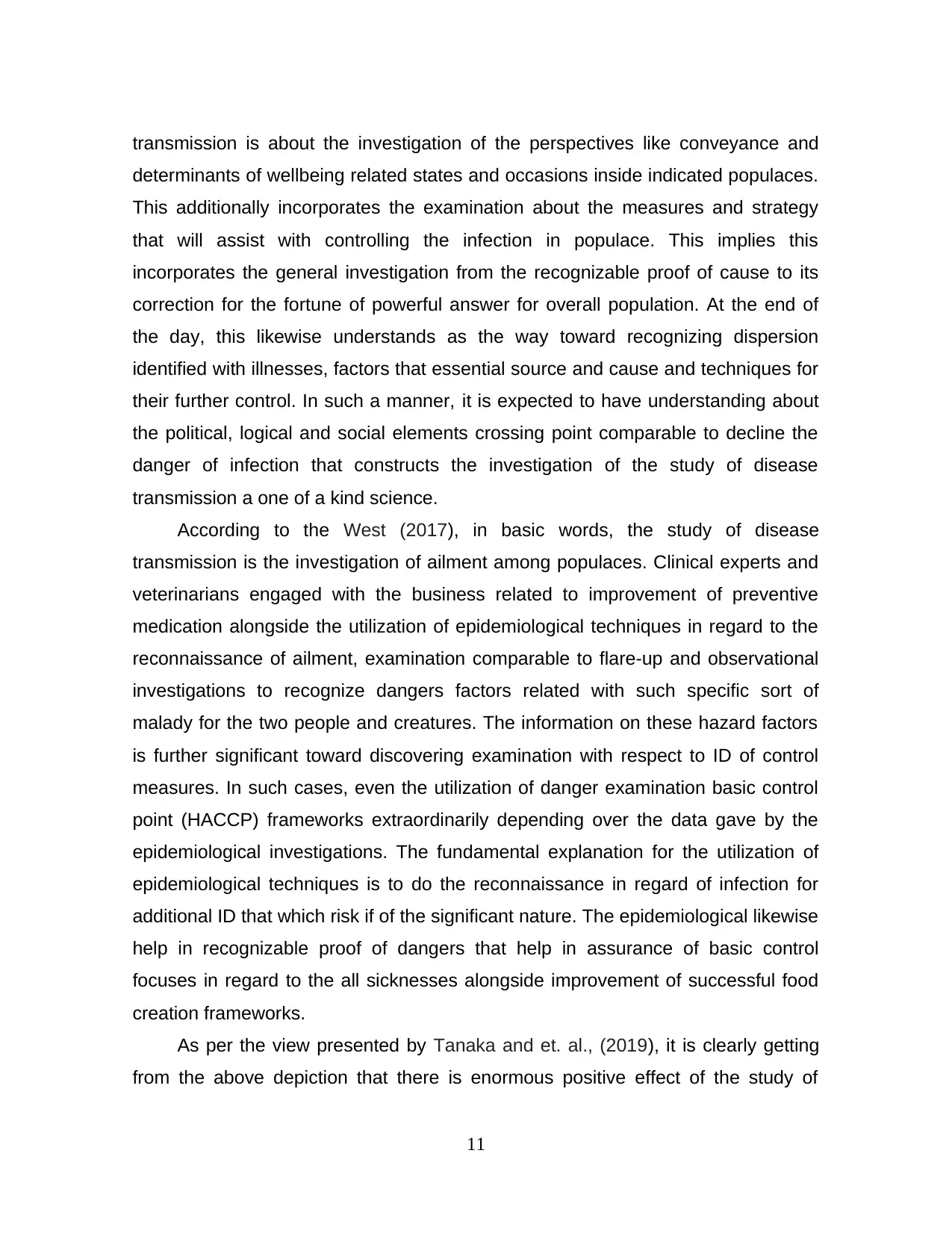
transmission is about the investigation of the perspectives like conveyance and
determinants of wellbeing related states and occasions inside indicated populaces.
This additionally incorporates the examination about the measures and strategy
that will assist with controlling the infection in populace. This implies this
incorporates the general investigation from the recognizable proof of cause to its
correction for the fortune of powerful answer for overall population. At the end of
the day, this likewise understands as the way toward recognizing dispersion
identified with illnesses, factors that essential source and cause and techniques for
their further control. In such a manner, it is expected to have understanding about
the political, logical and social elements crossing point comparable to decline the
danger of infection that constructs the investigation of the study of disease
transmission a one of a kind science.
According to the West (2017), in basic words, the study of disease
transmission is the investigation of ailment among populaces. Clinical experts and
veterinarians engaged with the business related to improvement of preventive
medication alongside the utilization of epidemiological techniques in regard to the
reconnaissance of ailment, examination comparable to flare-up and observational
investigations to recognize dangers factors related with such specific sort of
malady for the two people and creatures. The information on these hazard factors
is further significant toward discovering examination with respect to ID of control
measures. In such cases, even the utilization of danger examination basic control
point (HACCP) frameworks extraordinarily depending over the data gave by the
epidemiological investigations. The fundamental explanation for the utilization of
epidemiological techniques is to do the reconnaissance in regard of infection for
additional ID that which risk if of the significant nature. The epidemiological likewise
help in recognizable proof of dangers that help in assurance of basic control
focuses in regard to the all sicknesses alongside improvement of successful food
creation frameworks.
As per the view presented by Tanaka and et. al., (2019), it is clearly getting
from the above depiction that there is enormous positive effect of the study of
11
determinants of wellbeing related states and occasions inside indicated populaces.
This additionally incorporates the examination about the measures and strategy
that will assist with controlling the infection in populace. This implies this
incorporates the general investigation from the recognizable proof of cause to its
correction for the fortune of powerful answer for overall population. At the end of
the day, this likewise understands as the way toward recognizing dispersion
identified with illnesses, factors that essential source and cause and techniques for
their further control. In such a manner, it is expected to have understanding about
the political, logical and social elements crossing point comparable to decline the
danger of infection that constructs the investigation of the study of disease
transmission a one of a kind science.
According to the West (2017), in basic words, the study of disease
transmission is the investigation of ailment among populaces. Clinical experts and
veterinarians engaged with the business related to improvement of preventive
medication alongside the utilization of epidemiological techniques in regard to the
reconnaissance of ailment, examination comparable to flare-up and observational
investigations to recognize dangers factors related with such specific sort of
malady for the two people and creatures. The information on these hazard factors
is further significant toward discovering examination with respect to ID of control
measures. In such cases, even the utilization of danger examination basic control
point (HACCP) frameworks extraordinarily depending over the data gave by the
epidemiological investigations. The fundamental explanation for the utilization of
epidemiological techniques is to do the reconnaissance in regard of infection for
additional ID that which risk if of the significant nature. The epidemiological likewise
help in recognizable proof of dangers that help in assurance of basic control
focuses in regard to the all sicknesses alongside improvement of successful food
creation frameworks.
As per the view presented by Tanaka and et. al., (2019), it is clearly getting
from the above depiction that there is enormous positive effect of the study of
11
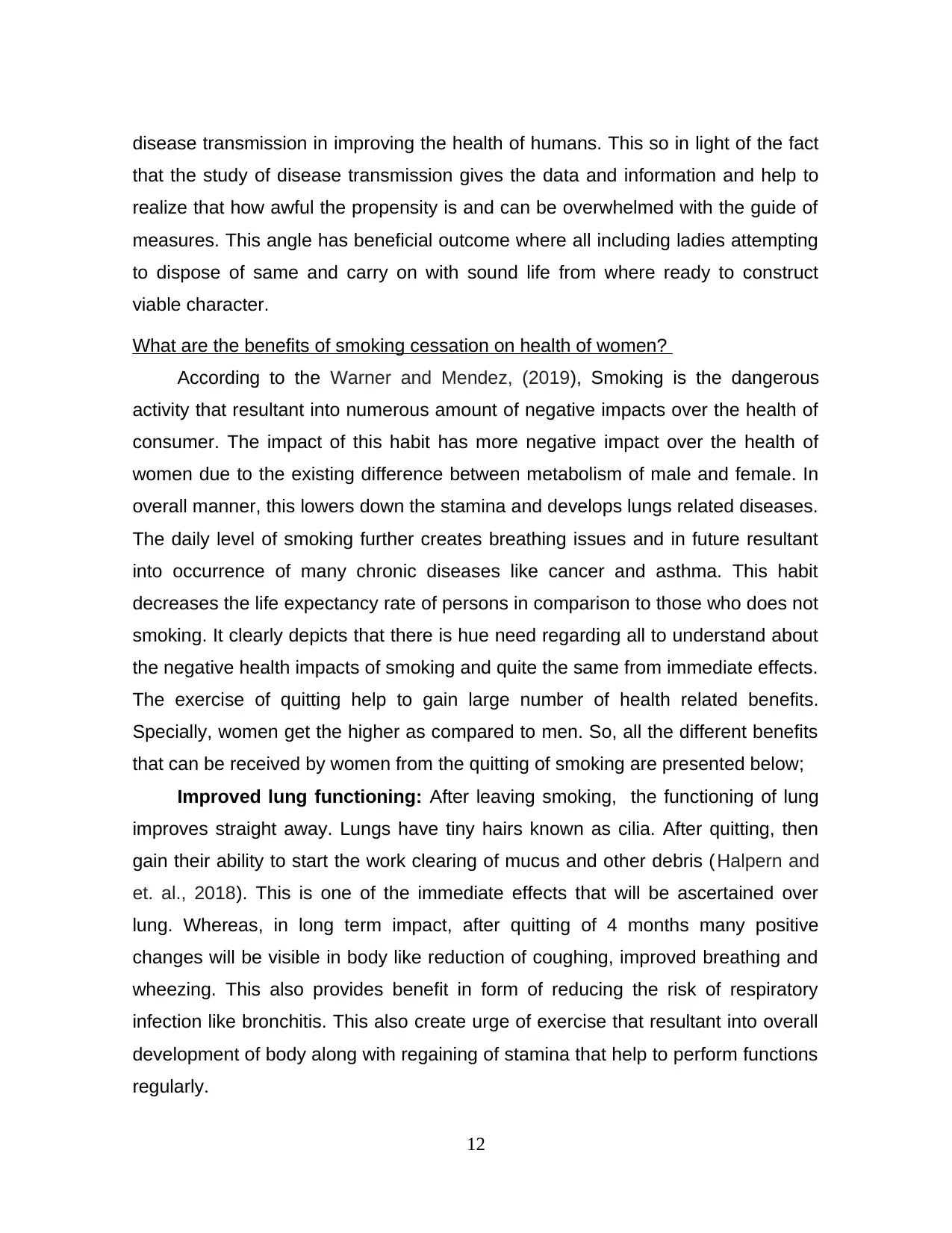
disease transmission in improving the health of humans. This so in light of the fact
that the study of disease transmission gives the data and information and help to
realize that how awful the propensity is and can be overwhelmed with the guide of
measures. This angle has beneficial outcome where all including ladies attempting
to dispose of same and carry on with sound life from where ready to construct
viable character.
What are the benefits of smoking cessation on health of women?
According to the Warner and Mendez, (2019), Smoking is the dangerous
activity that resultant into numerous amount of negative impacts over the health of
consumer. The impact of this habit has more negative impact over the health of
women due to the existing difference between metabolism of male and female. In
overall manner, this lowers down the stamina and develops lungs related diseases.
The daily level of smoking further creates breathing issues and in future resultant
into occurrence of many chronic diseases like cancer and asthma. This habit
decreases the life expectancy rate of persons in comparison to those who does not
smoking. It clearly depicts that there is hue need regarding all to understand about
the negative health impacts of smoking and quite the same from immediate effects.
The exercise of quitting help to gain large number of health related benefits.
Specially, women get the higher as compared to men. So, all the different benefits
that can be received by women from the quitting of smoking are presented below;
Improved lung functioning: After leaving smoking, the functioning of lung
improves straight away. Lungs have tiny hairs known as cilia. After quitting, then
gain their ability to start the work clearing of mucus and other debris ( Halpern and
et. al., 2018). This is one of the immediate effects that will be ascertained over
lung. Whereas, in long term impact, after quitting of 4 months many positive
changes will be visible in body like reduction of coughing, improved breathing and
wheezing. This also provides benefit in form of reducing the risk of respiratory
infection like bronchitis. This also create urge of exercise that resultant into overall
development of body along with regaining of stamina that help to perform functions
regularly.
12
that the study of disease transmission gives the data and information and help to
realize that how awful the propensity is and can be overwhelmed with the guide of
measures. This angle has beneficial outcome where all including ladies attempting
to dispose of same and carry on with sound life from where ready to construct
viable character.
What are the benefits of smoking cessation on health of women?
According to the Warner and Mendez, (2019), Smoking is the dangerous
activity that resultant into numerous amount of negative impacts over the health of
consumer. The impact of this habit has more negative impact over the health of
women due to the existing difference between metabolism of male and female. In
overall manner, this lowers down the stamina and develops lungs related diseases.
The daily level of smoking further creates breathing issues and in future resultant
into occurrence of many chronic diseases like cancer and asthma. This habit
decreases the life expectancy rate of persons in comparison to those who does not
smoking. It clearly depicts that there is hue need regarding all to understand about
the negative health impacts of smoking and quite the same from immediate effects.
The exercise of quitting help to gain large number of health related benefits.
Specially, women get the higher as compared to men. So, all the different benefits
that can be received by women from the quitting of smoking are presented below;
Improved lung functioning: After leaving smoking, the functioning of lung
improves straight away. Lungs have tiny hairs known as cilia. After quitting, then
gain their ability to start the work clearing of mucus and other debris ( Halpern and
et. al., 2018). This is one of the immediate effects that will be ascertained over
lung. Whereas, in long term impact, after quitting of 4 months many positive
changes will be visible in body like reduction of coughing, improved breathing and
wheezing. This also provides benefit in form of reducing the risk of respiratory
infection like bronchitis. This also create urge of exercise that resultant into overall
development of body along with regaining of stamina that help to perform functions
regularly.
12
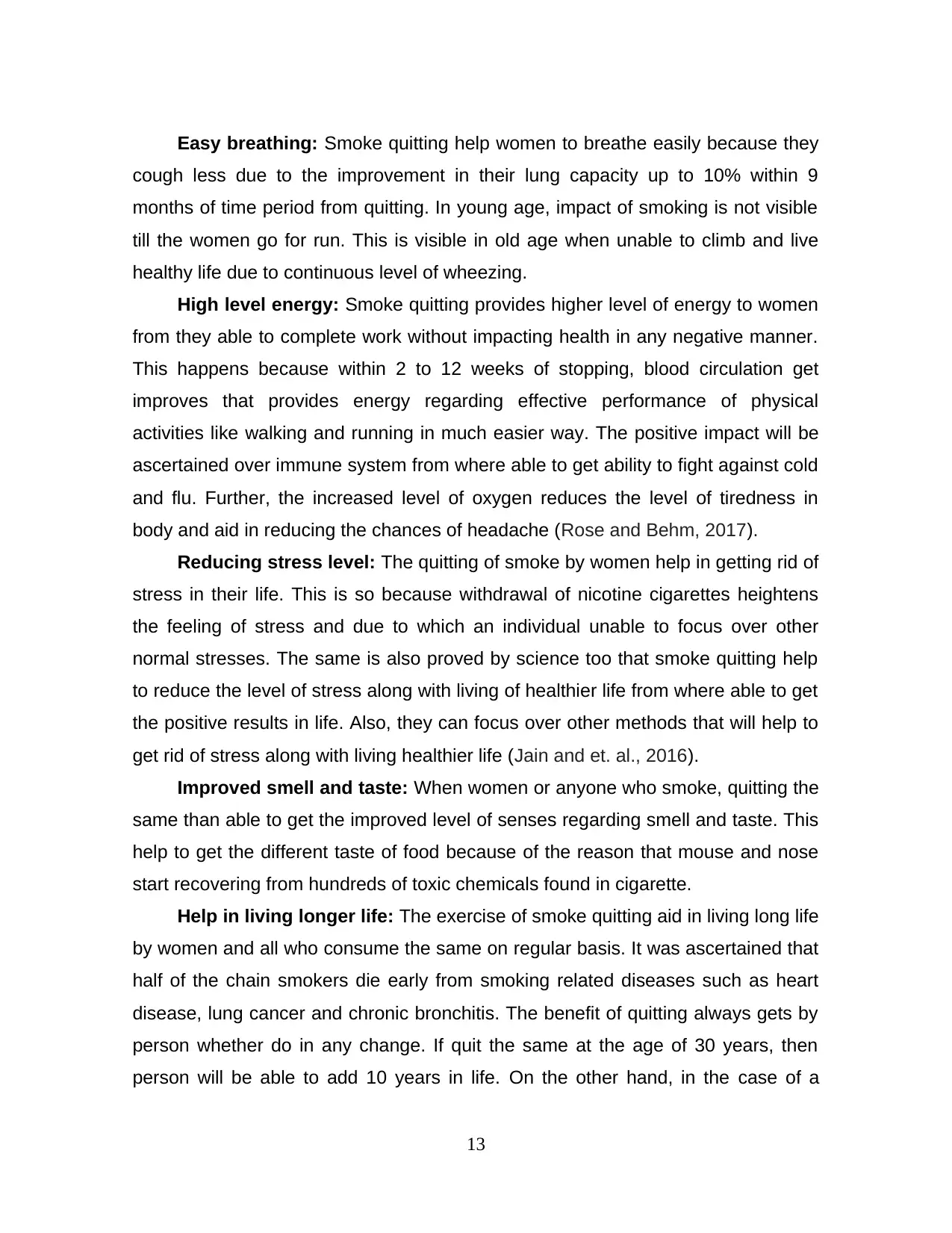
Easy breathing: Smoke quitting help women to breathe easily because they
cough less due to the improvement in their lung capacity up to 10% within 9
months of time period from quitting. In young age, impact of smoking is not visible
till the women go for run. This is visible in old age when unable to climb and live
healthy life due to continuous level of wheezing.
High level energy: Smoke quitting provides higher level of energy to women
from they able to complete work without impacting health in any negative manner.
This happens because within 2 to 12 weeks of stopping, blood circulation get
improves that provides energy regarding effective performance of physical
activities like walking and running in much easier way. The positive impact will be
ascertained over immune system from where able to get ability to fight against cold
and flu. Further, the increased level of oxygen reduces the level of tiredness in
body and aid in reducing the chances of headache (Rose and Behm, 2017).
Reducing stress level: The quitting of smoke by women help in getting rid of
stress in their life. This is so because withdrawal of nicotine cigarettes heightens
the feeling of stress and due to which an individual unable to focus over other
normal stresses. The same is also proved by science too that smoke quitting help
to reduce the level of stress along with living of healthier life from where able to get
the positive results in life. Also, they can focus over other methods that will help to
get rid of stress along with living healthier life (Jain and et. al., 2016).
Improved smell and taste: When women or anyone who smoke, quitting the
same than able to get the improved level of senses regarding smell and taste. This
help to get the different taste of food because of the reason that mouse and nose
start recovering from hundreds of toxic chemicals found in cigarette.
Help in living longer life: The exercise of smoke quitting aid in living long life
by women and all who consume the same on regular basis. It was ascertained that
half of the chain smokers die early from smoking related diseases such as heart
disease, lung cancer and chronic bronchitis. The benefit of quitting always gets by
person whether do in any change. If quit the same at the age of 30 years, then
person will be able to add 10 years in life. On the other hand, in the case of a
13
cough less due to the improvement in their lung capacity up to 10% within 9
months of time period from quitting. In young age, impact of smoking is not visible
till the women go for run. This is visible in old age when unable to climb and live
healthy life due to continuous level of wheezing.
High level energy: Smoke quitting provides higher level of energy to women
from they able to complete work without impacting health in any negative manner.
This happens because within 2 to 12 weeks of stopping, blood circulation get
improves that provides energy regarding effective performance of physical
activities like walking and running in much easier way. The positive impact will be
ascertained over immune system from where able to get ability to fight against cold
and flu. Further, the increased level of oxygen reduces the level of tiredness in
body and aid in reducing the chances of headache (Rose and Behm, 2017).
Reducing stress level: The quitting of smoke by women help in getting rid of
stress in their life. This is so because withdrawal of nicotine cigarettes heightens
the feeling of stress and due to which an individual unable to focus over other
normal stresses. The same is also proved by science too that smoke quitting help
to reduce the level of stress along with living of healthier life from where able to get
the positive results in life. Also, they can focus over other methods that will help to
get rid of stress along with living healthier life (Jain and et. al., 2016).
Improved smell and taste: When women or anyone who smoke, quitting the
same than able to get the improved level of senses regarding smell and taste. This
help to get the different taste of food because of the reason that mouse and nose
start recovering from hundreds of toxic chemicals found in cigarette.
Help in living longer life: The exercise of smoke quitting aid in living long life
by women and all who consume the same on regular basis. It was ascertained that
half of the chain smokers die early from smoking related diseases such as heart
disease, lung cancer and chronic bronchitis. The benefit of quitting always gets by
person whether do in any change. If quit the same at the age of 30 years, then
person will be able to add 10 years in life. On the other hand, in the case of a
13
Paraphrase This Document
Need a fresh take? Get an instant paraphrase of this document with our AI Paraphraser
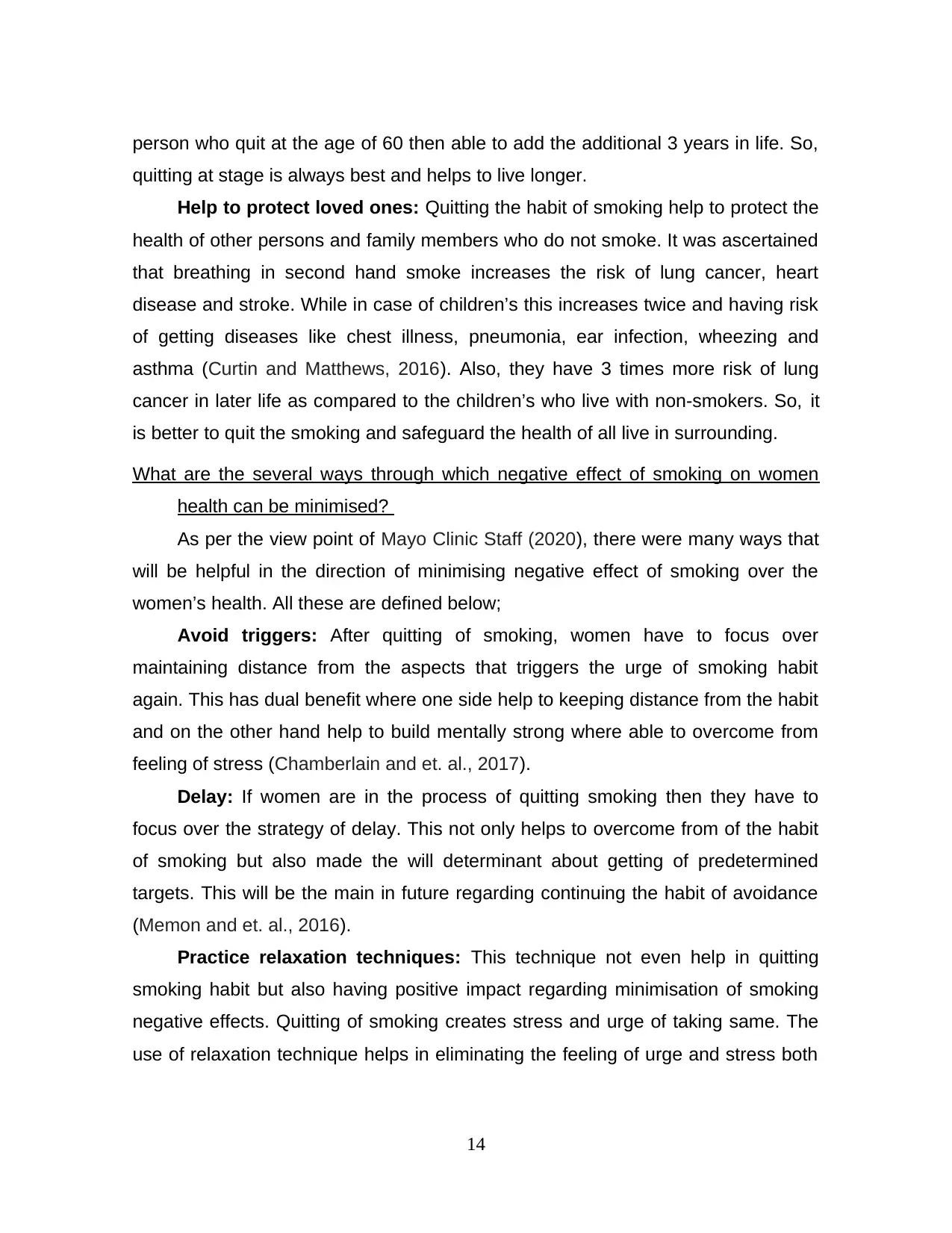
person who quit at the age of 60 then able to add the additional 3 years in life. So,
quitting at stage is always best and helps to live longer.
Help to protect loved ones: Quitting the habit of smoking help to protect the
health of other persons and family members who do not smoke. It was ascertained
that breathing in second hand smoke increases the risk of lung cancer, heart
disease and stroke. While in case of children’s this increases twice and having risk
of getting diseases like chest illness, pneumonia, ear infection, wheezing and
asthma (Curtin and Matthews, 2016). Also, they have 3 times more risk of lung
cancer in later life as compared to the children’s who live with non-smokers. So, it
is better to quit the smoking and safeguard the health of all live in surrounding.
What are the several ways through which negative effect of smoking on women
health can be minimised?
As per the view point of Mayo Clinic Staff (2020), there were many ways that
will be helpful in the direction of minimising negative effect of smoking over the
women’s health. All these are defined below;
Avoid triggers: After quitting of smoking, women have to focus over
maintaining distance from the aspects that triggers the urge of smoking habit
again. This has dual benefit where one side help to keeping distance from the habit
and on the other hand help to build mentally strong where able to overcome from
feeling of stress (Chamberlain and et. al., 2017).
Delay: If women are in the process of quitting smoking then they have to
focus over the strategy of delay. This not only helps to overcome from of the habit
of smoking but also made the will determinant about getting of predetermined
targets. This will be the main in future regarding continuing the habit of avoidance
(Memon and et. al., 2016).
Practice relaxation techniques: This technique not even help in quitting
smoking habit but also having positive impact regarding minimisation of smoking
negative effects. Quitting of smoking creates stress and urge of taking same. The
use of relaxation technique helps in eliminating the feeling of urge and stress both
14
quitting at stage is always best and helps to live longer.
Help to protect loved ones: Quitting the habit of smoking help to protect the
health of other persons and family members who do not smoke. It was ascertained
that breathing in second hand smoke increases the risk of lung cancer, heart
disease and stroke. While in case of children’s this increases twice and having risk
of getting diseases like chest illness, pneumonia, ear infection, wheezing and
asthma (Curtin and Matthews, 2016). Also, they have 3 times more risk of lung
cancer in later life as compared to the children’s who live with non-smokers. So, it
is better to quit the smoking and safeguard the health of all live in surrounding.
What are the several ways through which negative effect of smoking on women
health can be minimised?
As per the view point of Mayo Clinic Staff (2020), there were many ways that
will be helpful in the direction of minimising negative effect of smoking over the
women’s health. All these are defined below;
Avoid triggers: After quitting of smoking, women have to focus over
maintaining distance from the aspects that triggers the urge of smoking habit
again. This has dual benefit where one side help to keeping distance from the habit
and on the other hand help to build mentally strong where able to overcome from
feeling of stress (Chamberlain and et. al., 2017).
Delay: If women are in the process of quitting smoking then they have to
focus over the strategy of delay. This not only helps to overcome from of the habit
of smoking but also made the will determinant about getting of predetermined
targets. This will be the main in future regarding continuing the habit of avoidance
(Memon and et. al., 2016).
Practice relaxation techniques: This technique not even help in quitting
smoking habit but also having positive impact regarding minimisation of smoking
negative effects. Quitting of smoking creates stress and urge of taking same. The
use of relaxation technique helps in eliminating the feeling of urge and stress both
14
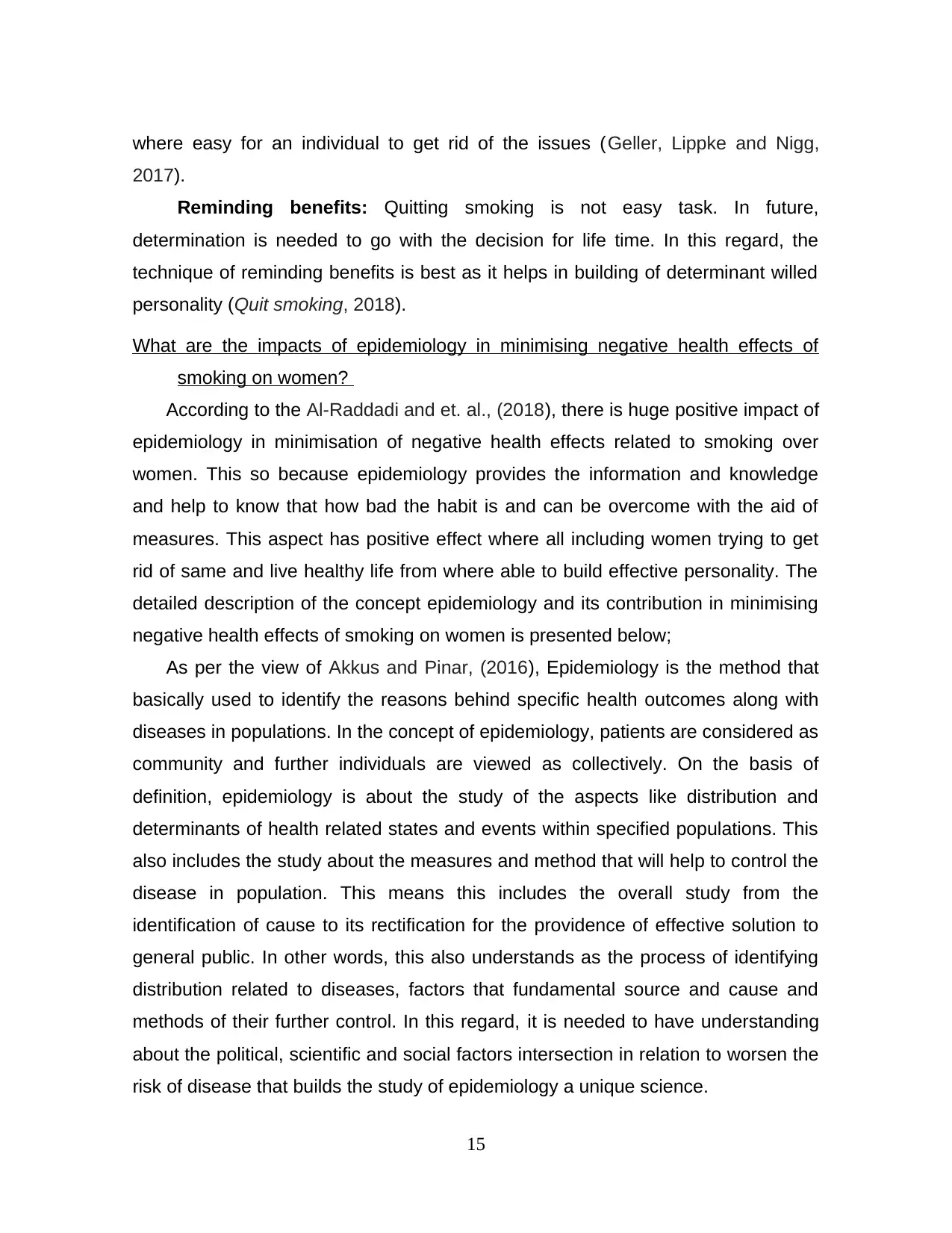
where easy for an individual to get rid of the issues (Geller, Lippke and Nigg,
2017).
Reminding benefits: Quitting smoking is not easy task. In future,
determination is needed to go with the decision for life time. In this regard, the
technique of reminding benefits is best as it helps in building of determinant willed
personality (Quit smoking, 2018).
What are the impacts of epidemiology in minimising negative health effects of
smoking on women?
According to the Al-Raddadi and et. al., (2018), there is huge positive impact of
epidemiology in minimisation of negative health effects related to smoking over
women. This so because epidemiology provides the information and knowledge
and help to know that how bad the habit is and can be overcome with the aid of
measures. This aspect has positive effect where all including women trying to get
rid of same and live healthy life from where able to build effective personality. The
detailed description of the concept epidemiology and its contribution in minimising
negative health effects of smoking on women is presented below;
As per the view of Akkus and Pinar, (2016), Epidemiology is the method that
basically used to identify the reasons behind specific health outcomes along with
diseases in populations. In the concept of epidemiology, patients are considered as
community and further individuals are viewed as collectively. On the basis of
definition, epidemiology is about the study of the aspects like distribution and
determinants of health related states and events within specified populations. This
also includes the study about the measures and method that will help to control the
disease in population. This means this includes the overall study from the
identification of cause to its rectification for the providence of effective solution to
general public. In other words, this also understands as the process of identifying
distribution related to diseases, factors that fundamental source and cause and
methods of their further control. In this regard, it is needed to have understanding
about the political, scientific and social factors intersection in relation to worsen the
risk of disease that builds the study of epidemiology a unique science.
15
2017).
Reminding benefits: Quitting smoking is not easy task. In future,
determination is needed to go with the decision for life time. In this regard, the
technique of reminding benefits is best as it helps in building of determinant willed
personality (Quit smoking, 2018).
What are the impacts of epidemiology in minimising negative health effects of
smoking on women?
According to the Al-Raddadi and et. al., (2018), there is huge positive impact of
epidemiology in minimisation of negative health effects related to smoking over
women. This so because epidemiology provides the information and knowledge
and help to know that how bad the habit is and can be overcome with the aid of
measures. This aspect has positive effect where all including women trying to get
rid of same and live healthy life from where able to build effective personality. The
detailed description of the concept epidemiology and its contribution in minimising
negative health effects of smoking on women is presented below;
As per the view of Akkus and Pinar, (2016), Epidemiology is the method that
basically used to identify the reasons behind specific health outcomes along with
diseases in populations. In the concept of epidemiology, patients are considered as
community and further individuals are viewed as collectively. On the basis of
definition, epidemiology is about the study of the aspects like distribution and
determinants of health related states and events within specified populations. This
also includes the study about the measures and method that will help to control the
disease in population. This means this includes the overall study from the
identification of cause to its rectification for the providence of effective solution to
general public. In other words, this also understands as the process of identifying
distribution related to diseases, factors that fundamental source and cause and
methods of their further control. In this regard, it is needed to have understanding
about the political, scientific and social factors intersection in relation to worsen the
risk of disease that builds the study of epidemiology a unique science.
15
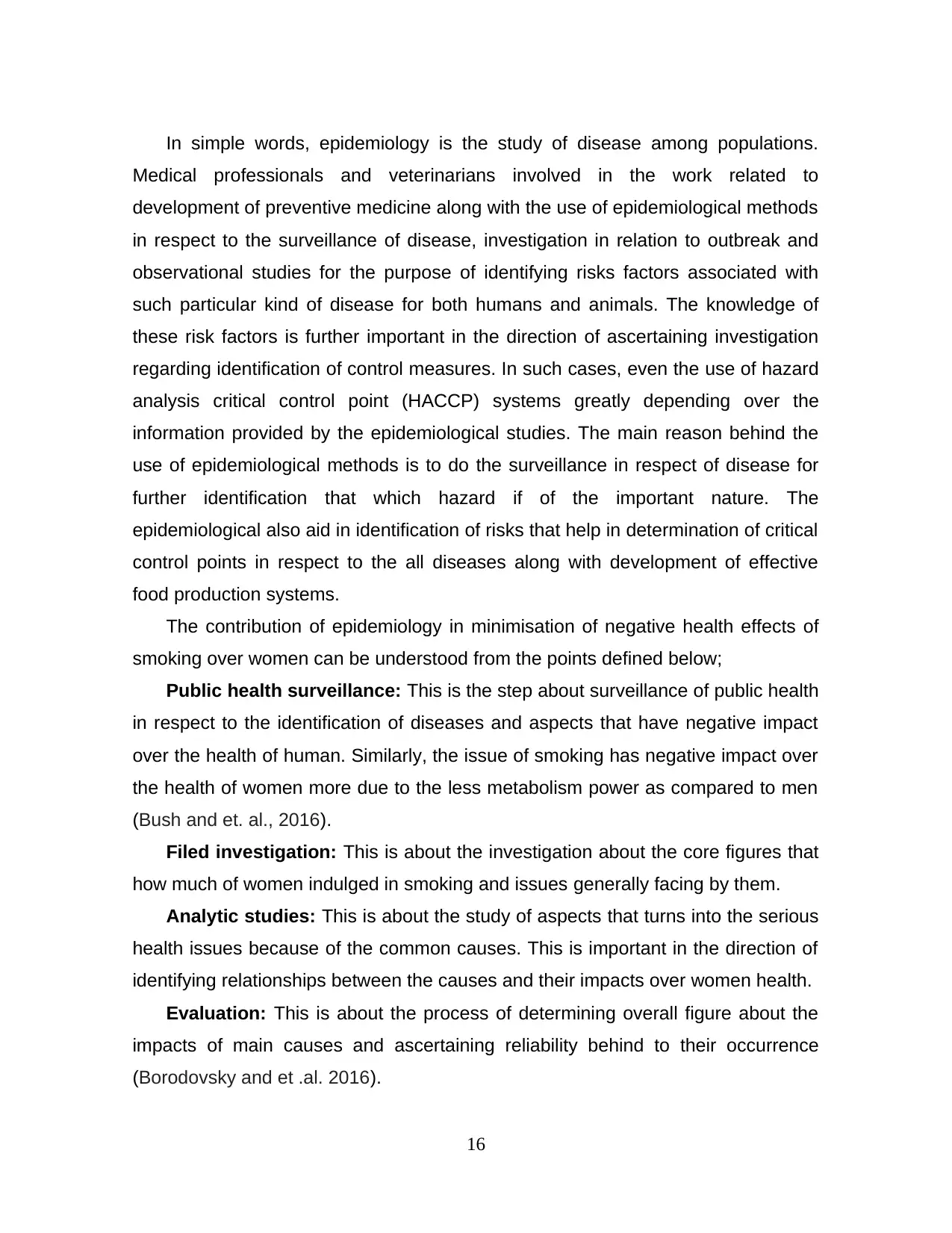
In simple words, epidemiology is the study of disease among populations.
Medical professionals and veterinarians involved in the work related to
development of preventive medicine along with the use of epidemiological methods
in respect to the surveillance of disease, investigation in relation to outbreak and
observational studies for the purpose of identifying risks factors associated with
such particular kind of disease for both humans and animals. The knowledge of
these risk factors is further important in the direction of ascertaining investigation
regarding identification of control measures. In such cases, even the use of hazard
analysis critical control point (HACCP) systems greatly depending over the
information provided by the epidemiological studies. The main reason behind the
use of epidemiological methods is to do the surveillance in respect of disease for
further identification that which hazard if of the important nature. The
epidemiological also aid in identification of risks that help in determination of critical
control points in respect to the all diseases along with development of effective
food production systems.
The contribution of epidemiology in minimisation of negative health effects of
smoking over women can be understood from the points defined below;
Public health surveillance: This is the step about surveillance of public health
in respect to the identification of diseases and aspects that have negative impact
over the health of human. Similarly, the issue of smoking has negative impact over
the health of women more due to the less metabolism power as compared to men
(Bush and et. al., 2016).
Filed investigation: This is about the investigation about the core figures that
how much of women indulged in smoking and issues generally facing by them.
Analytic studies: This is about the study of aspects that turns into the serious
health issues because of the common causes. This is important in the direction of
identifying relationships between the causes and their impacts over women health.
Evaluation: This is about the process of determining overall figure about the
impacts of main causes and ascertaining reliability behind to their occurrence
(Borodovsky and et .al. 2016).
16
Medical professionals and veterinarians involved in the work related to
development of preventive medicine along with the use of epidemiological methods
in respect to the surveillance of disease, investigation in relation to outbreak and
observational studies for the purpose of identifying risks factors associated with
such particular kind of disease for both humans and animals. The knowledge of
these risk factors is further important in the direction of ascertaining investigation
regarding identification of control measures. In such cases, even the use of hazard
analysis critical control point (HACCP) systems greatly depending over the
information provided by the epidemiological studies. The main reason behind the
use of epidemiological methods is to do the surveillance in respect of disease for
further identification that which hazard if of the important nature. The
epidemiological also aid in identification of risks that help in determination of critical
control points in respect to the all diseases along with development of effective
food production systems.
The contribution of epidemiology in minimisation of negative health effects of
smoking over women can be understood from the points defined below;
Public health surveillance: This is the step about surveillance of public health
in respect to the identification of diseases and aspects that have negative impact
over the health of human. Similarly, the issue of smoking has negative impact over
the health of women more due to the less metabolism power as compared to men
(Bush and et. al., 2016).
Filed investigation: This is about the investigation about the core figures that
how much of women indulged in smoking and issues generally facing by them.
Analytic studies: This is about the study of aspects that turns into the serious
health issues because of the common causes. This is important in the direction of
identifying relationships between the causes and their impacts over women health.
Evaluation: This is about the process of determining overall figure about the
impacts of main causes and ascertaining reliability behind to their occurrence
(Borodovsky and et .al. 2016).
16
Secure Best Marks with AI Grader
Need help grading? Try our AI Grader for instant feedback on your assignments.
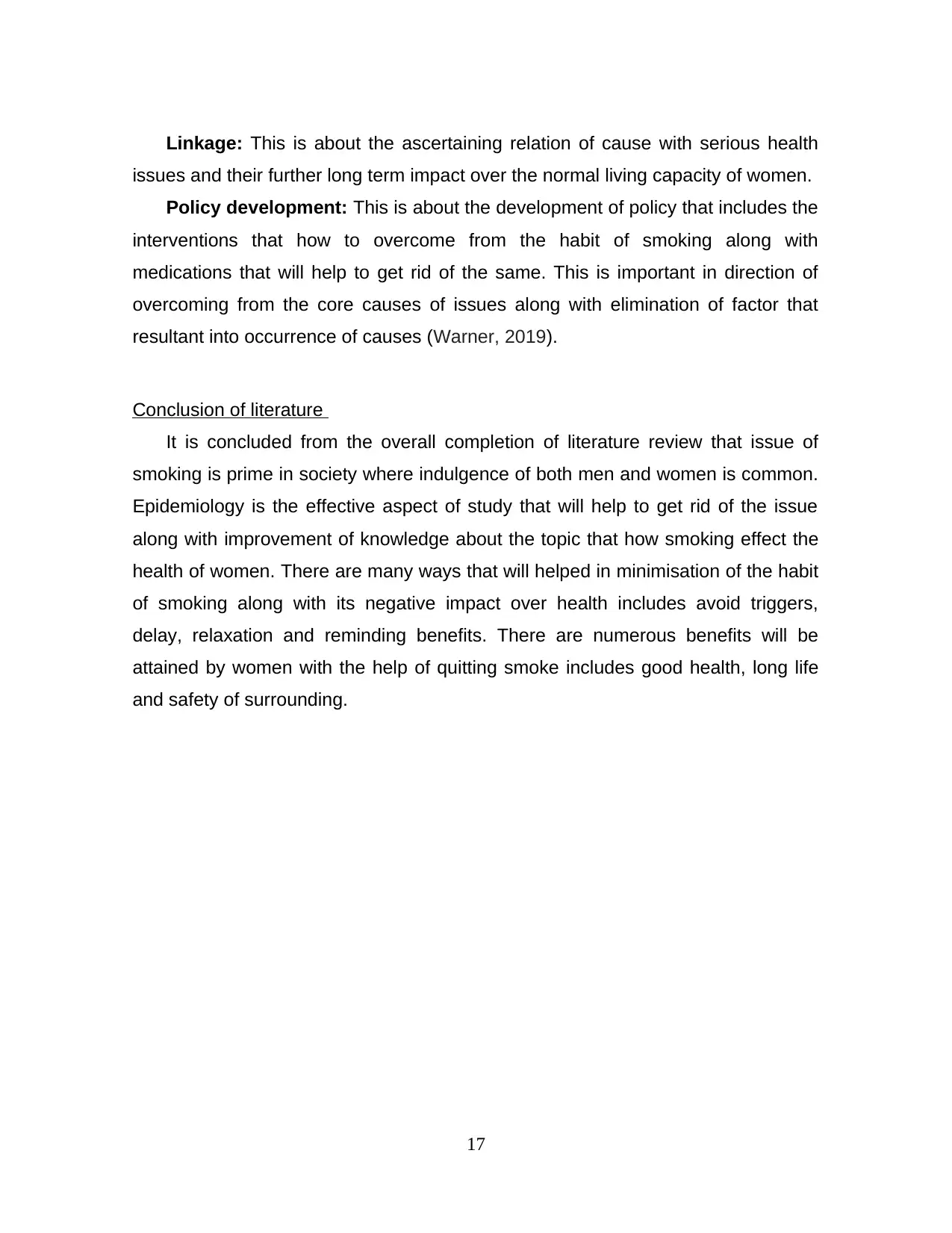
Linkage: This is about the ascertaining relation of cause with serious health
issues and their further long term impact over the normal living capacity of women.
Policy development: This is about the development of policy that includes the
interventions that how to overcome from the habit of smoking along with
medications that will help to get rid of the same. This is important in direction of
overcoming from the core causes of issues along with elimination of factor that
resultant into occurrence of causes (Warner, 2019).
Conclusion of literature
It is concluded from the overall completion of literature review that issue of
smoking is prime in society where indulgence of both men and women is common.
Epidemiology is the effective aspect of study that will help to get rid of the issue
along with improvement of knowledge about the topic that how smoking effect the
health of women. There are many ways that will helped in minimisation of the habit
of smoking along with its negative impact over health includes avoid triggers,
delay, relaxation and reminding benefits. There are numerous benefits will be
attained by women with the help of quitting smoke includes good health, long life
and safety of surrounding.
17
issues and their further long term impact over the normal living capacity of women.
Policy development: This is about the development of policy that includes the
interventions that how to overcome from the habit of smoking along with
medications that will help to get rid of the same. This is important in direction of
overcoming from the core causes of issues along with elimination of factor that
resultant into occurrence of causes (Warner, 2019).
Conclusion of literature
It is concluded from the overall completion of literature review that issue of
smoking is prime in society where indulgence of both men and women is common.
Epidemiology is the effective aspect of study that will help to get rid of the issue
along with improvement of knowledge about the topic that how smoking effect the
health of women. There are many ways that will helped in minimisation of the habit
of smoking along with its negative impact over health includes avoid triggers,
delay, relaxation and reminding benefits. There are numerous benefits will be
attained by women with the help of quitting smoke includes good health, long life
and safety of surrounding.
17
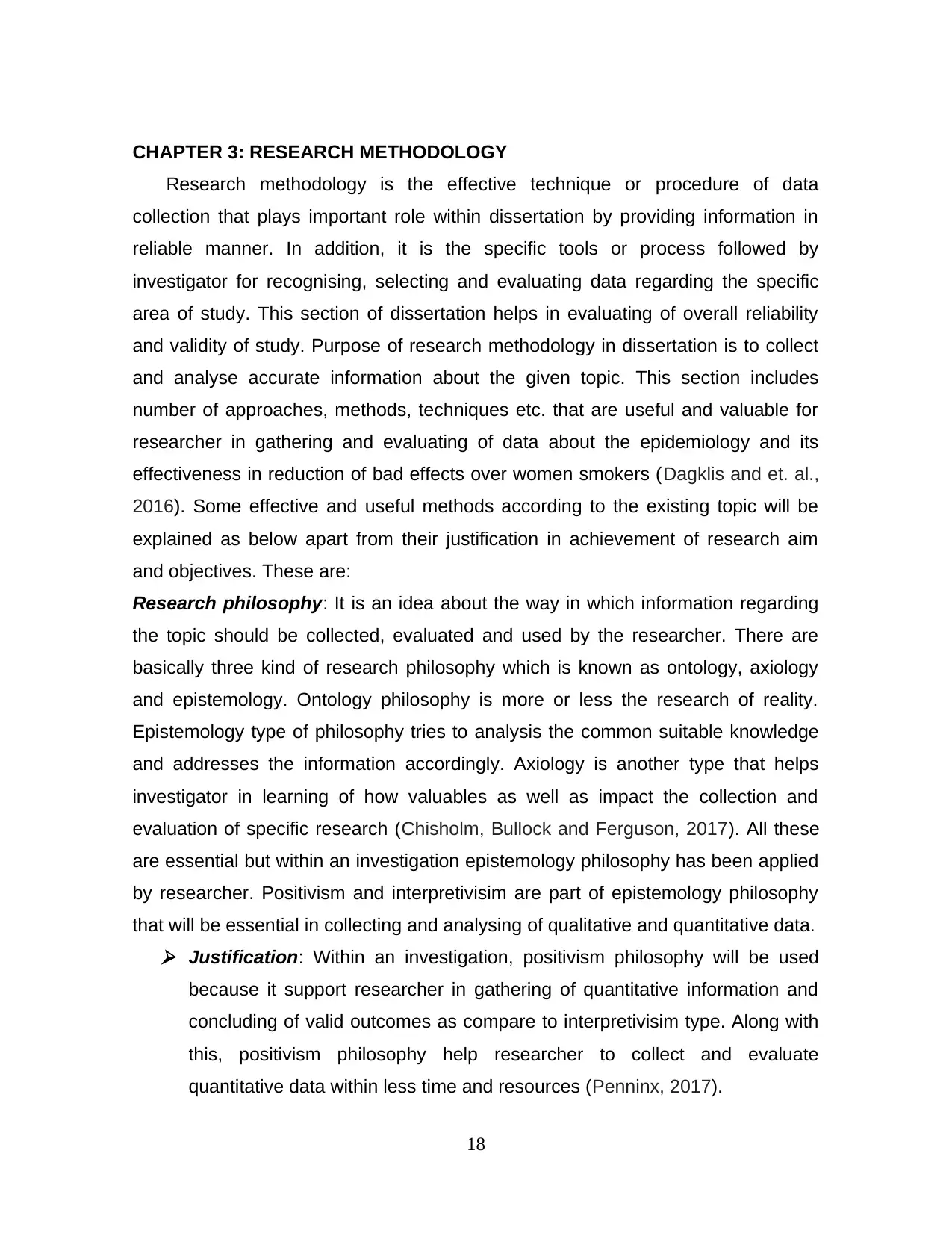
CHAPTER 3: RESEARCH METHODOLOGY
Research methodology is the effective technique or procedure of data
collection that plays important role within dissertation by providing information in
reliable manner. In addition, it is the specific tools or process followed by
investigator for recognising, selecting and evaluating data regarding the specific
area of study. This section of dissertation helps in evaluating of overall reliability
and validity of study. Purpose of research methodology in dissertation is to collect
and analyse accurate information about the given topic. This section includes
number of approaches, methods, techniques etc. that are useful and valuable for
researcher in gathering and evaluating of data about the epidemiology and its
effectiveness in reduction of bad effects over women smokers (Dagklis and et. al.,
2016). Some effective and useful methods according to the existing topic will be
explained as below apart from their justification in achievement of research aim
and objectives. These are:
Research philosophy: It is an idea about the way in which information regarding
the topic should be collected, evaluated and used by the researcher. There are
basically three kind of research philosophy which is known as ontology, axiology
and epistemology. Ontology philosophy is more or less the research of reality.
Epistemology type of philosophy tries to analysis the common suitable knowledge
and addresses the information accordingly. Axiology is another type that helps
investigator in learning of how valuables as well as impact the collection and
evaluation of specific research (Chisholm, Bullock and Ferguson, 2017). All these
are essential but within an investigation epistemology philosophy has been applied
by researcher. Positivism and interpretivisim are part of epistemology philosophy
that will be essential in collecting and analysing of qualitative and quantitative data.
Justification: Within an investigation, positivism philosophy will be used
because it support researcher in gathering of quantitative information and
concluding of valid outcomes as compare to interpretivisim type. Along with
this, positivism philosophy help researcher to collect and evaluate
quantitative data within less time and resources (Penninx, 2017).
18
Research methodology is the effective technique or procedure of data
collection that plays important role within dissertation by providing information in
reliable manner. In addition, it is the specific tools or process followed by
investigator for recognising, selecting and evaluating data regarding the specific
area of study. This section of dissertation helps in evaluating of overall reliability
and validity of study. Purpose of research methodology in dissertation is to collect
and analyse accurate information about the given topic. This section includes
number of approaches, methods, techniques etc. that are useful and valuable for
researcher in gathering and evaluating of data about the epidemiology and its
effectiveness in reduction of bad effects over women smokers (Dagklis and et. al.,
2016). Some effective and useful methods according to the existing topic will be
explained as below apart from their justification in achievement of research aim
and objectives. These are:
Research philosophy: It is an idea about the way in which information regarding
the topic should be collected, evaluated and used by the researcher. There are
basically three kind of research philosophy which is known as ontology, axiology
and epistemology. Ontology philosophy is more or less the research of reality.
Epistemology type of philosophy tries to analysis the common suitable knowledge
and addresses the information accordingly. Axiology is another type that helps
investigator in learning of how valuables as well as impact the collection and
evaluation of specific research (Chisholm, Bullock and Ferguson, 2017). All these
are essential but within an investigation epistemology philosophy has been applied
by researcher. Positivism and interpretivisim are part of epistemology philosophy
that will be essential in collecting and analysing of qualitative and quantitative data.
Justification: Within an investigation, positivism philosophy will be used
because it support researcher in gathering of quantitative information and
concluding of valid outcomes as compare to interpretivisim type. Along with
this, positivism philosophy help researcher to collect and evaluate
quantitative data within less time and resources (Penninx, 2017).
18
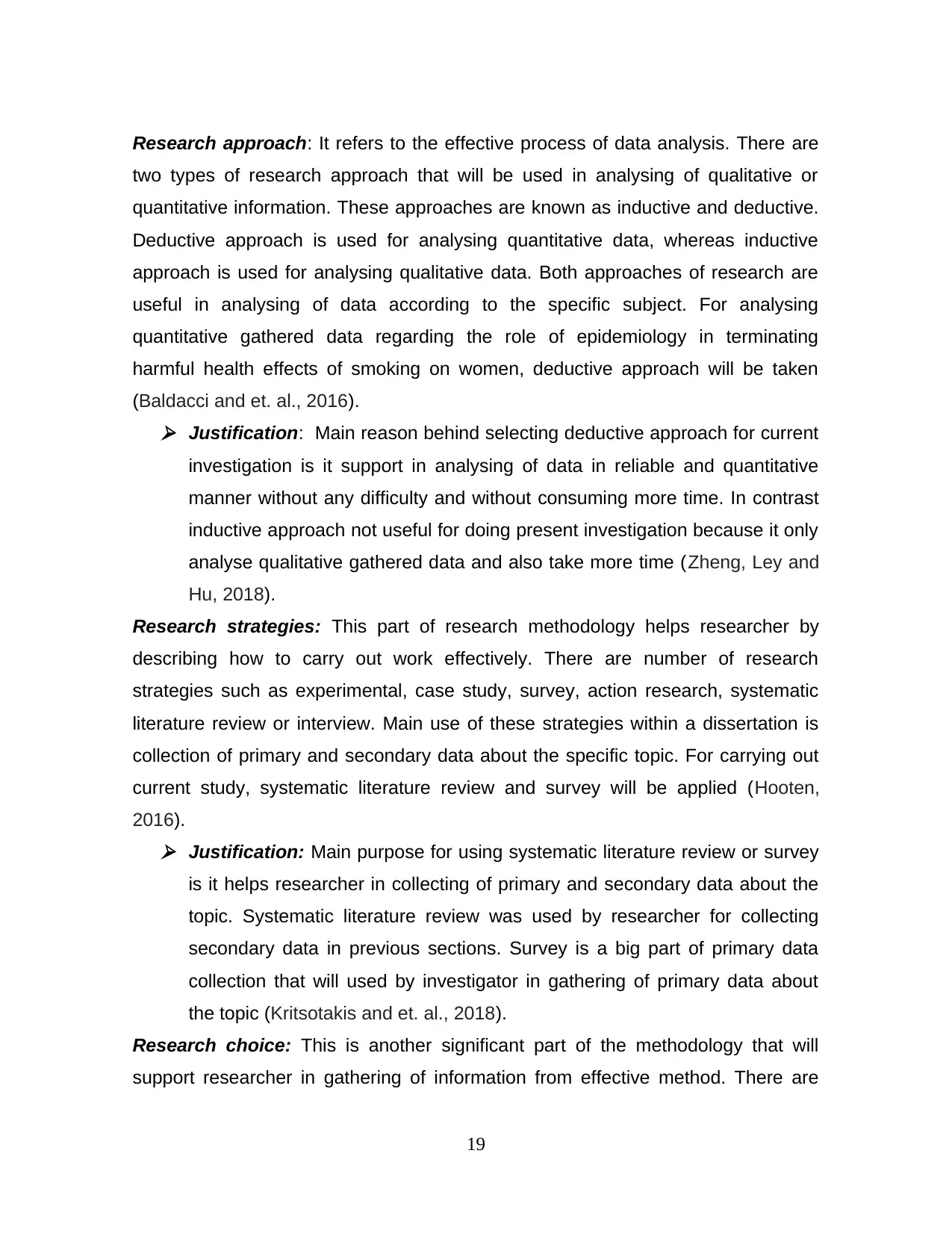
Research approach: It refers to the effective process of data analysis. There are
two types of research approach that will be used in analysing of qualitative or
quantitative information. These approaches are known as inductive and deductive.
Deductive approach is used for analysing quantitative data, whereas inductive
approach is used for analysing qualitative data. Both approaches of research are
useful in analysing of data according to the specific subject. For analysing
quantitative gathered data regarding the role of epidemiology in terminating
harmful health effects of smoking on women, deductive approach will be taken
(Baldacci and et. al., 2016).
Justification: Main reason behind selecting deductive approach for current
investigation is it support in analysing of data in reliable and quantitative
manner without any difficulty and without consuming more time. In contrast
inductive approach not useful for doing present investigation because it only
analyse qualitative gathered data and also take more time (Zheng, Ley and
Hu, 2018).
Research strategies: This part of research methodology helps researcher by
describing how to carry out work effectively. There are number of research
strategies such as experimental, case study, survey, action research, systematic
literature review or interview. Main use of these strategies within a dissertation is
collection of primary and secondary data about the specific topic. For carrying out
current study, systematic literature review and survey will be applied (Hooten,
2016).
Justification: Main purpose for using systematic literature review or survey
is it helps researcher in collecting of primary and secondary data about the
topic. Systematic literature review was used by researcher for collecting
secondary data in previous sections. Survey is a big part of primary data
collection that will used by investigator in gathering of primary data about
the topic (Kritsotakis and et. al., 2018).
Research choice: This is another significant part of the methodology that will
support researcher in gathering of information from effective method. There are
19
two types of research approach that will be used in analysing of qualitative or
quantitative information. These approaches are known as inductive and deductive.
Deductive approach is used for analysing quantitative data, whereas inductive
approach is used for analysing qualitative data. Both approaches of research are
useful in analysing of data according to the specific subject. For analysing
quantitative gathered data regarding the role of epidemiology in terminating
harmful health effects of smoking on women, deductive approach will be taken
(Baldacci and et. al., 2016).
Justification: Main reason behind selecting deductive approach for current
investigation is it support in analysing of data in reliable and quantitative
manner without any difficulty and without consuming more time. In contrast
inductive approach not useful for doing present investigation because it only
analyse qualitative gathered data and also take more time (Zheng, Ley and
Hu, 2018).
Research strategies: This part of research methodology helps researcher by
describing how to carry out work effectively. There are number of research
strategies such as experimental, case study, survey, action research, systematic
literature review or interview. Main use of these strategies within a dissertation is
collection of primary and secondary data about the specific topic. For carrying out
current study, systematic literature review and survey will be applied (Hooten,
2016).
Justification: Main purpose for using systematic literature review or survey
is it helps researcher in collecting of primary and secondary data about the
topic. Systematic literature review was used by researcher for collecting
secondary data in previous sections. Survey is a big part of primary data
collection that will used by investigator in gathering of primary data about
the topic (Kritsotakis and et. al., 2018).
Research choice: This is another significant part of the methodology that will
support researcher in gathering of information from effective method. There are
19
Paraphrase This Document
Need a fresh take? Get an instant paraphrase of this document with our AI Paraphraser
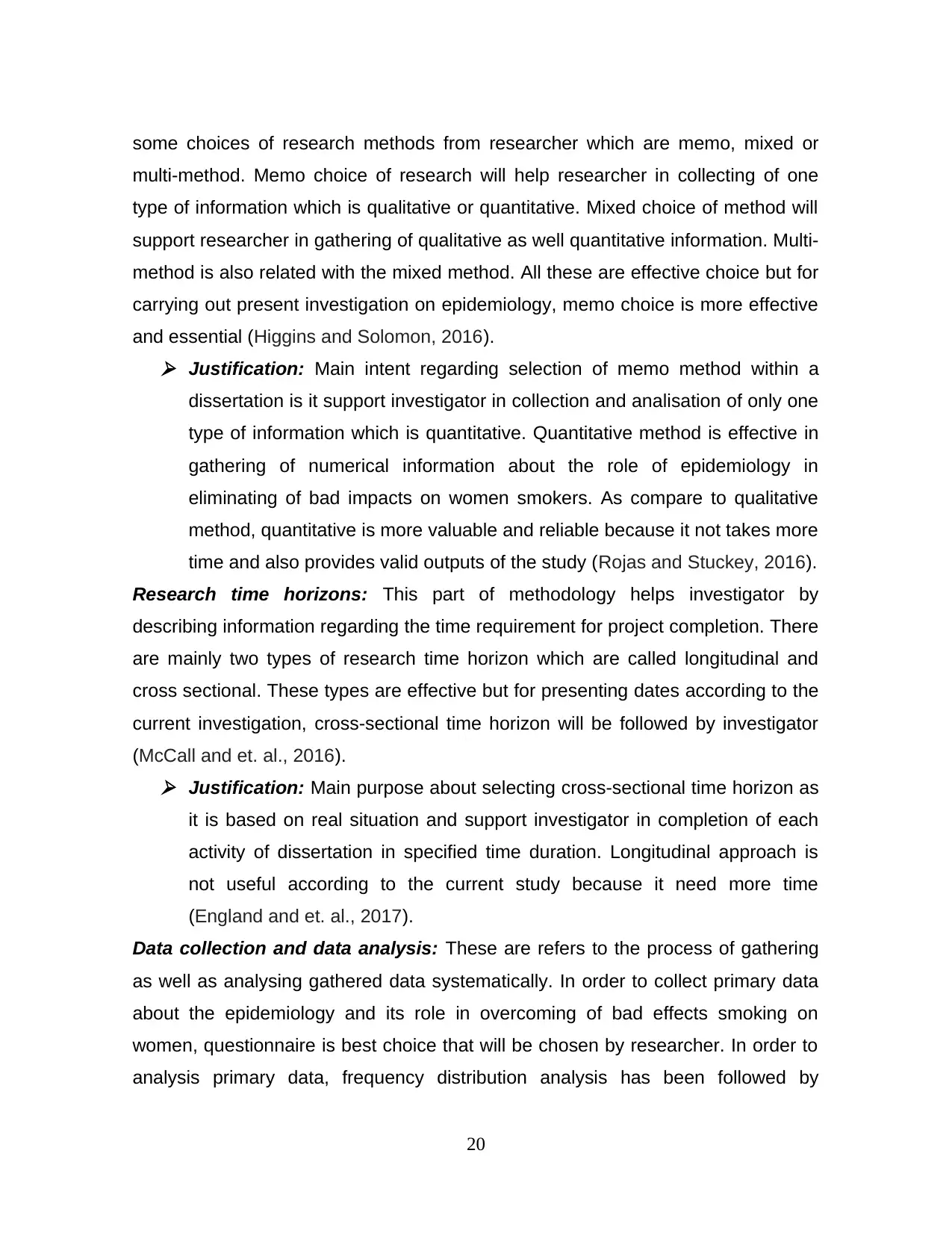
some choices of research methods from researcher which are memo, mixed or
multi-method. Memo choice of research will help researcher in collecting of one
type of information which is qualitative or quantitative. Mixed choice of method will
support researcher in gathering of qualitative as well quantitative information. Multi-
method is also related with the mixed method. All these are effective choice but for
carrying out present investigation on epidemiology, memo choice is more effective
and essential (Higgins and Solomon, 2016).
Justification: Main intent regarding selection of memo method within a
dissertation is it support investigator in collection and analisation of only one
type of information which is quantitative. Quantitative method is effective in
gathering of numerical information about the role of epidemiology in
eliminating of bad impacts on women smokers. As compare to qualitative
method, quantitative is more valuable and reliable because it not takes more
time and also provides valid outputs of the study (Rojas and Stuckey, 2016).
Research time horizons: This part of methodology helps investigator by
describing information regarding the time requirement for project completion. There
are mainly two types of research time horizon which are called longitudinal and
cross sectional. These types are effective but for presenting dates according to the
current investigation, cross-sectional time horizon will be followed by investigator
(McCall and et. al., 2016).
Justification: Main purpose about selecting cross-sectional time horizon as
it is based on real situation and support investigator in completion of each
activity of dissertation in specified time duration. Longitudinal approach is
not useful according to the current study because it need more time
(England and et. al., 2017).
Data collection and data analysis: These are refers to the process of gathering
as well as analysing gathered data systematically. In order to collect primary data
about the epidemiology and its role in overcoming of bad effects smoking on
women, questionnaire is best choice that will be chosen by researcher. In order to
analysis primary data, frequency distribution analysis has been followed by
20
multi-method. Memo choice of research will help researcher in collecting of one
type of information which is qualitative or quantitative. Mixed choice of method will
support researcher in gathering of qualitative as well quantitative information. Multi-
method is also related with the mixed method. All these are effective choice but for
carrying out present investigation on epidemiology, memo choice is more effective
and essential (Higgins and Solomon, 2016).
Justification: Main intent regarding selection of memo method within a
dissertation is it support investigator in collection and analisation of only one
type of information which is quantitative. Quantitative method is effective in
gathering of numerical information about the role of epidemiology in
eliminating of bad impacts on women smokers. As compare to qualitative
method, quantitative is more valuable and reliable because it not takes more
time and also provides valid outputs of the study (Rojas and Stuckey, 2016).
Research time horizons: This part of methodology helps investigator by
describing information regarding the time requirement for project completion. There
are mainly two types of research time horizon which are called longitudinal and
cross sectional. These types are effective but for presenting dates according to the
current investigation, cross-sectional time horizon will be followed by investigator
(McCall and et. al., 2016).
Justification: Main purpose about selecting cross-sectional time horizon as
it is based on real situation and support investigator in completion of each
activity of dissertation in specified time duration. Longitudinal approach is
not useful according to the current study because it need more time
(England and et. al., 2017).
Data collection and data analysis: These are refers to the process of gathering
as well as analysing gathered data systematically. In order to collect primary data
about the epidemiology and its role in overcoming of bad effects smoking on
women, questionnaire is best choice that will be chosen by researcher. In order to
analysis primary data, frequency distribution analysis has been followed by
20
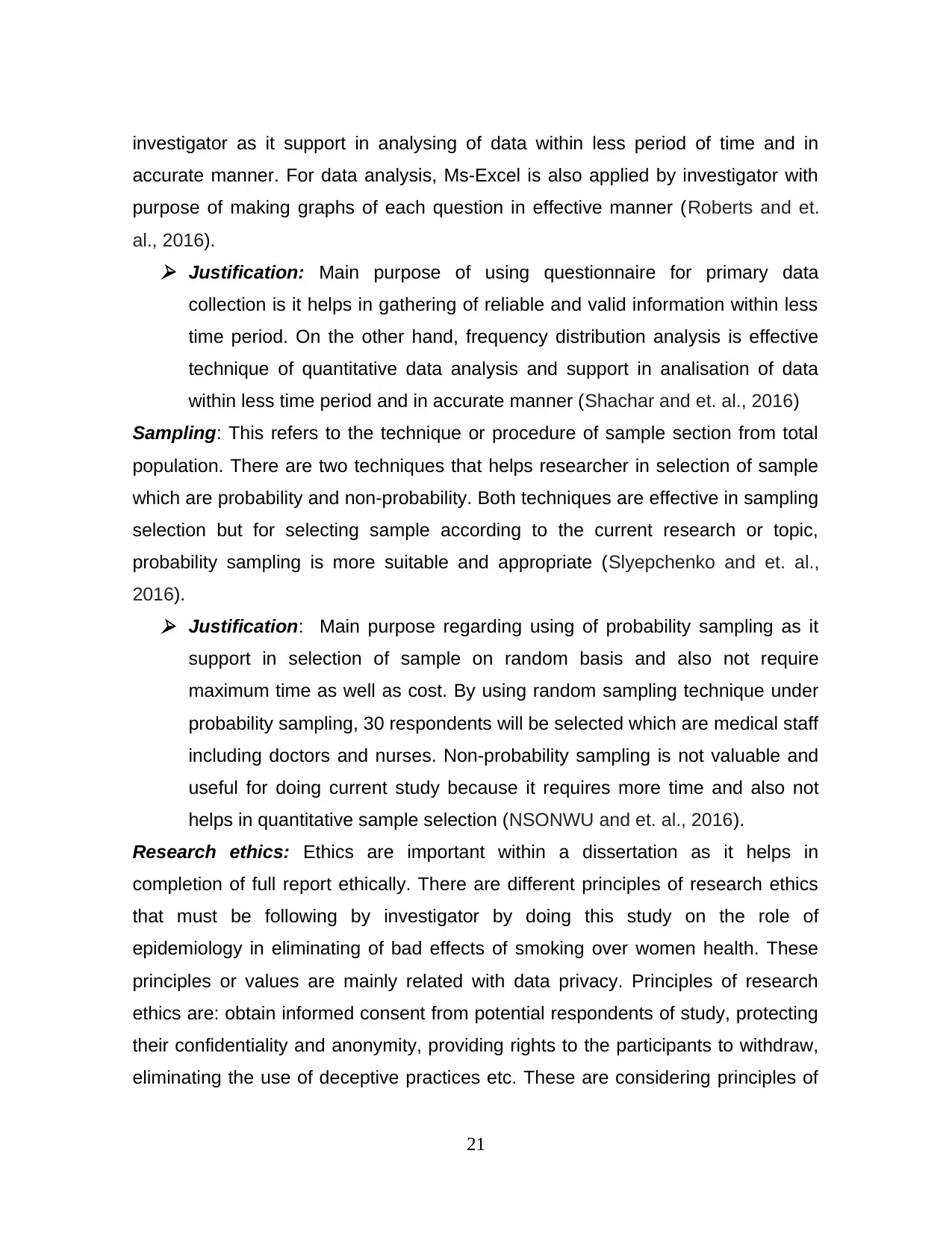
investigator as it support in analysing of data within less period of time and in
accurate manner. For data analysis, Ms-Excel is also applied by investigator with
purpose of making graphs of each question in effective manner (Roberts and et.
al., 2016).
Justification: Main purpose of using questionnaire for primary data
collection is it helps in gathering of reliable and valid information within less
time period. On the other hand, frequency distribution analysis is effective
technique of quantitative data analysis and support in analisation of data
within less time period and in accurate manner (Shachar and et. al., 2016)
Sampling: This refers to the technique or procedure of sample section from total
population. There are two techniques that helps researcher in selection of sample
which are probability and non-probability. Both techniques are effective in sampling
selection but for selecting sample according to the current research or topic,
probability sampling is more suitable and appropriate (Slyepchenko and et. al.,
2016).
Justification: Main purpose regarding using of probability sampling as it
support in selection of sample on random basis and also not require
maximum time as well as cost. By using random sampling technique under
probability sampling, 30 respondents will be selected which are medical staff
including doctors and nurses. Non-probability sampling is not valuable and
useful for doing current study because it requires more time and also not
helps in quantitative sample selection (NSONWU and et. al., 2016).
Research ethics: Ethics are important within a dissertation as it helps in
completion of full report ethically. There are different principles of research ethics
that must be following by investigator by doing this study on the role of
epidemiology in eliminating of bad effects of smoking over women health. These
principles or values are mainly related with data privacy. Principles of research
ethics are: obtain informed consent from potential respondents of study, protecting
their confidentiality and anonymity, providing rights to the participants to withdraw,
eliminating the use of deceptive practices etc. These are considering principles of
21
accurate manner. For data analysis, Ms-Excel is also applied by investigator with
purpose of making graphs of each question in effective manner (Roberts and et.
al., 2016).
Justification: Main purpose of using questionnaire for primary data
collection is it helps in gathering of reliable and valid information within less
time period. On the other hand, frequency distribution analysis is effective
technique of quantitative data analysis and support in analisation of data
within less time period and in accurate manner (Shachar and et. al., 2016)
Sampling: This refers to the technique or procedure of sample section from total
population. There are two techniques that helps researcher in selection of sample
which are probability and non-probability. Both techniques are effective in sampling
selection but for selecting sample according to the current research or topic,
probability sampling is more suitable and appropriate (Slyepchenko and et. al.,
2016).
Justification: Main purpose regarding using of probability sampling as it
support in selection of sample on random basis and also not require
maximum time as well as cost. By using random sampling technique under
probability sampling, 30 respondents will be selected which are medical staff
including doctors and nurses. Non-probability sampling is not valuable and
useful for doing current study because it requires more time and also not
helps in quantitative sample selection (NSONWU and et. al., 2016).
Research ethics: Ethics are important within a dissertation as it helps in
completion of full report ethically. There are different principles of research ethics
that must be following by investigator by doing this study on the role of
epidemiology in eliminating of bad effects of smoking over women health. These
principles or values are mainly related with data privacy. Principles of research
ethics are: obtain informed consent from potential respondents of study, protecting
their confidentiality and anonymity, providing rights to the participants to withdraw,
eliminating the use of deceptive practices etc. These are considering principles of
21

research ethics that must be use by researcher because this will support them in
completing of full dissertation ethically, systematically and effectively
(Nordestgaard, 2016).
Research reliability and validity of study: This is another important part of
methodology that helps investigator in testing of validity as well as reliability of
study or data. It is important for researcher in achieving of research aim and
objectives easily. For testing of validity and reliability of data, questionnaire is more
effective and suitable technique. It will helps investigator by providing quantitative
and primary information within minimum time duration in reliable manner.
Therefore, questionnaire is essential and useful technique for researcher in
gathering of valid and reliable data regarding the epidemiology and its importance
in eliminating of smoking’s bad or negative effects over the health of women
(Mygind and et. al., 2016).
Therefore, above mentioned all methods and approaches are useful for
researcher in collecting and analysing of accurate and reliable information
regarding the epidemiology and its role and importance in reduction of negative
impact of smoking on women. Quantitative approach is more useful within an
investigation because it support investigator in collecting as well as analysing of
information within less time duration and in numerical form. This method also
supported researcher in concluding of valid and reliable research outcomes. The
respondents are people of age group 15 – 30 who are more prone towards getting
attracted to cigerrete smoking. This is an online survey which participants are send
for filling it and sending back to the investigator (Saleh and Bista, 2017).
CHAPTER 4: DATA ANALYSIS/RESULTS AND DISCUSSION
Data analysis introduces to the effective process of analysing data regarding
the topic and gaining valid outcomes within less time duration. Data analysis will
support researcher in analysing of qualitative or quantitative information. Current
dissertation is based on quantitative type of research and for analysing such
information; frequency distribution analysis will be used as an effective type of
analytical tool. In this tool, researcher will require to make frequency table and then
22
completing of full dissertation ethically, systematically and effectively
(Nordestgaard, 2016).
Research reliability and validity of study: This is another important part of
methodology that helps investigator in testing of validity as well as reliability of
study or data. It is important for researcher in achieving of research aim and
objectives easily. For testing of validity and reliability of data, questionnaire is more
effective and suitable technique. It will helps investigator by providing quantitative
and primary information within minimum time duration in reliable manner.
Therefore, questionnaire is essential and useful technique for researcher in
gathering of valid and reliable data regarding the epidemiology and its importance
in eliminating of smoking’s bad or negative effects over the health of women
(Mygind and et. al., 2016).
Therefore, above mentioned all methods and approaches are useful for
researcher in collecting and analysing of accurate and reliable information
regarding the epidemiology and its role and importance in reduction of negative
impact of smoking on women. Quantitative approach is more useful within an
investigation because it support investigator in collecting as well as analysing of
information within less time duration and in numerical form. This method also
supported researcher in concluding of valid and reliable research outcomes. The
respondents are people of age group 15 – 30 who are more prone towards getting
attracted to cigerrete smoking. This is an online survey which participants are send
for filling it and sending back to the investigator (Saleh and Bista, 2017).
CHAPTER 4: DATA ANALYSIS/RESULTS AND DISCUSSION
Data analysis introduces to the effective process of analysing data regarding
the topic and gaining valid outcomes within less time duration. Data analysis will
support researcher in analysing of qualitative or quantitative information. Current
dissertation is based on quantitative type of research and for analysing such
information; frequency distribution analysis will be used as an effective type of
analytical tool. In this tool, researcher will require to make frequency table and then
22
Secure Best Marks with AI Grader
Need help grading? Try our AI Grader for instant feedback on your assignments.
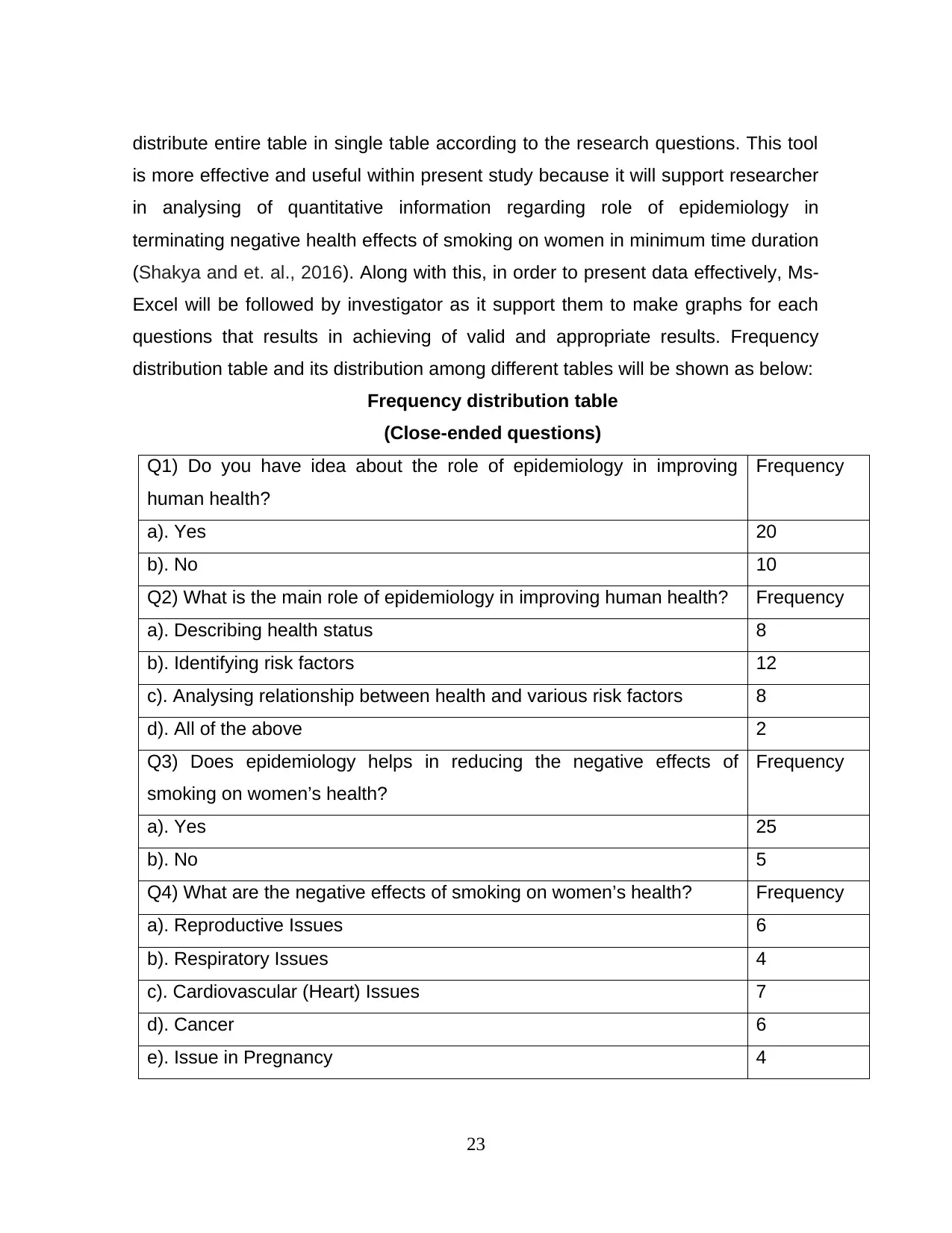
distribute entire table in single table according to the research questions. This tool
is more effective and useful within present study because it will support researcher
in analysing of quantitative information regarding role of epidemiology in
terminating negative health effects of smoking on women in minimum time duration
(Shakya and et. al., 2016). Along with this, in order to present data effectively, Ms-
Excel will be followed by investigator as it support them to make graphs for each
questions that results in achieving of valid and appropriate results. Frequency
distribution table and its distribution among different tables will be shown as below:
Frequency distribution table
(Close-ended questions)
Q1) Do you have idea about the role of epidemiology in improving
human health?
Frequency
a). Yes 20
b). No 10
Q2) What is the main role of epidemiology in improving human health? Frequency
a). Describing health status 8
b). Identifying risk factors 12
c). Analysing relationship between health and various risk factors 8
d). All of the above 2
Q3) Does epidemiology helps in reducing the negative effects of
smoking on women’s health?
Frequency
a). Yes 25
b). No 5
Q4) What are the negative effects of smoking on women’s health? Frequency
a). Reproductive Issues 6
b). Respiratory Issues 4
c). Cardiovascular (Heart) Issues 7
d). Cancer 6
e). Issue in Pregnancy 4
23
is more effective and useful within present study because it will support researcher
in analysing of quantitative information regarding role of epidemiology in
terminating negative health effects of smoking on women in minimum time duration
(Shakya and et. al., 2016). Along with this, in order to present data effectively, Ms-
Excel will be followed by investigator as it support them to make graphs for each
questions that results in achieving of valid and appropriate results. Frequency
distribution table and its distribution among different tables will be shown as below:
Frequency distribution table
(Close-ended questions)
Q1) Do you have idea about the role of epidemiology in improving
human health?
Frequency
a). Yes 20
b). No 10
Q2) What is the main role of epidemiology in improving human health? Frequency
a). Describing health status 8
b). Identifying risk factors 12
c). Analysing relationship between health and various risk factors 8
d). All of the above 2
Q3) Does epidemiology helps in reducing the negative effects of
smoking on women’s health?
Frequency
a). Yes 25
b). No 5
Q4) What are the negative effects of smoking on women’s health? Frequency
a). Reproductive Issues 6
b). Respiratory Issues 4
c). Cardiovascular (Heart) Issues 7
d). Cancer 6
e). Issue in Pregnancy 4
23
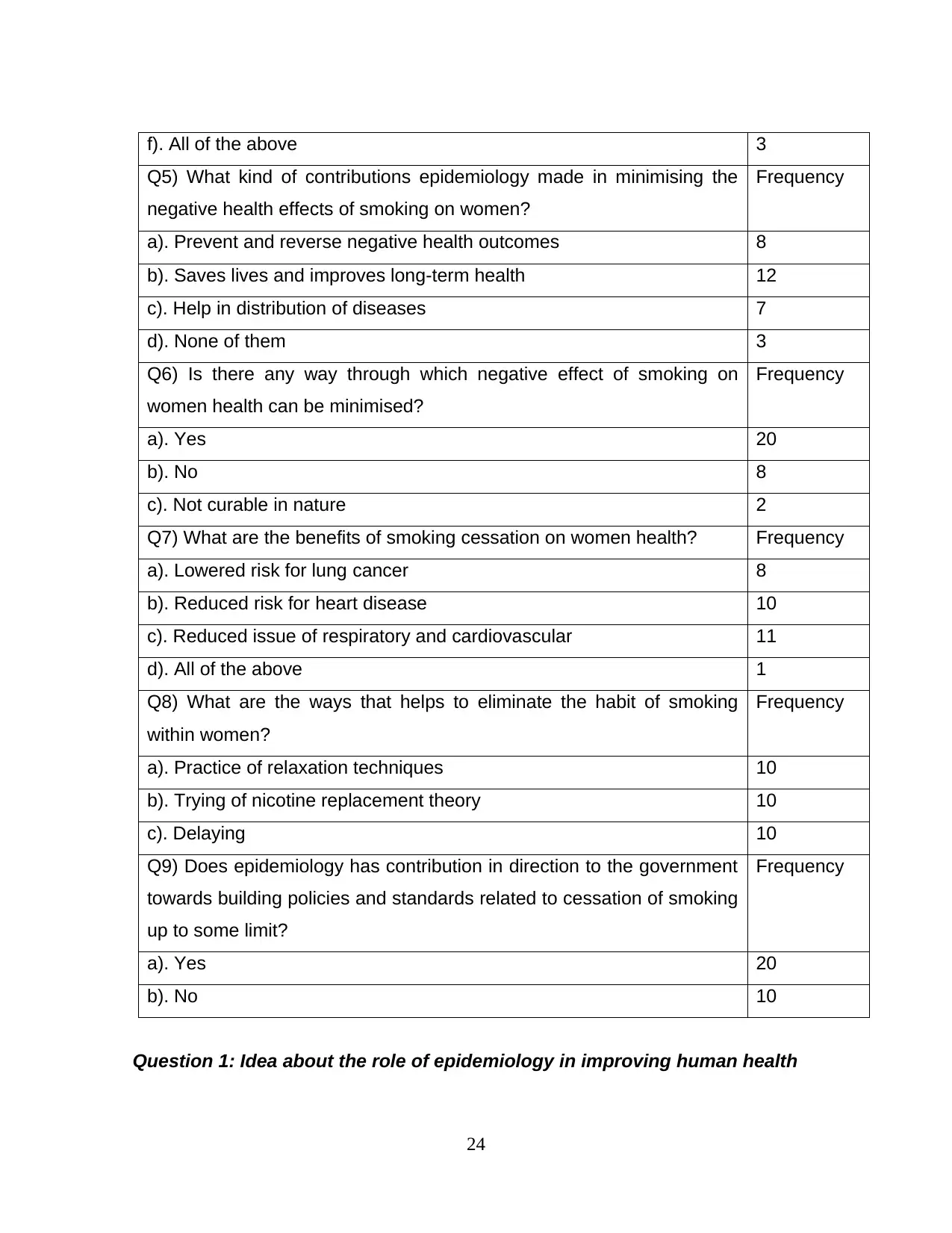
f). All of the above 3
Q5) What kind of contributions epidemiology made in minimising the
negative health effects of smoking on women?
Frequency
a). Prevent and reverse negative health outcomes 8
b). Saves lives and improves long-term health 12
c). Help in distribution of diseases 7
d). None of them 3
Q6) Is there any way through which negative effect of smoking on
women health can be minimised?
Frequency
a). Yes 20
b). No 8
c). Not curable in nature 2
Q7) What are the benefits of smoking cessation on women health? Frequency
a). Lowered risk for lung cancer 8
b). Reduced risk for heart disease 10
c). Reduced issue of respiratory and cardiovascular 11
d). All of the above 1
Q8) What are the ways that helps to eliminate the habit of smoking
within women?
Frequency
a). Practice of relaxation techniques 10
b). Trying of nicotine replacement theory 10
c). Delaying 10
Q9) Does epidemiology has contribution in direction to the government
towards building policies and standards related to cessation of smoking
up to some limit?
Frequency
a). Yes 20
b). No 10
Question 1: Idea about the role of epidemiology in improving human health
24
Q5) What kind of contributions epidemiology made in minimising the
negative health effects of smoking on women?
Frequency
a). Prevent and reverse negative health outcomes 8
b). Saves lives and improves long-term health 12
c). Help in distribution of diseases 7
d). None of them 3
Q6) Is there any way through which negative effect of smoking on
women health can be minimised?
Frequency
a). Yes 20
b). No 8
c). Not curable in nature 2
Q7) What are the benefits of smoking cessation on women health? Frequency
a). Lowered risk for lung cancer 8
b). Reduced risk for heart disease 10
c). Reduced issue of respiratory and cardiovascular 11
d). All of the above 1
Q8) What are the ways that helps to eliminate the habit of smoking
within women?
Frequency
a). Practice of relaxation techniques 10
b). Trying of nicotine replacement theory 10
c). Delaying 10
Q9) Does epidemiology has contribution in direction to the government
towards building policies and standards related to cessation of smoking
up to some limit?
Frequency
a). Yes 20
b). No 10
Question 1: Idea about the role of epidemiology in improving human health
24

Q1) Do you have idea about the role of epidemiology in improving
human health?
Frequency
a). Yes 20
b). No 10
Interpretation: It has been concluded that majority of respondents had idea
regarding the epidemiology and its role in improvement of human health. They
said, epidemiology is the study and evaluation of the distribution, determinates and
patterns of health and diseases disorder in defined populations. They also have
idea as it is a branch of medicine that plays an important role by improving their
health conditions effectively. Remaining 10 respondents don’t have any idea or
knowledge regarding the same concept.
Question 2: Main role of epidemiology
Q2) What is the main role of epidemiology in improving human health? Frequency
a). Describing health status 8
b). Identifying risk factors 12
c). Analysing relationship between health and various risk factors 8
d). All of the above 2
25
human health?
Frequency
a). Yes 20
b). No 10
Interpretation: It has been concluded that majority of respondents had idea
regarding the epidemiology and its role in improvement of human health. They
said, epidemiology is the study and evaluation of the distribution, determinates and
patterns of health and diseases disorder in defined populations. They also have
idea as it is a branch of medicine that plays an important role by improving their
health conditions effectively. Remaining 10 respondents don’t have any idea or
knowledge regarding the same concept.
Question 2: Main role of epidemiology
Q2) What is the main role of epidemiology in improving human health? Frequency
a). Describing health status 8
b). Identifying risk factors 12
c). Analysing relationship between health and various risk factors 8
d). All of the above 2
25
Paraphrase This Document
Need a fresh take? Get an instant paraphrase of this document with our AI Paraphraser

Interpretation: From the above graph, it has been shown number of roles
played by epidemiology in case of human health. 8 out of 30 medical staff’s had
knowledge as epidemiology helps an individual by describing health status that
results in improved health. 12 had opinion as; it identified risk factors impacted on
human health. This will help an individual in primary stage of diseases to tack
treatment and overcome negative effect of any kind of diseases effectively. 8
participants have knowledge as, it analysed relationship between health and
various risk factors by collecting and analysing information to determine who is at
the greater risk for a specific disease. Remaining 2 respondents are favoured
about all points are main role of epidemiology.
Question 3: Effectiveness of epidemiology in reduction of smoking
Q3) Does epidemiology helps in reducing the negative effects of
smoking on women’s health?
Frequency
a). Yes 25
b). No 5
26
played by epidemiology in case of human health. 8 out of 30 medical staff’s had
knowledge as epidemiology helps an individual by describing health status that
results in improved health. 12 had opinion as; it identified risk factors impacted on
human health. This will help an individual in primary stage of diseases to tack
treatment and overcome negative effect of any kind of diseases effectively. 8
participants have knowledge as, it analysed relationship between health and
various risk factors by collecting and analysing information to determine who is at
the greater risk for a specific disease. Remaining 2 respondents are favoured
about all points are main role of epidemiology.
Question 3: Effectiveness of epidemiology in reduction of smoking
Q3) Does epidemiology helps in reducing the negative effects of
smoking on women’s health?
Frequency
a). Yes 25
b). No 5
26
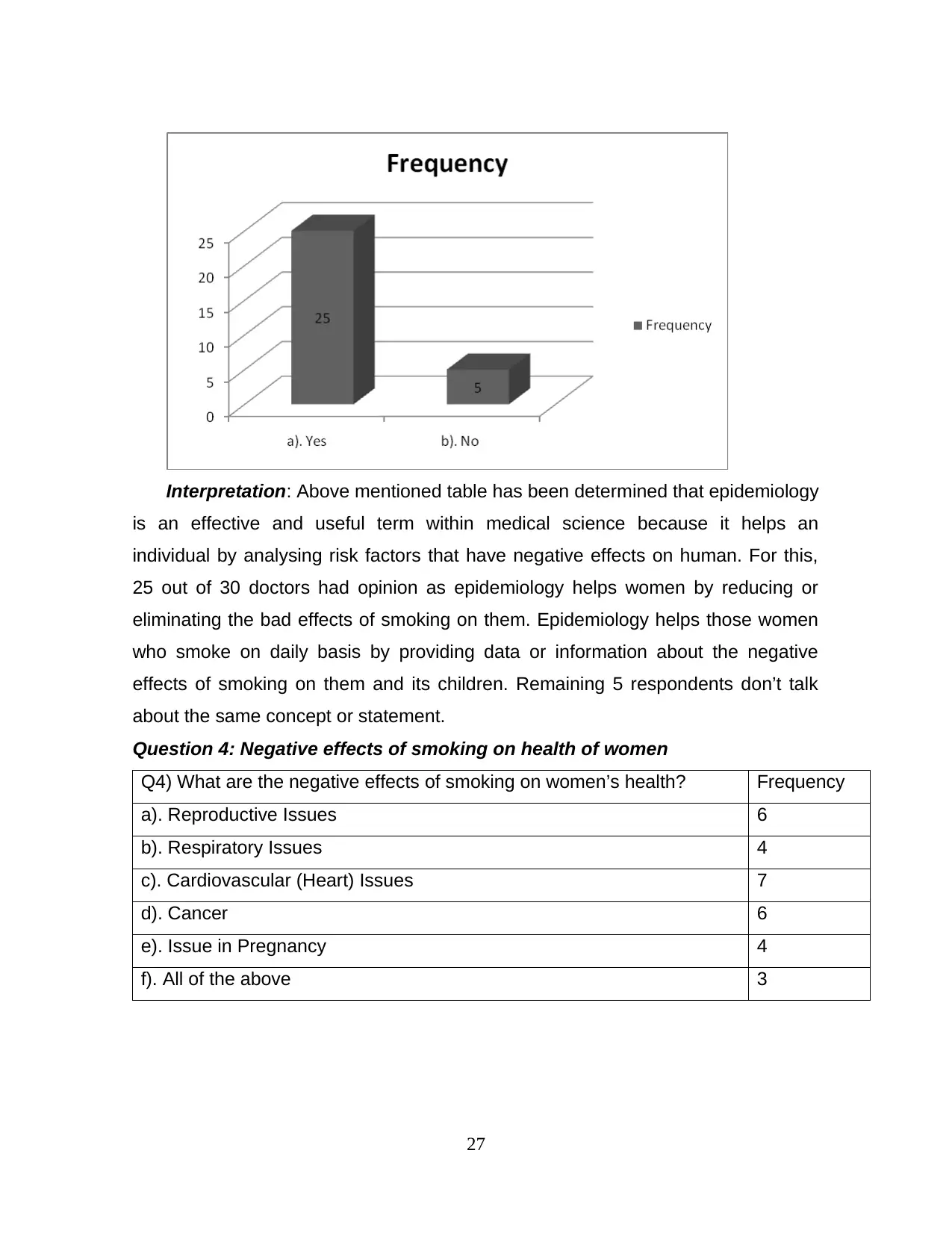
Interpretation: Above mentioned table has been determined that epidemiology
is an effective and useful term within medical science because it helps an
individual by analysing risk factors that have negative effects on human. For this,
25 out of 30 doctors had opinion as epidemiology helps women by reducing or
eliminating the bad effects of smoking on them. Epidemiology helps those women
who smoke on daily basis by providing data or information about the negative
effects of smoking on them and its children. Remaining 5 respondents don’t talk
about the same concept or statement.
Question 4: Negative effects of smoking on health of women
Q4) What are the negative effects of smoking on women’s health? Frequency
a). Reproductive Issues 6
b). Respiratory Issues 4
c). Cardiovascular (Heart) Issues 7
d). Cancer 6
e). Issue in Pregnancy 4
f). All of the above 3
27
is an effective and useful term within medical science because it helps an
individual by analysing risk factors that have negative effects on human. For this,
25 out of 30 doctors had opinion as epidemiology helps women by reducing or
eliminating the bad effects of smoking on them. Epidemiology helps those women
who smoke on daily basis by providing data or information about the negative
effects of smoking on them and its children. Remaining 5 respondents don’t talk
about the same concept or statement.
Question 4: Negative effects of smoking on health of women
Q4) What are the negative effects of smoking on women’s health? Frequency
a). Reproductive Issues 6
b). Respiratory Issues 4
c). Cardiovascular (Heart) Issues 7
d). Cancer 6
e). Issue in Pregnancy 4
f). All of the above 3
27
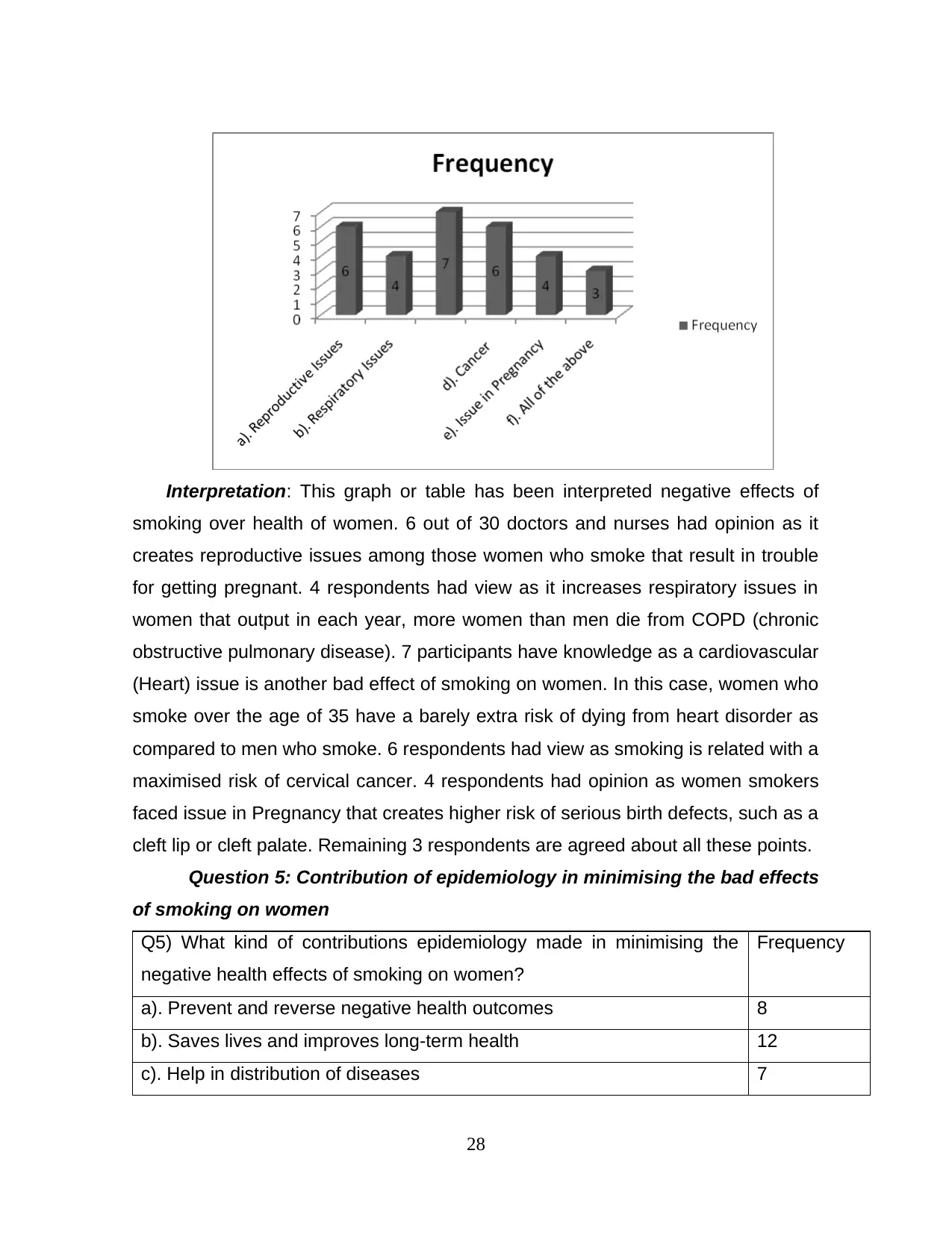
Interpretation: This graph or table has been interpreted negative effects of
smoking over health of women. 6 out of 30 doctors and nurses had opinion as it
creates reproductive issues among those women who smoke that result in trouble
for getting pregnant. 4 respondents had view as it increases respiratory issues in
women that output in each year, more women than men die from COPD (chronic
obstructive pulmonary disease). 7 participants have knowledge as a cardiovascular
(Heart) issue is another bad effect of smoking on women. In this case, women who
smoke over the age of 35 have a barely extra risk of dying from heart disorder as
compared to men who smoke. 6 respondents had view as smoking is related with a
maximised risk of cervical cancer. 4 respondents had opinion as women smokers
faced issue in Pregnancy that creates higher risk of serious birth defects, such as a
cleft lip or cleft palate. Remaining 3 respondents are agreed about all these points.
Question 5: Contribution of epidemiology in minimising the bad effects
of smoking on women
Q5) What kind of contributions epidemiology made in minimising the
negative health effects of smoking on women?
Frequency
a). Prevent and reverse negative health outcomes 8
b). Saves lives and improves long-term health 12
c). Help in distribution of diseases 7
28
smoking over health of women. 6 out of 30 doctors and nurses had opinion as it
creates reproductive issues among those women who smoke that result in trouble
for getting pregnant. 4 respondents had view as it increases respiratory issues in
women that output in each year, more women than men die from COPD (chronic
obstructive pulmonary disease). 7 participants have knowledge as a cardiovascular
(Heart) issue is another bad effect of smoking on women. In this case, women who
smoke over the age of 35 have a barely extra risk of dying from heart disorder as
compared to men who smoke. 6 respondents had view as smoking is related with a
maximised risk of cervical cancer. 4 respondents had opinion as women smokers
faced issue in Pregnancy that creates higher risk of serious birth defects, such as a
cleft lip or cleft palate. Remaining 3 respondents are agreed about all these points.
Question 5: Contribution of epidemiology in minimising the bad effects
of smoking on women
Q5) What kind of contributions epidemiology made in minimising the
negative health effects of smoking on women?
Frequency
a). Prevent and reverse negative health outcomes 8
b). Saves lives and improves long-term health 12
c). Help in distribution of diseases 7
28
Secure Best Marks with AI Grader
Need help grading? Try our AI Grader for instant feedback on your assignments.
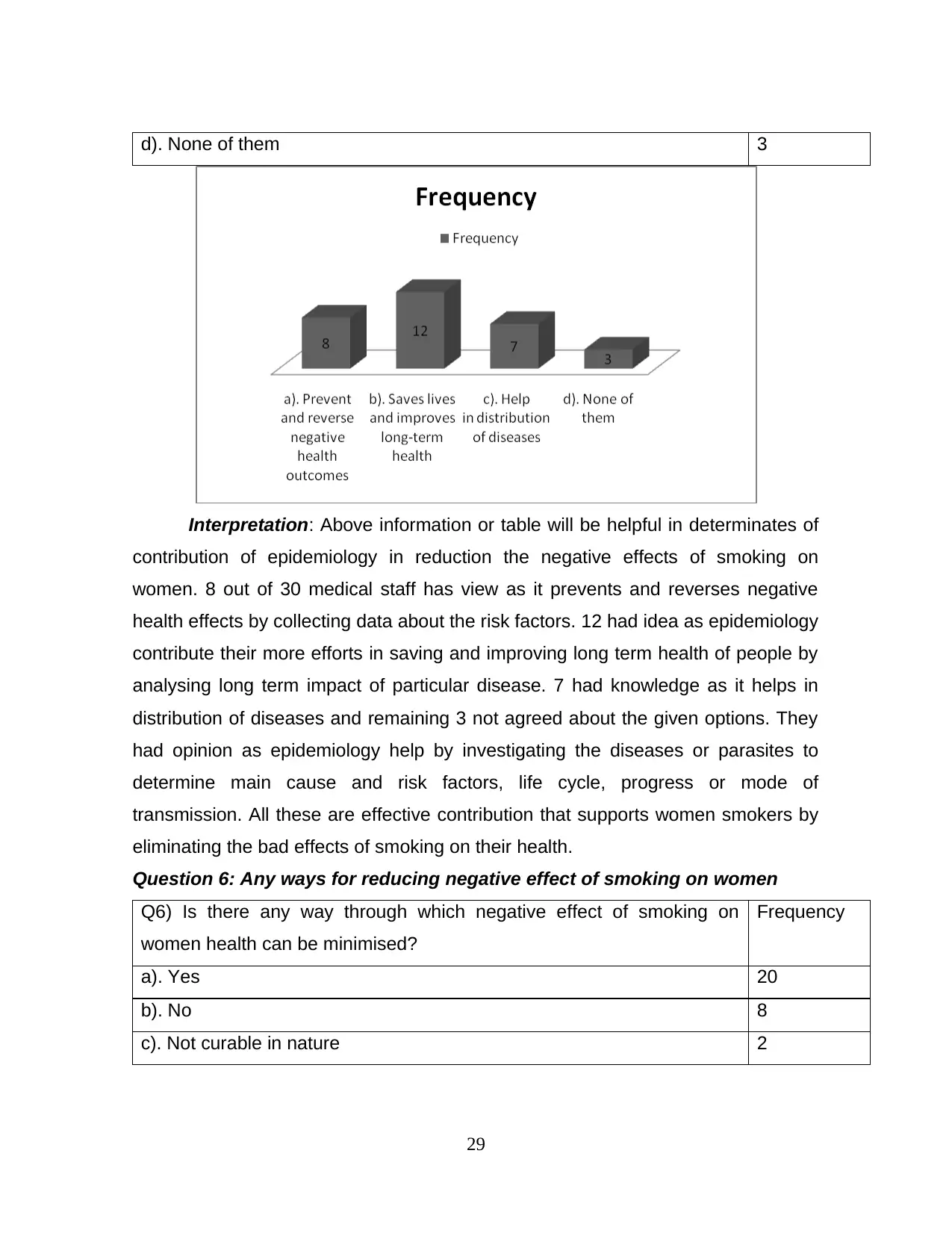
d). None of them 3
Interpretation: Above information or table will be helpful in determinates of
contribution of epidemiology in reduction the negative effects of smoking on
women. 8 out of 30 medical staff has view as it prevents and reverses negative
health effects by collecting data about the risk factors. 12 had idea as epidemiology
contribute their more efforts in saving and improving long term health of people by
analysing long term impact of particular disease. 7 had knowledge as it helps in
distribution of diseases and remaining 3 not agreed about the given options. They
had opinion as epidemiology help by investigating the diseases or parasites to
determine main cause and risk factors, life cycle, progress or mode of
transmission. All these are effective contribution that supports women smokers by
eliminating the bad effects of smoking on their health.
Question 6: Any ways for reducing negative effect of smoking on women
Q6) Is there any way through which negative effect of smoking on
women health can be minimised?
Frequency
a). Yes 20
b). No 8
c). Not curable in nature 2
29
Interpretation: Above information or table will be helpful in determinates of
contribution of epidemiology in reduction the negative effects of smoking on
women. 8 out of 30 medical staff has view as it prevents and reverses negative
health effects by collecting data about the risk factors. 12 had idea as epidemiology
contribute their more efforts in saving and improving long term health of people by
analysing long term impact of particular disease. 7 had knowledge as it helps in
distribution of diseases and remaining 3 not agreed about the given options. They
had opinion as epidemiology help by investigating the diseases or parasites to
determine main cause and risk factors, life cycle, progress or mode of
transmission. All these are effective contribution that supports women smokers by
eliminating the bad effects of smoking on their health.
Question 6: Any ways for reducing negative effect of smoking on women
Q6) Is there any way through which negative effect of smoking on
women health can be minimised?
Frequency
a). Yes 20
b). No 8
c). Not curable in nature 2
29
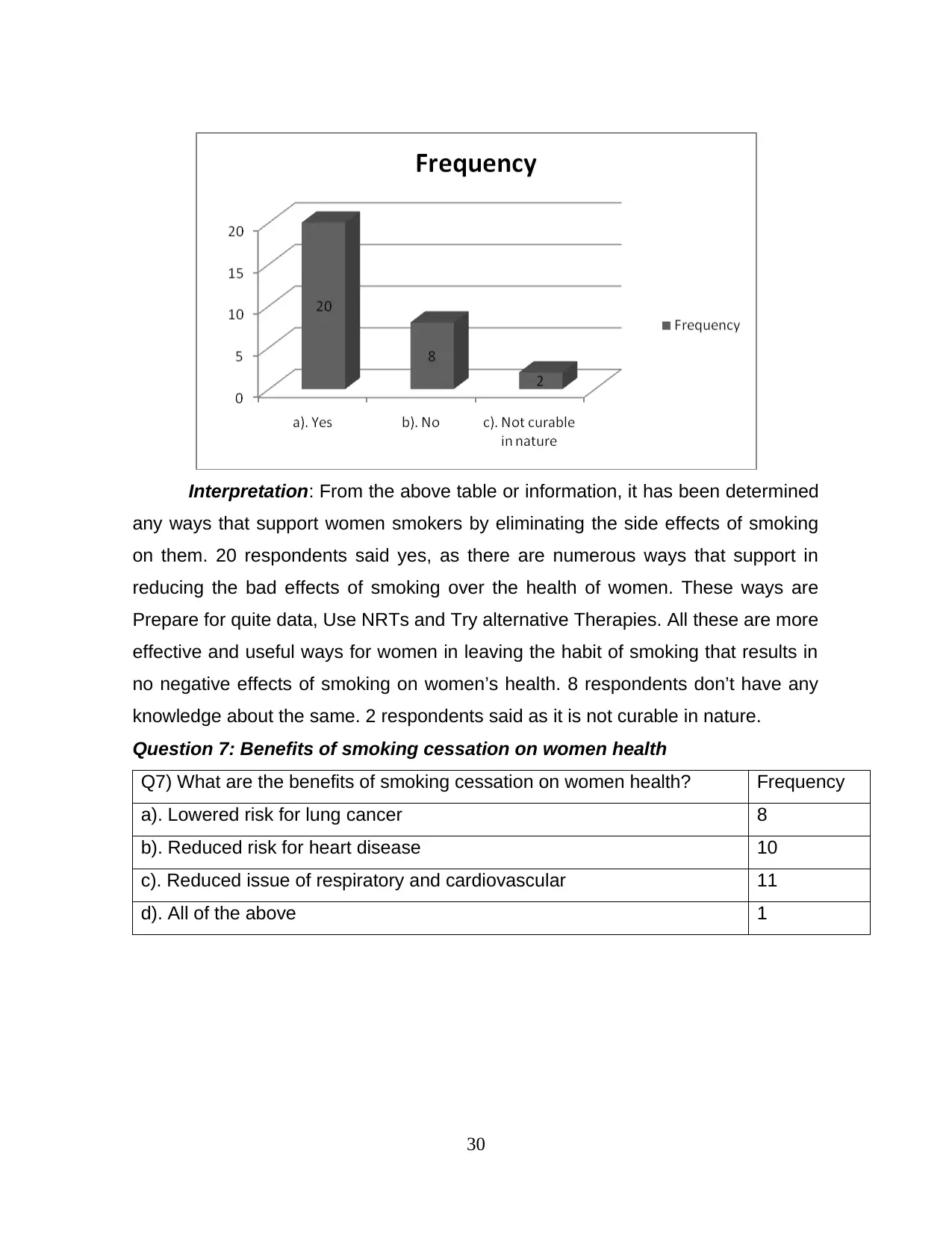
Interpretation: From the above table or information, it has been determined
any ways that support women smokers by eliminating the side effects of smoking
on them. 20 respondents said yes, as there are numerous ways that support in
reducing the bad effects of smoking over the health of women. These ways are
Prepare for quite data, Use NRTs and Try alternative Therapies. All these are more
effective and useful ways for women in leaving the habit of smoking that results in
no negative effects of smoking on women’s health. 8 respondents don’t have any
knowledge about the same. 2 respondents said as it is not curable in nature.
Question 7: Benefits of smoking cessation on women health
Q7) What are the benefits of smoking cessation on women health? Frequency
a). Lowered risk for lung cancer 8
b). Reduced risk for heart disease 10
c). Reduced issue of respiratory and cardiovascular 11
d). All of the above 1
30
any ways that support women smokers by eliminating the side effects of smoking
on them. 20 respondents said yes, as there are numerous ways that support in
reducing the bad effects of smoking over the health of women. These ways are
Prepare for quite data, Use NRTs and Try alternative Therapies. All these are more
effective and useful ways for women in leaving the habit of smoking that results in
no negative effects of smoking on women’s health. 8 respondents don’t have any
knowledge about the same. 2 respondents said as it is not curable in nature.
Question 7: Benefits of smoking cessation on women health
Q7) What are the benefits of smoking cessation on women health? Frequency
a). Lowered risk for lung cancer 8
b). Reduced risk for heart disease 10
c). Reduced issue of respiratory and cardiovascular 11
d). All of the above 1
30
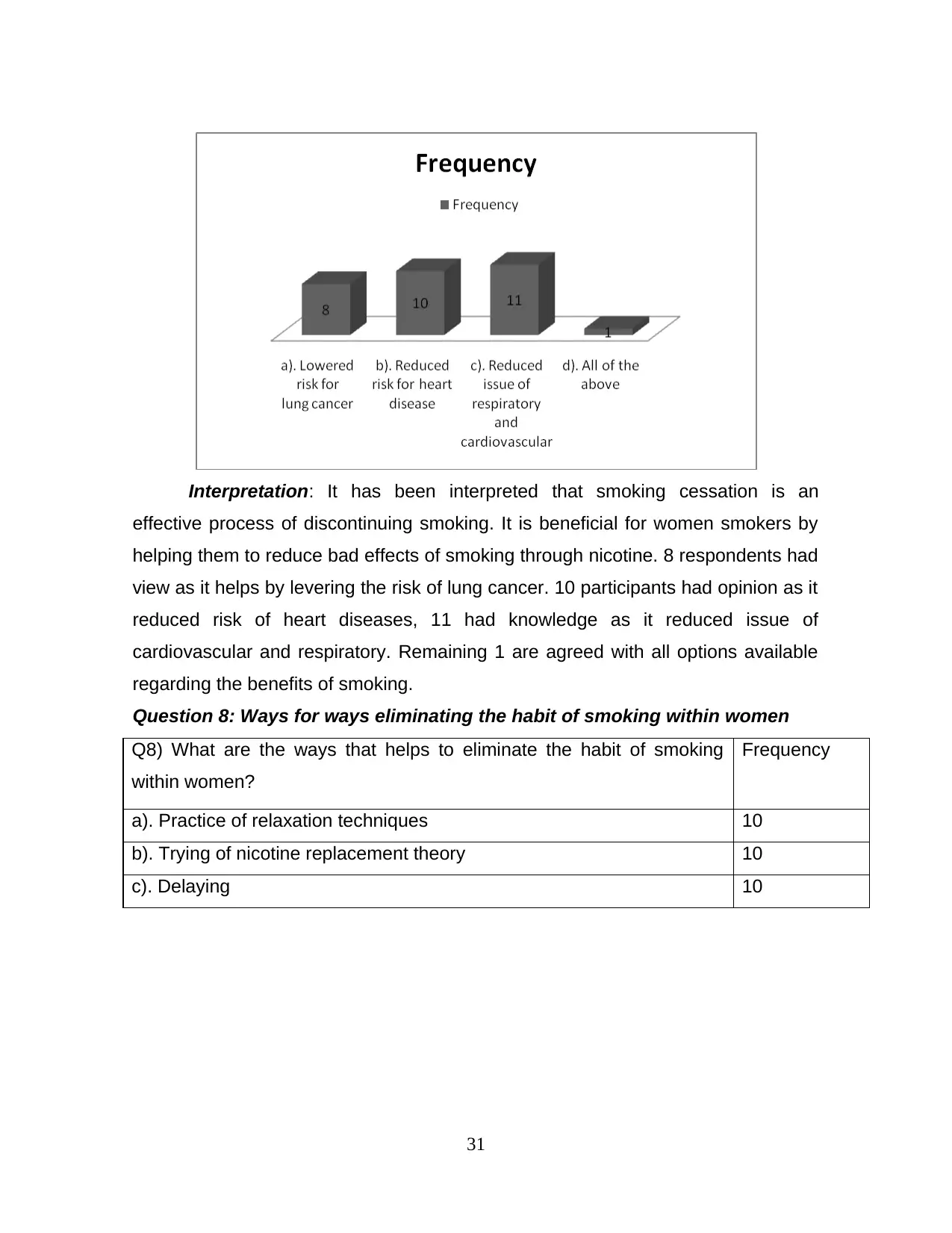
Interpretation: It has been interpreted that smoking cessation is an
effective process of discontinuing smoking. It is beneficial for women smokers by
helping them to reduce bad effects of smoking through nicotine. 8 respondents had
view as it helps by levering the risk of lung cancer. 10 participants had opinion as it
reduced risk of heart diseases, 11 had knowledge as it reduced issue of
cardiovascular and respiratory. Remaining 1 are agreed with all options available
regarding the benefits of smoking.
Question 8: Ways for ways eliminating the habit of smoking within women
Q8) What are the ways that helps to eliminate the habit of smoking
within women?
Frequency
a). Practice of relaxation techniques 10
b). Trying of nicotine replacement theory 10
c). Delaying 10
31
effective process of discontinuing smoking. It is beneficial for women smokers by
helping them to reduce bad effects of smoking through nicotine. 8 respondents had
view as it helps by levering the risk of lung cancer. 10 participants had opinion as it
reduced risk of heart diseases, 11 had knowledge as it reduced issue of
cardiovascular and respiratory. Remaining 1 are agreed with all options available
regarding the benefits of smoking.
Question 8: Ways for ways eliminating the habit of smoking within women
Q8) What are the ways that helps to eliminate the habit of smoking
within women?
Frequency
a). Practice of relaxation techniques 10
b). Trying of nicotine replacement theory 10
c). Delaying 10
31
Paraphrase This Document
Need a fresh take? Get an instant paraphrase of this document with our AI Paraphraser
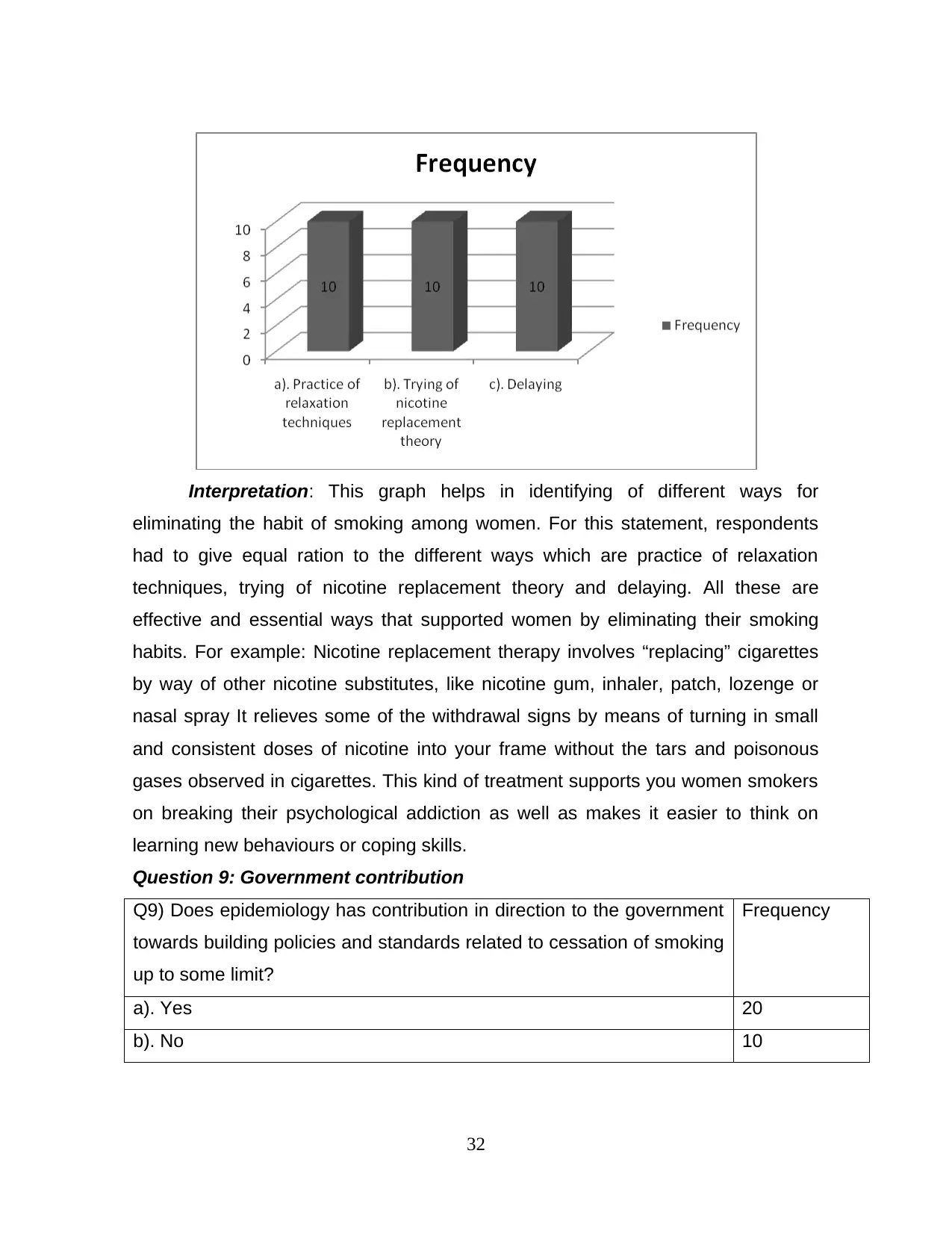
Interpretation: This graph helps in identifying of different ways for
eliminating the habit of smoking among women. For this statement, respondents
had to give equal ration to the different ways which are practice of relaxation
techniques, trying of nicotine replacement theory and delaying. All these are
effective and essential ways that supported women by eliminating their smoking
habits. For example: Nicotine replacement therapy involves “replacing” cigarettes
by way of other nicotine substitutes, like nicotine gum, inhaler, patch, lozenge or
nasal spray It relieves some of the withdrawal signs by means of turning in small
and consistent doses of nicotine into your frame without the tars and poisonous
gases observed in cigarettes. This kind of treatment supports you women smokers
on breaking their psychological addiction as well as makes it easier to think on
learning new behaviours or coping skills.
Question 9: Government contribution
Q9) Does epidemiology has contribution in direction to the government
towards building policies and standards related to cessation of smoking
up to some limit?
Frequency
a). Yes 20
b). No 10
32
eliminating the habit of smoking among women. For this statement, respondents
had to give equal ration to the different ways which are practice of relaxation
techniques, trying of nicotine replacement theory and delaying. All these are
effective and essential ways that supported women by eliminating their smoking
habits. For example: Nicotine replacement therapy involves “replacing” cigarettes
by way of other nicotine substitutes, like nicotine gum, inhaler, patch, lozenge or
nasal spray It relieves some of the withdrawal signs by means of turning in small
and consistent doses of nicotine into your frame without the tars and poisonous
gases observed in cigarettes. This kind of treatment supports you women smokers
on breaking their psychological addiction as well as makes it easier to think on
learning new behaviours or coping skills.
Question 9: Government contribution
Q9) Does epidemiology has contribution in direction to the government
towards building policies and standards related to cessation of smoking
up to some limit?
Frequency
a). Yes 20
b). No 10
32
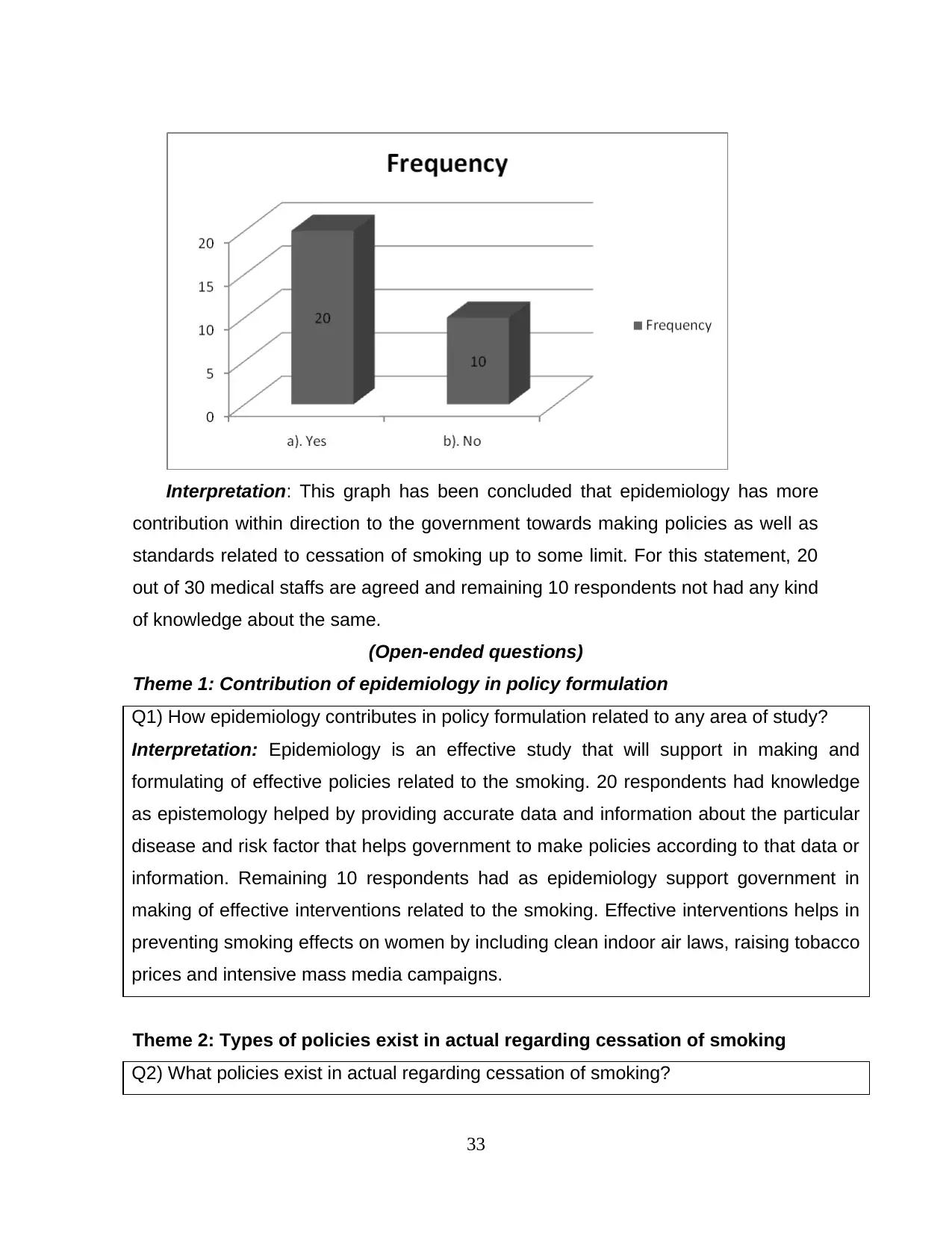
Interpretation: This graph has been concluded that epidemiology has more
contribution within direction to the government towards making policies as well as
standards related to cessation of smoking up to some limit. For this statement, 20
out of 30 medical staffs are agreed and remaining 10 respondents not had any kind
of knowledge about the same.
(Open-ended questions)
Theme 1: Contribution of epidemiology in policy formulation
Q1) How epidemiology contributes in policy formulation related to any area of study?
Interpretation: Epidemiology is an effective study that will support in making and
formulating of effective policies related to the smoking. 20 respondents had knowledge
as epistemology helped by providing accurate data and information about the particular
disease and risk factor that helps government to make policies according to that data or
information. Remaining 10 respondents had as epidemiology support government in
making of effective interventions related to the smoking. Effective interventions helps in
preventing smoking effects on women by including clean indoor air laws, raising tobacco
prices and intensive mass media campaigns.
Theme 2: Types of policies exist in actual regarding cessation of smoking
Q2) What policies exist in actual regarding cessation of smoking?
33
contribution within direction to the government towards making policies as well as
standards related to cessation of smoking up to some limit. For this statement, 20
out of 30 medical staffs are agreed and remaining 10 respondents not had any kind
of knowledge about the same.
(Open-ended questions)
Theme 1: Contribution of epidemiology in policy formulation
Q1) How epidemiology contributes in policy formulation related to any area of study?
Interpretation: Epidemiology is an effective study that will support in making and
formulating of effective policies related to the smoking. 20 respondents had knowledge
as epistemology helped by providing accurate data and information about the particular
disease and risk factor that helps government to make policies according to that data or
information. Remaining 10 respondents had as epidemiology support government in
making of effective interventions related to the smoking. Effective interventions helps in
preventing smoking effects on women by including clean indoor air laws, raising tobacco
prices and intensive mass media campaigns.
Theme 2: Types of policies exist in actual regarding cessation of smoking
Q2) What policies exist in actual regarding cessation of smoking?
33
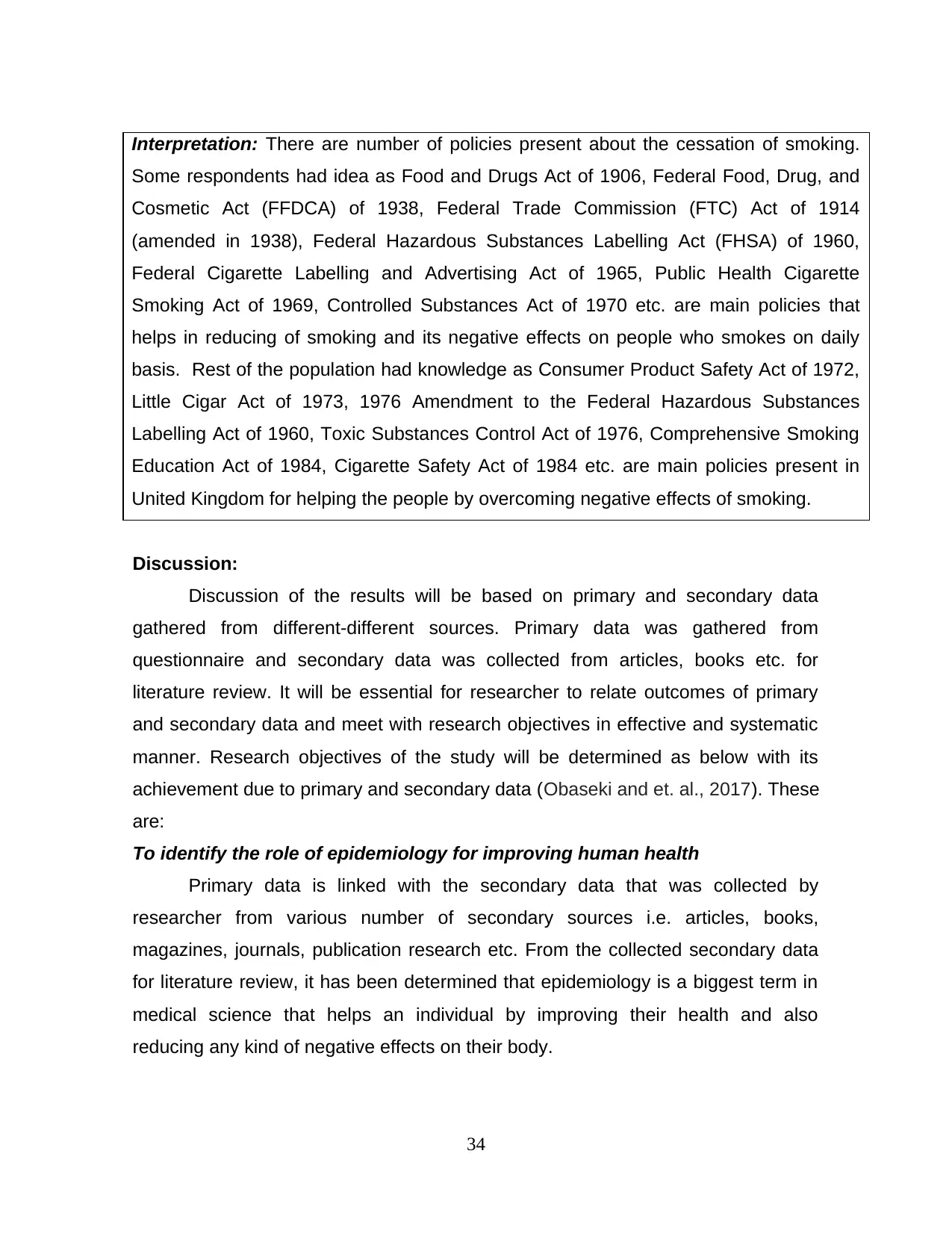
Interpretation: There are number of policies present about the cessation of smoking.
Some respondents had idea as Food and Drugs Act of 1906, Federal Food, Drug, and
Cosmetic Act (FFDCA) of 1938, Federal Trade Commission (FTC) Act of 1914
(amended in 1938), Federal Hazardous Substances Labelling Act (FHSA) of 1960,
Federal Cigarette Labelling and Advertising Act of 1965, Public Health Cigarette
Smoking Act of 1969, Controlled Substances Act of 1970 etc. are main policies that
helps in reducing of smoking and its negative effects on people who smokes on daily
basis. Rest of the population had knowledge as Consumer Product Safety Act of 1972,
Little Cigar Act of 1973, 1976 Amendment to the Federal Hazardous Substances
Labelling Act of 1960, Toxic Substances Control Act of 1976, Comprehensive Smoking
Education Act of 1984, Cigarette Safety Act of 1984 etc. are main policies present in
United Kingdom for helping the people by overcoming negative effects of smoking.
Discussion:
Discussion of the results will be based on primary and secondary data
gathered from different-different sources. Primary data was gathered from
questionnaire and secondary data was collected from articles, books etc. for
literature review. It will be essential for researcher to relate outcomes of primary
and secondary data and meet with research objectives in effective and systematic
manner. Research objectives of the study will be determined as below with its
achievement due to primary and secondary data (Obaseki and et. al., 2017). These
are:
To identify the role of epidemiology for improving human health
Primary data is linked with the secondary data that was collected by
researcher from various number of secondary sources i.e. articles, books,
magazines, journals, publication research etc. From the collected secondary data
for literature review, it has been determined that epidemiology is a biggest term in
medical science that helps an individual by improving their health and also
reducing any kind of negative effects on their body.
34
Some respondents had idea as Food and Drugs Act of 1906, Federal Food, Drug, and
Cosmetic Act (FFDCA) of 1938, Federal Trade Commission (FTC) Act of 1914
(amended in 1938), Federal Hazardous Substances Labelling Act (FHSA) of 1960,
Federal Cigarette Labelling and Advertising Act of 1965, Public Health Cigarette
Smoking Act of 1969, Controlled Substances Act of 1970 etc. are main policies that
helps in reducing of smoking and its negative effects on people who smokes on daily
basis. Rest of the population had knowledge as Consumer Product Safety Act of 1972,
Little Cigar Act of 1973, 1976 Amendment to the Federal Hazardous Substances
Labelling Act of 1960, Toxic Substances Control Act of 1976, Comprehensive Smoking
Education Act of 1984, Cigarette Safety Act of 1984 etc. are main policies present in
United Kingdom for helping the people by overcoming negative effects of smoking.
Discussion:
Discussion of the results will be based on primary and secondary data
gathered from different-different sources. Primary data was gathered from
questionnaire and secondary data was collected from articles, books etc. for
literature review. It will be essential for researcher to relate outcomes of primary
and secondary data and meet with research objectives in effective and systematic
manner. Research objectives of the study will be determined as below with its
achievement due to primary and secondary data (Obaseki and et. al., 2017). These
are:
To identify the role of epidemiology for improving human health
Primary data is linked with the secondary data that was collected by
researcher from various number of secondary sources i.e. articles, books,
magazines, journals, publication research etc. From the collected secondary data
for literature review, it has been determined that epidemiology is a biggest term in
medical science that helps an individual by improving their health and also
reducing any kind of negative effects on their body.
34
Secure Best Marks with AI Grader
Need help grading? Try our AI Grader for instant feedback on your assignments.
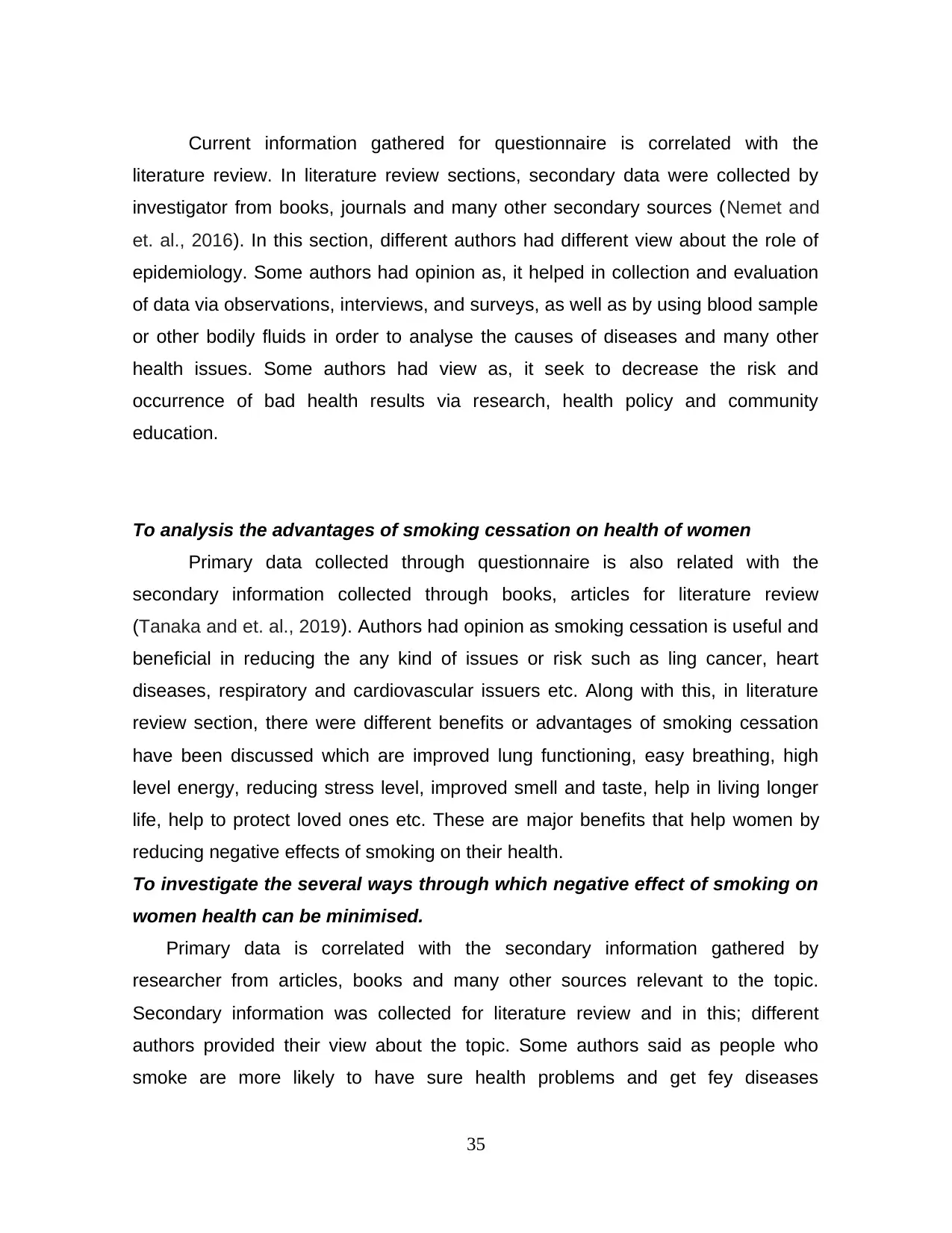
Current information gathered for questionnaire is correlated with the
literature review. In literature review sections, secondary data were collected by
investigator from books, journals and many other secondary sources (Nemet and
et. al., 2016). In this section, different authors had different view about the role of
epidemiology. Some authors had opinion as, it helped in collection and evaluation
of data via observations, interviews, and surveys, as well as by using blood sample
or other bodily fluids in order to analyse the causes of diseases and many other
health issues. Some authors had view as, it seek to decrease the risk and
occurrence of bad health results via research, health policy and community
education.
To analysis the advantages of smoking cessation on health of women
Primary data collected through questionnaire is also related with the
secondary information collected through books, articles for literature review
(Tanaka and et. al., 2019). Authors had opinion as smoking cessation is useful and
beneficial in reducing the any kind of issues or risk such as ling cancer, heart
diseases, respiratory and cardiovascular issuers etc. Along with this, in literature
review section, there were different benefits or advantages of smoking cessation
have been discussed which are improved lung functioning, easy breathing, high
level energy, reducing stress level, improved smell and taste, help in living longer
life, help to protect loved ones etc. These are major benefits that help women by
reducing negative effects of smoking on their health.
To investigate the several ways through which negative effect of smoking on
women health can be minimised.
Primary data is correlated with the secondary information gathered by
researcher from articles, books and many other sources relevant to the topic.
Secondary information was collected for literature review and in this; different
authors provided their view about the topic. Some authors said as people who
smoke are more likely to have sure health problems and get fey diseases
35
literature review. In literature review sections, secondary data were collected by
investigator from books, journals and many other secondary sources (Nemet and
et. al., 2016). In this section, different authors had different view about the role of
epidemiology. Some authors had opinion as, it helped in collection and evaluation
of data via observations, interviews, and surveys, as well as by using blood sample
or other bodily fluids in order to analyse the causes of diseases and many other
health issues. Some authors had view as, it seek to decrease the risk and
occurrence of bad health results via research, health policy and community
education.
To analysis the advantages of smoking cessation on health of women
Primary data collected through questionnaire is also related with the
secondary information collected through books, articles for literature review
(Tanaka and et. al., 2019). Authors had opinion as smoking cessation is useful and
beneficial in reducing the any kind of issues or risk such as ling cancer, heart
diseases, respiratory and cardiovascular issuers etc. Along with this, in literature
review section, there were different benefits or advantages of smoking cessation
have been discussed which are improved lung functioning, easy breathing, high
level energy, reducing stress level, improved smell and taste, help in living longer
life, help to protect loved ones etc. These are major benefits that help women by
reducing negative effects of smoking on their health.
To investigate the several ways through which negative effect of smoking on
women health can be minimised.
Primary data is correlated with the secondary information gathered by
researcher from articles, books and many other sources relevant to the topic.
Secondary information was collected for literature review and in this; different
authors provided their view about the topic. Some authors said as people who
smoke are more likely to have sure health problems and get fey diseases
35

compared to individuals who don’t smoke. Some fitness problems are immediate,
while others develop through the years (Trickey and et. al., 2017).
This data is related with the information gathered from secondary sources for
literature review. In this, some authors had opinion as NRTs is one of the best
ways for reducing the habit of smoking. NRTs help human beings address the
cravings and withdrawals that include quitting tobacco. It's always fine to seek
advice from your health practitioner earlier than beginning an NRT. Nicotine gum,
patch, nasal spray, inhaler and lozenge are all NRTs which can be permitted by
means of the Food and Drug Administration.
To determine the impact of epidemiology in minimising negative health
effects of smoking on women.
From the above collected primary data is correlated or related with the
secondary information gathered for literature review. In this, authors has opinion as
epidemiology is more essential and important part of medical because it support an
individual by preventing or eliminating any kind of risk related with the health.
Secondary data determined that epidemiology support women smokers by
providing accurate information about the side effects of smoking (El‐Serag, 2020).
36
while others develop through the years (Trickey and et. al., 2017).
This data is related with the information gathered from secondary sources for
literature review. In this, some authors had opinion as NRTs is one of the best
ways for reducing the habit of smoking. NRTs help human beings address the
cravings and withdrawals that include quitting tobacco. It's always fine to seek
advice from your health practitioner earlier than beginning an NRT. Nicotine gum,
patch, nasal spray, inhaler and lozenge are all NRTs which can be permitted by
means of the Food and Drug Administration.
To determine the impact of epidemiology in minimising negative health
effects of smoking on women.
From the above collected primary data is correlated or related with the
secondary information gathered for literature review. In this, authors has opinion as
epidemiology is more essential and important part of medical because it support an
individual by preventing or eliminating any kind of risk related with the health.
Secondary data determined that epidemiology support women smokers by
providing accurate information about the side effects of smoking (El‐Serag, 2020).
36
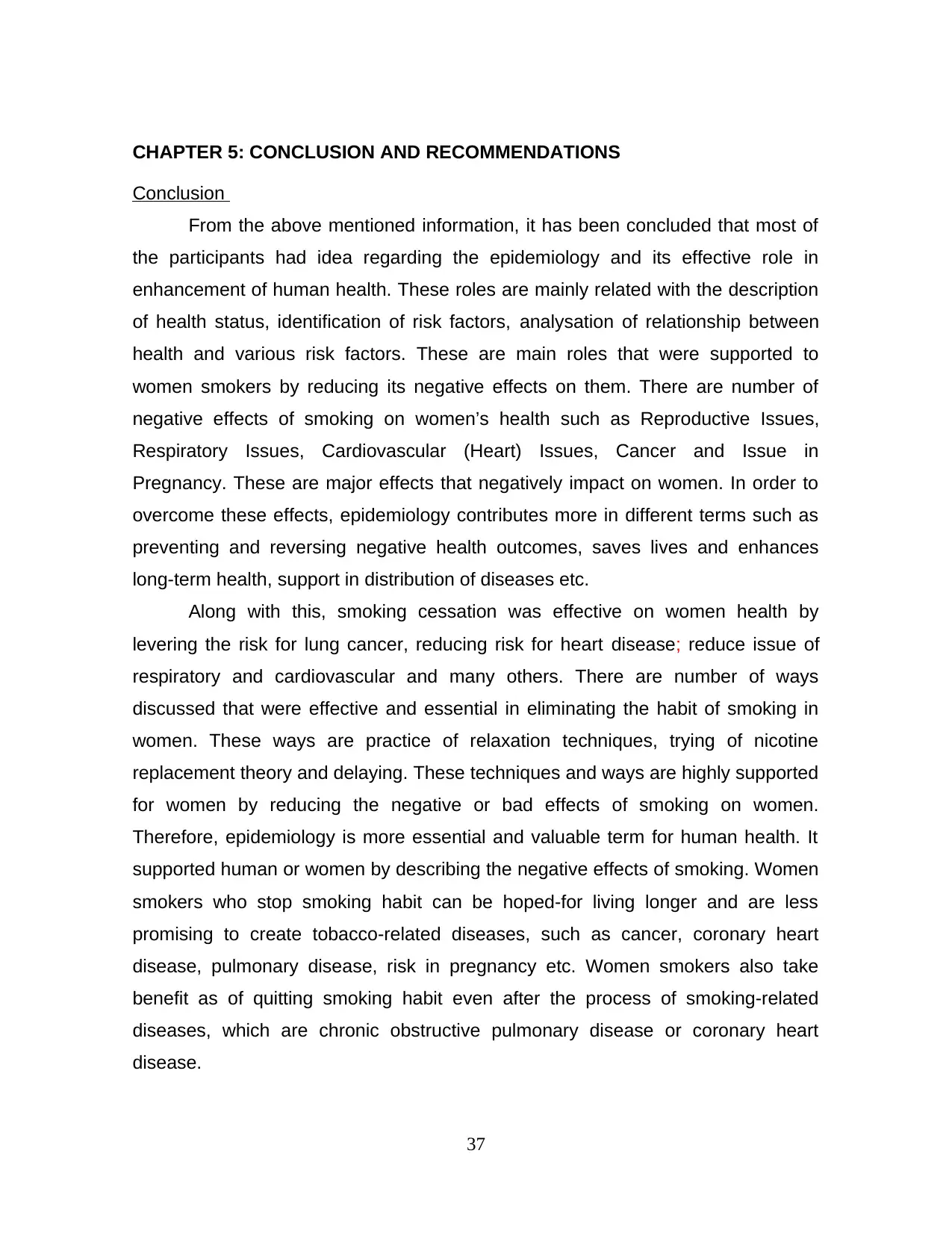
CHAPTER 5: CONCLUSION AND RECOMMENDATIONS
Conclusion
From the above mentioned information, it has been concluded that most of
the participants had idea regarding the epidemiology and its effective role in
enhancement of human health. These roles are mainly related with the description
of health status, identification of risk factors, analysation of relationship between
health and various risk factors. These are main roles that were supported to
women smokers by reducing its negative effects on them. There are number of
negative effects of smoking on women’s health such as Reproductive Issues,
Respiratory Issues, Cardiovascular (Heart) Issues, Cancer and Issue in
Pregnancy. These are major effects that negatively impact on women. In order to
overcome these effects, epidemiology contributes more in different terms such as
preventing and reversing negative health outcomes, saves lives and enhances
long-term health, support in distribution of diseases etc.
Along with this, smoking cessation was effective on women health by
levering the risk for lung cancer, reducing risk for heart disease; reduce issue of
respiratory and cardiovascular and many others. There are number of ways
discussed that were effective and essential in eliminating the habit of smoking in
women. These ways are practice of relaxation techniques, trying of nicotine
replacement theory and delaying. These techniques and ways are highly supported
for women by reducing the negative or bad effects of smoking on women.
Therefore, epidemiology is more essential and valuable term for human health. It
supported human or women by describing the negative effects of smoking. Women
smokers who stop smoking habit can be hoped-for living longer and are less
promising to create tobacco-related diseases, such as cancer, coronary heart
disease, pulmonary disease, risk in pregnancy etc. Women smokers also take
benefit as of quitting smoking habit even after the process of smoking-related
diseases, which are chronic obstructive pulmonary disease or coronary heart
disease.
37
Conclusion
From the above mentioned information, it has been concluded that most of
the participants had idea regarding the epidemiology and its effective role in
enhancement of human health. These roles are mainly related with the description
of health status, identification of risk factors, analysation of relationship between
health and various risk factors. These are main roles that were supported to
women smokers by reducing its negative effects on them. There are number of
negative effects of smoking on women’s health such as Reproductive Issues,
Respiratory Issues, Cardiovascular (Heart) Issues, Cancer and Issue in
Pregnancy. These are major effects that negatively impact on women. In order to
overcome these effects, epidemiology contributes more in different terms such as
preventing and reversing negative health outcomes, saves lives and enhances
long-term health, support in distribution of diseases etc.
Along with this, smoking cessation was effective on women health by
levering the risk for lung cancer, reducing risk for heart disease; reduce issue of
respiratory and cardiovascular and many others. There are number of ways
discussed that were effective and essential in eliminating the habit of smoking in
women. These ways are practice of relaxation techniques, trying of nicotine
replacement theory and delaying. These techniques and ways are highly supported
for women by reducing the negative or bad effects of smoking on women.
Therefore, epidemiology is more essential and valuable term for human health. It
supported human or women by describing the negative effects of smoking. Women
smokers who stop smoking habit can be hoped-for living longer and are less
promising to create tobacco-related diseases, such as cancer, coronary heart
disease, pulmonary disease, risk in pregnancy etc. Women smokers also take
benefit as of quitting smoking habit even after the process of smoking-related
diseases, which are chronic obstructive pulmonary disease or coronary heart
disease.
37
Paraphrase This Document
Need a fresh take? Get an instant paraphrase of this document with our AI Paraphraser

Recommendations
From the above mentioned data, it has been recommended that
epidemiology is an effective branch of medicine that helps in dealing with
incidence, distribution and possible control of any kind of diseases as well as other
factors relating to the health. There are some recommendations for overcoming the
negative impacts of smoking on women’s health. These ways will be
recommended as below:
Women smokers must consider non-nicotine medications as it will support
them by reducing the habit of smoking that result in no negative effects over
health. This will also support women by eliminating the bad effects of
smoking on their overall health progress. This will help women in stopping
smoking by decreasing the withdrawal and cravings symptoms without the
effective use of
Seeking of behavioural support will also support women by preventing or
stopping the negative effects of smoking on them. The emotional as well as
physical dependence an individual have on smoking makes it more
challenging to stay away from nicotine after they quit day.
Epidemiology is an effective and essential term that supports an individual
by helping them in reduction of any kind of disease effectively. This offers
powerful techniques to quantify or measures the degree to which hazard
factors as well as humanitarian interventions impact population health within
a crisis. These techniques include surveillance, surveys, analysis of
programme information, and rapid assessment.
There are some useful and effective therapies that will help women smokers
by preventing the side or negative effects of smoking on them. These
therapies are hypnosis, acupuncture, Behavioural therapy, motivational
therapy etc. Along with this, Nicotine addiction is mainly associated to the
habitual behaviours or rituals concerned in smoking. For this behaviour
therapy emphasis on learning innovating coping skills as well as breaking
38
From the above mentioned data, it has been recommended that
epidemiology is an effective branch of medicine that helps in dealing with
incidence, distribution and possible control of any kind of diseases as well as other
factors relating to the health. There are some recommendations for overcoming the
negative impacts of smoking on women’s health. These ways will be
recommended as below:
Women smokers must consider non-nicotine medications as it will support
them by reducing the habit of smoking that result in no negative effects over
health. This will also support women by eliminating the bad effects of
smoking on their overall health progress. This will help women in stopping
smoking by decreasing the withdrawal and cravings symptoms without the
effective use of
Seeking of behavioural support will also support women by preventing or
stopping the negative effects of smoking on them. The emotional as well as
physical dependence an individual have on smoking makes it more
challenging to stay away from nicotine after they quit day.
Epidemiology is an effective and essential term that supports an individual
by helping them in reduction of any kind of disease effectively. This offers
powerful techniques to quantify or measures the degree to which hazard
factors as well as humanitarian interventions impact population health within
a crisis. These techniques include surveillance, surveys, analysis of
programme information, and rapid assessment.
There are some useful and effective therapies that will help women smokers
by preventing the side or negative effects of smoking on them. These
therapies are hypnosis, acupuncture, Behavioural therapy, motivational
therapy etc. Along with this, Nicotine addiction is mainly associated to the
habitual behaviours or rituals concerned in smoking. For this behaviour
therapy emphasis on learning innovating coping skills as well as breaking
38

those habits. Therefore, all these will be more essential and significant for
women smokers to reduce the negative impacts of smoking on their health.
There are different numbers of effective examples that will support women
in eliminating the negative impact of smoking on them. These examples are
setting a particular time period to reduce over before quitting completely, by
setting goals to decrease by a certain number of cigarettes per day,
eliminating the time periods within the day when smoking occurs, following
pharmacotherapy, such as nicotine replacement therapy, or an electronic
cigarette which will help them in discouraging smoking as well as replacing
cigarettes. Women smokers will also set out an intention as it supports them
in reduction of smoking.
39
women smokers to reduce the negative impacts of smoking on their health.
There are different numbers of effective examples that will support women
in eliminating the negative impact of smoking on them. These examples are
setting a particular time period to reduce over before quitting completely, by
setting goals to decrease by a certain number of cigarettes per day,
eliminating the time periods within the day when smoking occurs, following
pharmacotherapy, such as nicotine replacement therapy, or an electronic
cigarette which will help them in discouraging smoking as well as replacing
cigarettes. Women smokers will also set out an intention as it supports them
in reduction of smoking.
39
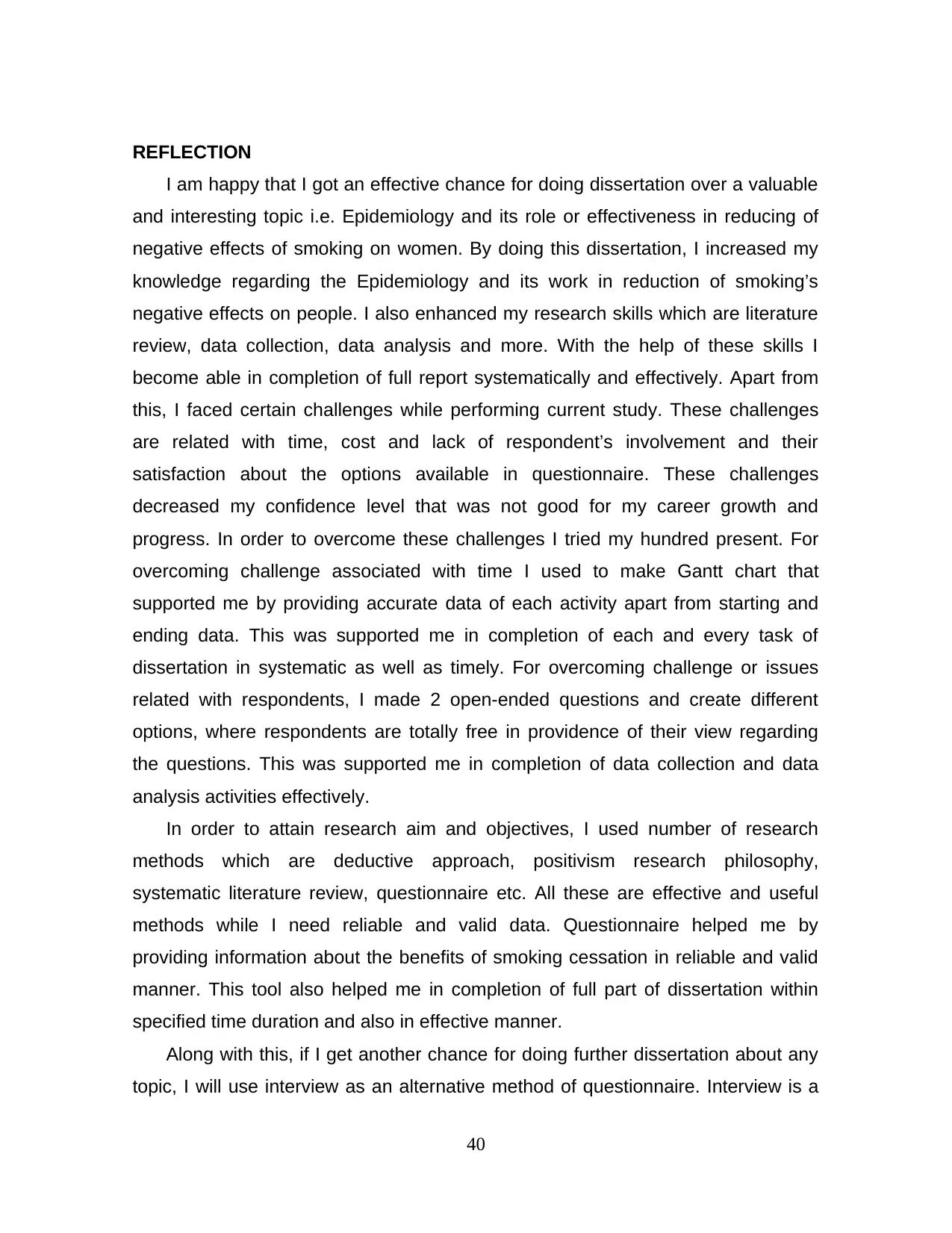
REFLECTION
I am happy that I got an effective chance for doing dissertation over a valuable
and interesting topic i.e. Epidemiology and its role or effectiveness in reducing of
negative effects of smoking on women. By doing this dissertation, I increased my
knowledge regarding the Epidemiology and its work in reduction of smoking’s
negative effects on people. I also enhanced my research skills which are literature
review, data collection, data analysis and more. With the help of these skills I
become able in completion of full report systematically and effectively. Apart from
this, I faced certain challenges while performing current study. These challenges
are related with time, cost and lack of respondent’s involvement and their
satisfaction about the options available in questionnaire. These challenges
decreased my confidence level that was not good for my career growth and
progress. In order to overcome these challenges I tried my hundred present. For
overcoming challenge associated with time I used to make Gantt chart that
supported me by providing accurate data of each activity apart from starting and
ending data. This was supported me in completion of each and every task of
dissertation in systematic as well as timely. For overcoming challenge or issues
related with respondents, I made 2 open-ended questions and create different
options, where respondents are totally free in providence of their view regarding
the questions. This was supported me in completion of data collection and data
analysis activities effectively.
In order to attain research aim and objectives, I used number of research
methods which are deductive approach, positivism research philosophy,
systematic literature review, questionnaire etc. All these are effective and useful
methods while I need reliable and valid data. Questionnaire helped me by
providing information about the benefits of smoking cessation in reliable and valid
manner. This tool also helped me in completion of full part of dissertation within
specified time duration and also in effective manner.
Along with this, if I get another chance for doing further dissertation about any
topic, I will use interview as an alternative method of questionnaire. Interview is a
40
I am happy that I got an effective chance for doing dissertation over a valuable
and interesting topic i.e. Epidemiology and its role or effectiveness in reducing of
negative effects of smoking on women. By doing this dissertation, I increased my
knowledge regarding the Epidemiology and its work in reduction of smoking’s
negative effects on people. I also enhanced my research skills which are literature
review, data collection, data analysis and more. With the help of these skills I
become able in completion of full report systematically and effectively. Apart from
this, I faced certain challenges while performing current study. These challenges
are related with time, cost and lack of respondent’s involvement and their
satisfaction about the options available in questionnaire. These challenges
decreased my confidence level that was not good for my career growth and
progress. In order to overcome these challenges I tried my hundred present. For
overcoming challenge associated with time I used to make Gantt chart that
supported me by providing accurate data of each activity apart from starting and
ending data. This was supported me in completion of each and every task of
dissertation in systematic as well as timely. For overcoming challenge or issues
related with respondents, I made 2 open-ended questions and create different
options, where respondents are totally free in providence of their view regarding
the questions. This was supported me in completion of data collection and data
analysis activities effectively.
In order to attain research aim and objectives, I used number of research
methods which are deductive approach, positivism research philosophy,
systematic literature review, questionnaire etc. All these are effective and useful
methods while I need reliable and valid data. Questionnaire helped me by
providing information about the benefits of smoking cessation in reliable and valid
manner. This tool also helped me in completion of full part of dissertation within
specified time duration and also in effective manner.
Along with this, if I get another chance for doing further dissertation about any
topic, I will use interview as an alternative method of questionnaire. Interview is a
40
Secure Best Marks with AI Grader
Need help grading? Try our AI Grader for instant feedback on your assignments.
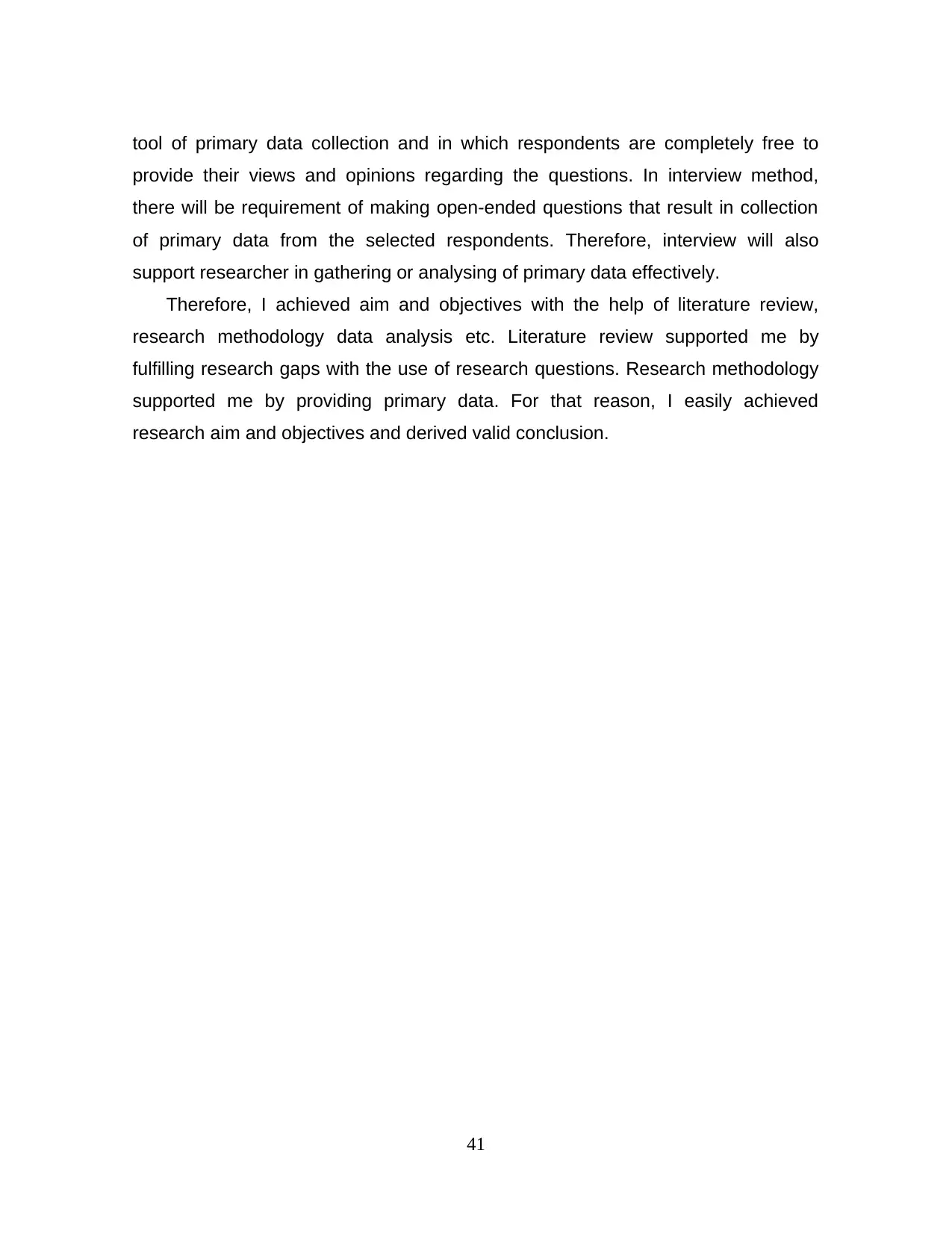
tool of primary data collection and in which respondents are completely free to
provide their views and opinions regarding the questions. In interview method,
there will be requirement of making open-ended questions that result in collection
of primary data from the selected respondents. Therefore, interview will also
support researcher in gathering or analysing of primary data effectively.
Therefore, I achieved aim and objectives with the help of literature review,
research methodology data analysis etc. Literature review supported me by
fulfilling research gaps with the use of research questions. Research methodology
supported me by providing primary data. For that reason, I easily achieved
research aim and objectives and derived valid conclusion.
41
provide their views and opinions regarding the questions. In interview method,
there will be requirement of making open-ended questions that result in collection
of primary data from the selected respondents. Therefore, interview will also
support researcher in gathering or analysing of primary data effectively.
Therefore, I achieved aim and objectives with the help of literature review,
research methodology data analysis etc. Literature review supported me by
fulfilling research gaps with the use of research questions. Research methodology
supported me by providing primary data. For that reason, I easily achieved
research aim and objectives and derived valid conclusion.
41
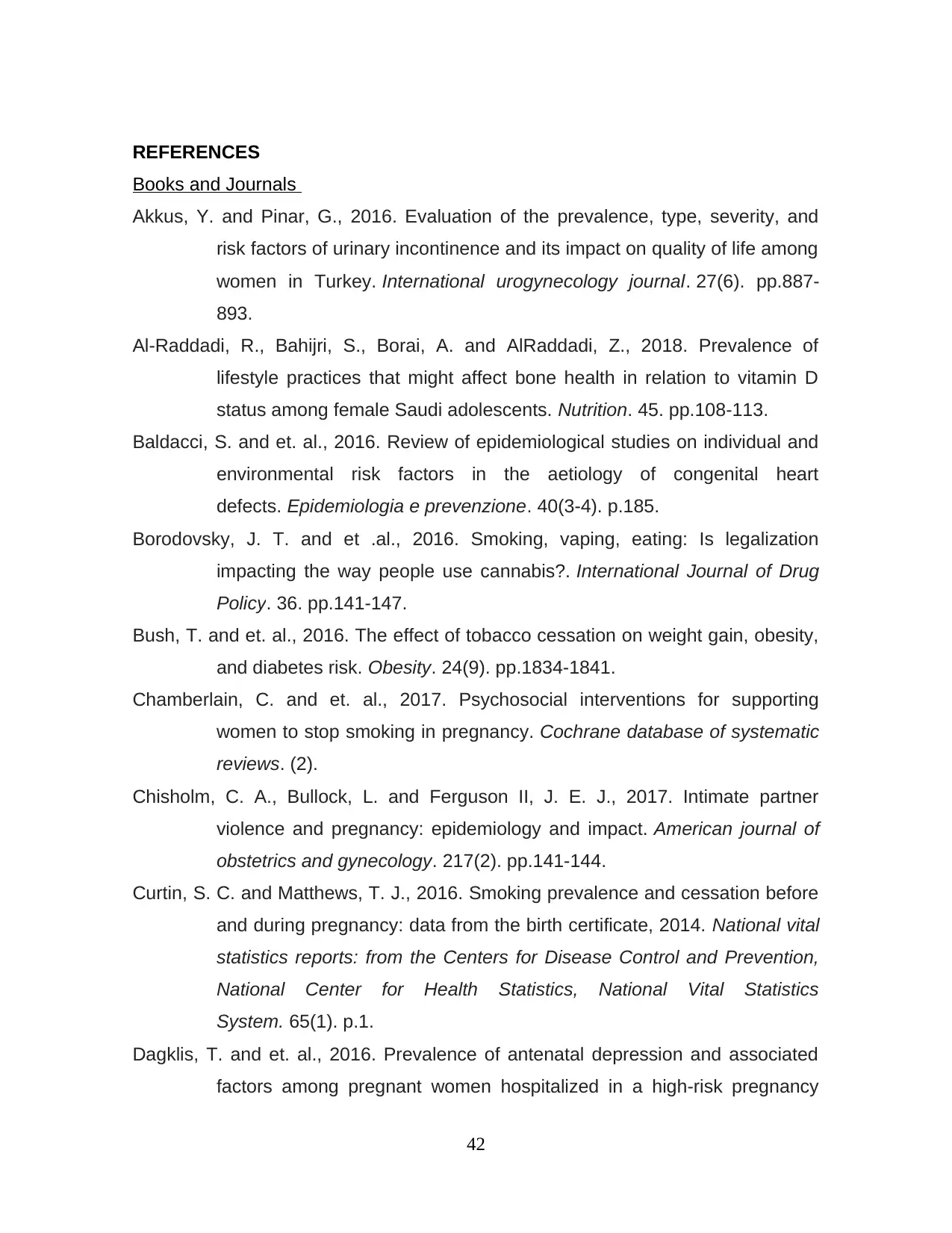
REFERENCES
Books and Journals
Akkus, Y. and Pinar, G., 2016. Evaluation of the prevalence, type, severity, and
risk factors of urinary incontinence and its impact on quality of life among
women in Turkey. International urogynecology journal. 27(6). pp.887-
893.
Al-Raddadi, R., Bahijri, S., Borai, A. and AlRaddadi, Z., 2018. Prevalence of
lifestyle practices that might affect bone health in relation to vitamin D
status among female Saudi adolescents. Nutrition. 45. pp.108-113.
Baldacci, S. and et. al., 2016. Review of epidemiological studies on individual and
environmental risk factors in the aetiology of congenital heart
defects. Epidemiologia e prevenzione. 40(3-4). p.185.
Borodovsky, J. T. and et .al., 2016. Smoking, vaping, eating: Is legalization
impacting the way people use cannabis?. International Journal of Drug
Policy. 36. pp.141-147.
Bush, T. and et. al., 2016. The effect of tobacco cessation on weight gain, obesity,
and diabetes risk. Obesity. 24(9). pp.1834-1841.
Chamberlain, C. and et. al., 2017. Psychosocial interventions for supporting
women to stop smoking in pregnancy. Cochrane database of systematic
reviews. (2).
Chisholm, C. A., Bullock, L. and Ferguson II, J. E. J., 2017. Intimate partner
violence and pregnancy: epidemiology and impact. American journal of
obstetrics and gynecology. 217(2). pp.141-144.
Curtin, S. C. and Matthews, T. J., 2016. Smoking prevalence and cessation before
and during pregnancy: data from the birth certificate, 2014. National vital
statistics reports: from the Centers for Disease Control and Prevention,
National Center for Health Statistics, National Vital Statistics
System. 65(1). p.1.
Dagklis, T. and et. al., 2016. Prevalence of antenatal depression and associated
factors among pregnant women hospitalized in a high-risk pregnancy
42
Books and Journals
Akkus, Y. and Pinar, G., 2016. Evaluation of the prevalence, type, severity, and
risk factors of urinary incontinence and its impact on quality of life among
women in Turkey. International urogynecology journal. 27(6). pp.887-
893.
Al-Raddadi, R., Bahijri, S., Borai, A. and AlRaddadi, Z., 2018. Prevalence of
lifestyle practices that might affect bone health in relation to vitamin D
status among female Saudi adolescents. Nutrition. 45. pp.108-113.
Baldacci, S. and et. al., 2016. Review of epidemiological studies on individual and
environmental risk factors in the aetiology of congenital heart
defects. Epidemiologia e prevenzione. 40(3-4). p.185.
Borodovsky, J. T. and et .al., 2016. Smoking, vaping, eating: Is legalization
impacting the way people use cannabis?. International Journal of Drug
Policy. 36. pp.141-147.
Bush, T. and et. al., 2016. The effect of tobacco cessation on weight gain, obesity,
and diabetes risk. Obesity. 24(9). pp.1834-1841.
Chamberlain, C. and et. al., 2017. Psychosocial interventions for supporting
women to stop smoking in pregnancy. Cochrane database of systematic
reviews. (2).
Chisholm, C. A., Bullock, L. and Ferguson II, J. E. J., 2017. Intimate partner
violence and pregnancy: epidemiology and impact. American journal of
obstetrics and gynecology. 217(2). pp.141-144.
Curtin, S. C. and Matthews, T. J., 2016. Smoking prevalence and cessation before
and during pregnancy: data from the birth certificate, 2014. National vital
statistics reports: from the Centers for Disease Control and Prevention,
National Center for Health Statistics, National Vital Statistics
System. 65(1). p.1.
Dagklis, T. and et. al., 2016. Prevalence of antenatal depression and associated
factors among pregnant women hospitalized in a high-risk pregnancy
42
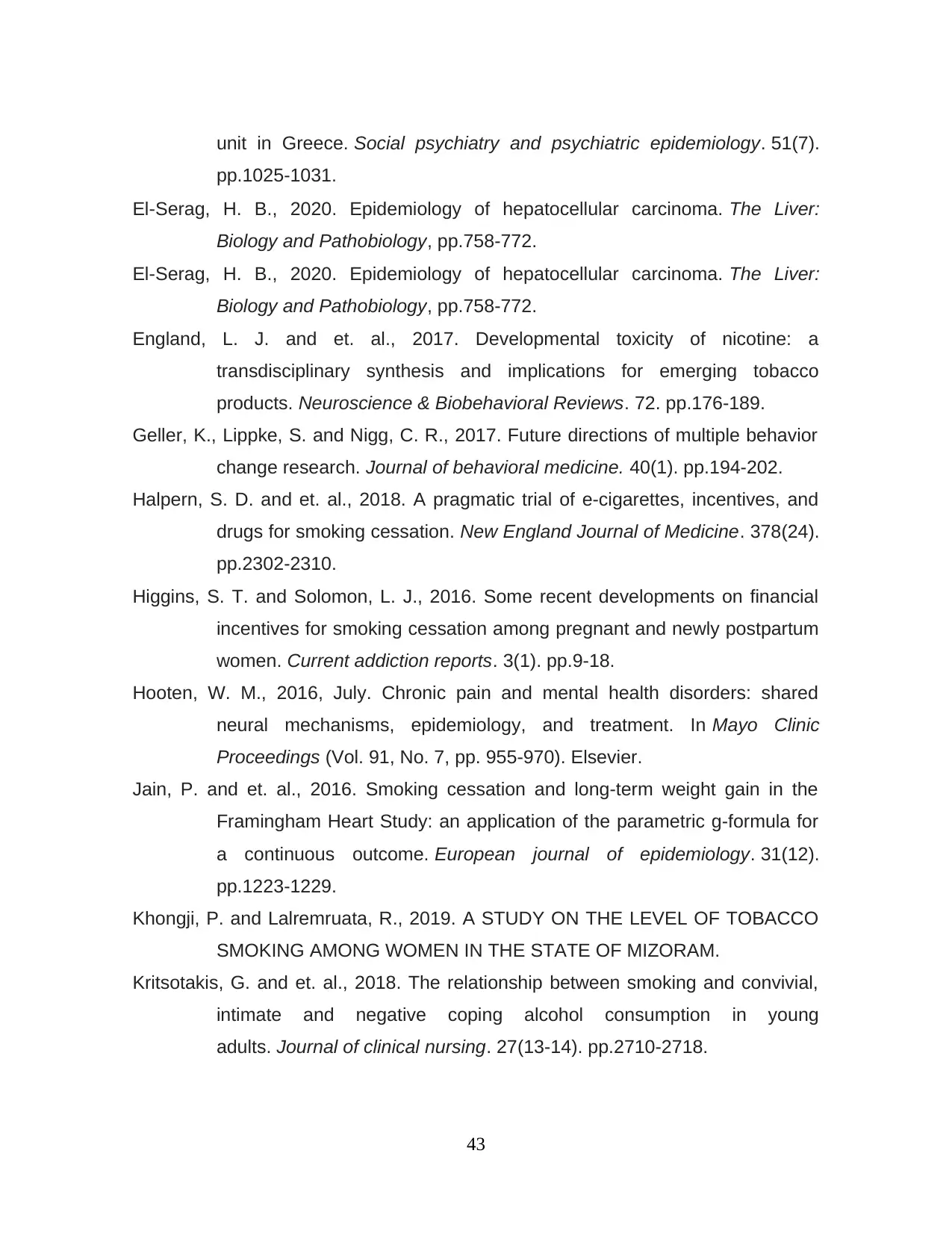
unit in Greece. Social psychiatry and psychiatric epidemiology. 51(7).
pp.1025-1031.
El‐Serag, H. B., 2020. Epidemiology of hepatocellular carcinoma. The Liver:
Biology and Pathobiology, pp.758-772.
El‐Serag, H. B., 2020. Epidemiology of hepatocellular carcinoma. The Liver:
Biology and Pathobiology, pp.758-772.
England, L. J. and et. al., 2017. Developmental toxicity of nicotine: a
transdisciplinary synthesis and implications for emerging tobacco
products. Neuroscience & Biobehavioral Reviews. 72. pp.176-189.
Geller, K., Lippke, S. and Nigg, C. R., 2017. Future directions of multiple behavior
change research. Journal of behavioral medicine. 40(1). pp.194-202.
Halpern, S. D. and et. al., 2018. A pragmatic trial of e-cigarettes, incentives, and
drugs for smoking cessation. New England Journal of Medicine. 378(24).
pp.2302-2310.
Higgins, S. T. and Solomon, L. J., 2016. Some recent developments on financial
incentives for smoking cessation among pregnant and newly postpartum
women. Current addiction reports. 3(1). pp.9-18.
Hooten, W. M., 2016, July. Chronic pain and mental health disorders: shared
neural mechanisms, epidemiology, and treatment. In Mayo Clinic
Proceedings (Vol. 91, No. 7, pp. 955-970). Elsevier.
Jain, P. and et. al., 2016. Smoking cessation and long-term weight gain in the
Framingham Heart Study: an application of the parametric g-formula for
a continuous outcome. European journal of epidemiology. 31(12).
pp.1223-1229.
Khongji, P. and Lalremruata, R., 2019. A STUDY ON THE LEVEL OF TOBACCO
SMOKING AMONG WOMEN IN THE STATE OF MIZORAM.
Kritsotakis, G. and et. al., 2018. The relationship between smoking and convivial,
intimate and negative coping alcohol consumption in young
adults. Journal of clinical nursing. 27(13-14). pp.2710-2718.
43
pp.1025-1031.
El‐Serag, H. B., 2020. Epidemiology of hepatocellular carcinoma. The Liver:
Biology and Pathobiology, pp.758-772.
El‐Serag, H. B., 2020. Epidemiology of hepatocellular carcinoma. The Liver:
Biology and Pathobiology, pp.758-772.
England, L. J. and et. al., 2017. Developmental toxicity of nicotine: a
transdisciplinary synthesis and implications for emerging tobacco
products. Neuroscience & Biobehavioral Reviews. 72. pp.176-189.
Geller, K., Lippke, S. and Nigg, C. R., 2017. Future directions of multiple behavior
change research. Journal of behavioral medicine. 40(1). pp.194-202.
Halpern, S. D. and et. al., 2018. A pragmatic trial of e-cigarettes, incentives, and
drugs for smoking cessation. New England Journal of Medicine. 378(24).
pp.2302-2310.
Higgins, S. T. and Solomon, L. J., 2016. Some recent developments on financial
incentives for smoking cessation among pregnant and newly postpartum
women. Current addiction reports. 3(1). pp.9-18.
Hooten, W. M., 2016, July. Chronic pain and mental health disorders: shared
neural mechanisms, epidemiology, and treatment. In Mayo Clinic
Proceedings (Vol. 91, No. 7, pp. 955-970). Elsevier.
Jain, P. and et. al., 2016. Smoking cessation and long-term weight gain in the
Framingham Heart Study: an application of the parametric g-formula for
a continuous outcome. European journal of epidemiology. 31(12).
pp.1223-1229.
Khongji, P. and Lalremruata, R., 2019. A STUDY ON THE LEVEL OF TOBACCO
SMOKING AMONG WOMEN IN THE STATE OF MIZORAM.
Kritsotakis, G. and et. al., 2018. The relationship between smoking and convivial,
intimate and negative coping alcohol consumption in young
adults. Journal of clinical nursing. 27(13-14). pp.2710-2718.
43
Paraphrase This Document
Need a fresh take? Get an instant paraphrase of this document with our AI Paraphraser

McCall, S. J., Flett, G., Okpo, E. and Bhattacharya, S., 2016. Who has a repeat
abortion? Identifying women at risk of repeated terminations of
pregnancy: analysis of routinely collected health care data. Journal of
Family Planning and Reproductive Health Care. 42(2). pp.133-142.
Memon, A. and et. al., 2016. What factors are important in smoking cessation and
relapse in women from deprived communities? A qualitative study in
Southeast England. Public Health. 134. pp.39-45.
Mygind, N. D. and et. al., 2016. Coronary microvascular function and
cardiovascular risk factors in women with angina pectoris and no
obstructive coronary artery disease: the iPOWER study. Journal of the
American Heart Association. 5(3). p.e003064.
Nemet, A.Y. and et. al., 2016, September. Epidemiology and associated morbidity
of pterygium: a large, community-based case-control study. In Seminars
in ophthalmology (Vol. 31, No. 5, pp. 446-451). Taylor & Francis.
Nordenstam, F., 2019. Perinatal snus exposure and cardiovascular function in the
child.
Nordestgaard, B. G., 2016. Triglyceride-rich lipoproteins and atherosclerotic
cardiovascular disease: new insights from epidemiology, genetics, and
biology. Circulation research. 118(4). pp.547-563.
NSONWU, A. A. C. and et. al., 2016. Thyroid function and some biochemical
indices in male active smokers in calabar metropolis.
Obaseki, D. O. and et. al., 2017. Reduced forced vital capacity in an African
population. Prevalence and risk factors. Annals of the American Thoracic
Society. 14(5). pp.714-721.
Penninx, B. W., 2017. Depression and cardiovascular disease: epidemiological
evidence on their linking mechanisms. Neuroscience & Biobehavioral
Reviews. 74. pp.277-286.
Roberts, S. C. M. and et. al., 2016. Moderators and mediators of the relationship
between receiving versus being denied a pregnancy termination and
44
abortion? Identifying women at risk of repeated terminations of
pregnancy: analysis of routinely collected health care data. Journal of
Family Planning and Reproductive Health Care. 42(2). pp.133-142.
Memon, A. and et. al., 2016. What factors are important in smoking cessation and
relapse in women from deprived communities? A qualitative study in
Southeast England. Public Health. 134. pp.39-45.
Mygind, N. D. and et. al., 2016. Coronary microvascular function and
cardiovascular risk factors in women with angina pectoris and no
obstructive coronary artery disease: the iPOWER study. Journal of the
American Heart Association. 5(3). p.e003064.
Nemet, A.Y. and et. al., 2016, September. Epidemiology and associated morbidity
of pterygium: a large, community-based case-control study. In Seminars
in ophthalmology (Vol. 31, No. 5, pp. 446-451). Taylor & Francis.
Nordenstam, F., 2019. Perinatal snus exposure and cardiovascular function in the
child.
Nordestgaard, B. G., 2016. Triglyceride-rich lipoproteins and atherosclerotic
cardiovascular disease: new insights from epidemiology, genetics, and
biology. Circulation research. 118(4). pp.547-563.
NSONWU, A. A. C. and et. al., 2016. Thyroid function and some biochemical
indices in male active smokers in calabar metropolis.
Obaseki, D. O. and et. al., 2017. Reduced forced vital capacity in an African
population. Prevalence and risk factors. Annals of the American Thoracic
Society. 14(5). pp.714-721.
Penninx, B. W., 2017. Depression and cardiovascular disease: epidemiological
evidence on their linking mechanisms. Neuroscience & Biobehavioral
Reviews. 74. pp.277-286.
Roberts, S. C. M. and et. al., 2016. Moderators and mediators of the relationship
between receiving versus being denied a pregnancy termination and
44
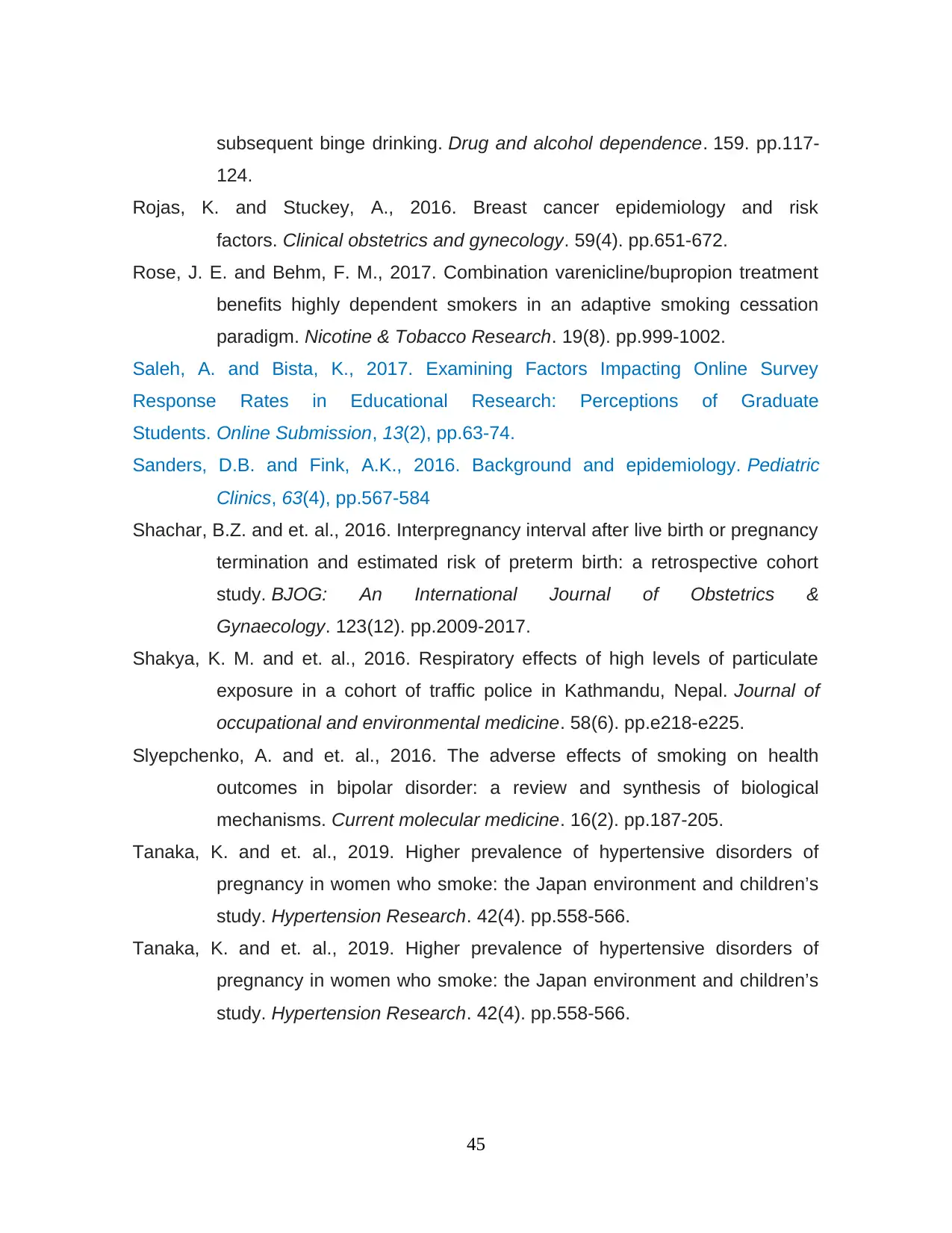
subsequent binge drinking. Drug and alcohol dependence. 159. pp.117-
124.
Rojas, K. and Stuckey, A., 2016. Breast cancer epidemiology and risk
factors. Clinical obstetrics and gynecology. 59(4). pp.651-672.
Rose, J. E. and Behm, F. M., 2017. Combination varenicline/bupropion treatment
benefits highly dependent smokers in an adaptive smoking cessation
paradigm. Nicotine & Tobacco Research. 19(8). pp.999-1002.
Saleh, A. and Bista, K., 2017. Examining Factors Impacting Online Survey
Response Rates in Educational Research: Perceptions of Graduate
Students. Online Submission, 13(2), pp.63-74.
Sanders, D.B. and Fink, A.K., 2016. Background and epidemiology. Pediatric
Clinics, 63(4), pp.567-584
Shachar, B.Z. and et. al., 2016. Interpregnancy interval after live birth or pregnancy
termination and estimated risk of preterm birth: a retrospective cohort
study. BJOG: An International Journal of Obstetrics &
Gynaecology. 123(12). pp.2009-2017.
Shakya, K. M. and et. al., 2016. Respiratory effects of high levels of particulate
exposure in a cohort of traffic police in Kathmandu, Nepal. Journal of
occupational and environmental medicine. 58(6). pp.e218-e225.
Slyepchenko, A. and et. al., 2016. The adverse effects of smoking on health
outcomes in bipolar disorder: a review and synthesis of biological
mechanisms. Current molecular medicine. 16(2). pp.187-205.
Tanaka, K. and et. al., 2019. Higher prevalence of hypertensive disorders of
pregnancy in women who smoke: the Japan environment and children’s
study. Hypertension Research. 42(4). pp.558-566.
Tanaka, K. and et. al., 2019. Higher prevalence of hypertensive disorders of
pregnancy in women who smoke: the Japan environment and children’s
study. Hypertension Research. 42(4). pp.558-566.
45
124.
Rojas, K. and Stuckey, A., 2016. Breast cancer epidemiology and risk
factors. Clinical obstetrics and gynecology. 59(4). pp.651-672.
Rose, J. E. and Behm, F. M., 2017. Combination varenicline/bupropion treatment
benefits highly dependent smokers in an adaptive smoking cessation
paradigm. Nicotine & Tobacco Research. 19(8). pp.999-1002.
Saleh, A. and Bista, K., 2017. Examining Factors Impacting Online Survey
Response Rates in Educational Research: Perceptions of Graduate
Students. Online Submission, 13(2), pp.63-74.
Sanders, D.B. and Fink, A.K., 2016. Background and epidemiology. Pediatric
Clinics, 63(4), pp.567-584
Shachar, B.Z. and et. al., 2016. Interpregnancy interval after live birth or pregnancy
termination and estimated risk of preterm birth: a retrospective cohort
study. BJOG: An International Journal of Obstetrics &
Gynaecology. 123(12). pp.2009-2017.
Shakya, K. M. and et. al., 2016. Respiratory effects of high levels of particulate
exposure in a cohort of traffic police in Kathmandu, Nepal. Journal of
occupational and environmental medicine. 58(6). pp.e218-e225.
Slyepchenko, A. and et. al., 2016. The adverse effects of smoking on health
outcomes in bipolar disorder: a review and synthesis of biological
mechanisms. Current molecular medicine. 16(2). pp.187-205.
Tanaka, K. and et. al., 2019. Higher prevalence of hypertensive disorders of
pregnancy in women who smoke: the Japan environment and children’s
study. Hypertension Research. 42(4). pp.558-566.
Tanaka, K. and et. al., 2019. Higher prevalence of hypertensive disorders of
pregnancy in women who smoke: the Japan environment and children’s
study. Hypertension Research. 42(4). pp.558-566.
45
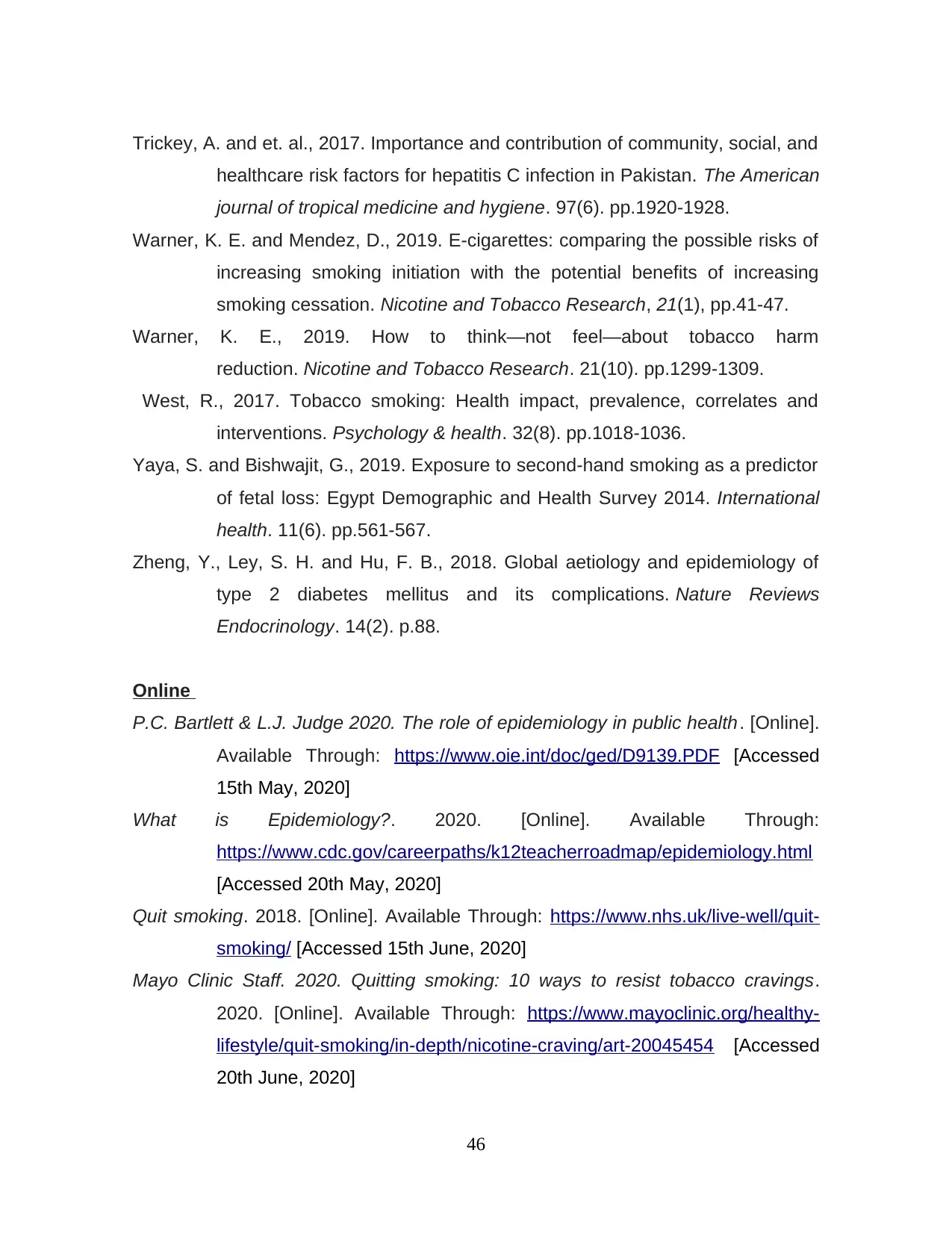
Trickey, A. and et. al., 2017. Importance and contribution of community, social, and
healthcare risk factors for hepatitis C infection in Pakistan. The American
journal of tropical medicine and hygiene. 97(6). pp.1920-1928.
Warner, K. E. and Mendez, D., 2019. E-cigarettes: comparing the possible risks of
increasing smoking initiation with the potential benefits of increasing
smoking cessation. Nicotine and Tobacco Research, 21(1), pp.41-47.
Warner, K. E., 2019. How to think—not feel—about tobacco harm
reduction. Nicotine and Tobacco Research. 21(10). pp.1299-1309.
West, R., 2017. Tobacco smoking: Health impact, prevalence, correlates and
interventions. Psychology & health. 32(8). pp.1018-1036.
Yaya, S. and Bishwajit, G., 2019. Exposure to second-hand smoking as a predictor
of fetal loss: Egypt Demographic and Health Survey 2014. International
health. 11(6). pp.561-567.
Zheng, Y., Ley, S. H. and Hu, F. B., 2018. Global aetiology and epidemiology of
type 2 diabetes mellitus and its complications. Nature Reviews
Endocrinology. 14(2). p.88.
Online
P.C. Bartlett & L.J. Judge 2020. The role of epidemiology in public health. [Online].
Available Through: https://www.oie.int/doc/ged/D9139.PDF [Accessed
15th May, 2020]
What is Epidemiology?. 2020. [Online]. Available Through:
https://www.cdc.gov/careerpaths/k12teacherroadmap/epidemiology.html
[Accessed 20th May, 2020]
Quit smoking. 2018. [Online]. Available Through: https://www.nhs.uk/live-well/quit-
smoking/ [Accessed 15th June, 2020]
Mayo Clinic Staff. 2020. Quitting smoking: 10 ways to resist tobacco cravings.
2020. [Online]. Available Through: https://www.mayoclinic.org/healthy-
lifestyle/quit-smoking/in-depth/nicotine-craving/art-20045454 [Accessed
20th June, 2020]
46
healthcare risk factors for hepatitis C infection in Pakistan. The American
journal of tropical medicine and hygiene. 97(6). pp.1920-1928.
Warner, K. E. and Mendez, D., 2019. E-cigarettes: comparing the possible risks of
increasing smoking initiation with the potential benefits of increasing
smoking cessation. Nicotine and Tobacco Research, 21(1), pp.41-47.
Warner, K. E., 2019. How to think—not feel—about tobacco harm
reduction. Nicotine and Tobacco Research. 21(10). pp.1299-1309.
West, R., 2017. Tobacco smoking: Health impact, prevalence, correlates and
interventions. Psychology & health. 32(8). pp.1018-1036.
Yaya, S. and Bishwajit, G., 2019. Exposure to second-hand smoking as a predictor
of fetal loss: Egypt Demographic and Health Survey 2014. International
health. 11(6). pp.561-567.
Zheng, Y., Ley, S. H. and Hu, F. B., 2018. Global aetiology and epidemiology of
type 2 diabetes mellitus and its complications. Nature Reviews
Endocrinology. 14(2). p.88.
Online
P.C. Bartlett & L.J. Judge 2020. The role of epidemiology in public health. [Online].
Available Through: https://www.oie.int/doc/ged/D9139.PDF [Accessed
15th May, 2020]
What is Epidemiology?. 2020. [Online]. Available Through:
https://www.cdc.gov/careerpaths/k12teacherroadmap/epidemiology.html
[Accessed 20th May, 2020]
Quit smoking. 2018. [Online]. Available Through: https://www.nhs.uk/live-well/quit-
smoking/ [Accessed 15th June, 2020]
Mayo Clinic Staff. 2020. Quitting smoking: 10 ways to resist tobacco cravings.
2020. [Online]. Available Through: https://www.mayoclinic.org/healthy-
lifestyle/quit-smoking/in-depth/nicotine-craving/art-20045454 [Accessed
20th June, 2020]
46
Secure Best Marks with AI Grader
Need help grading? Try our AI Grader for instant feedback on your assignments.

47
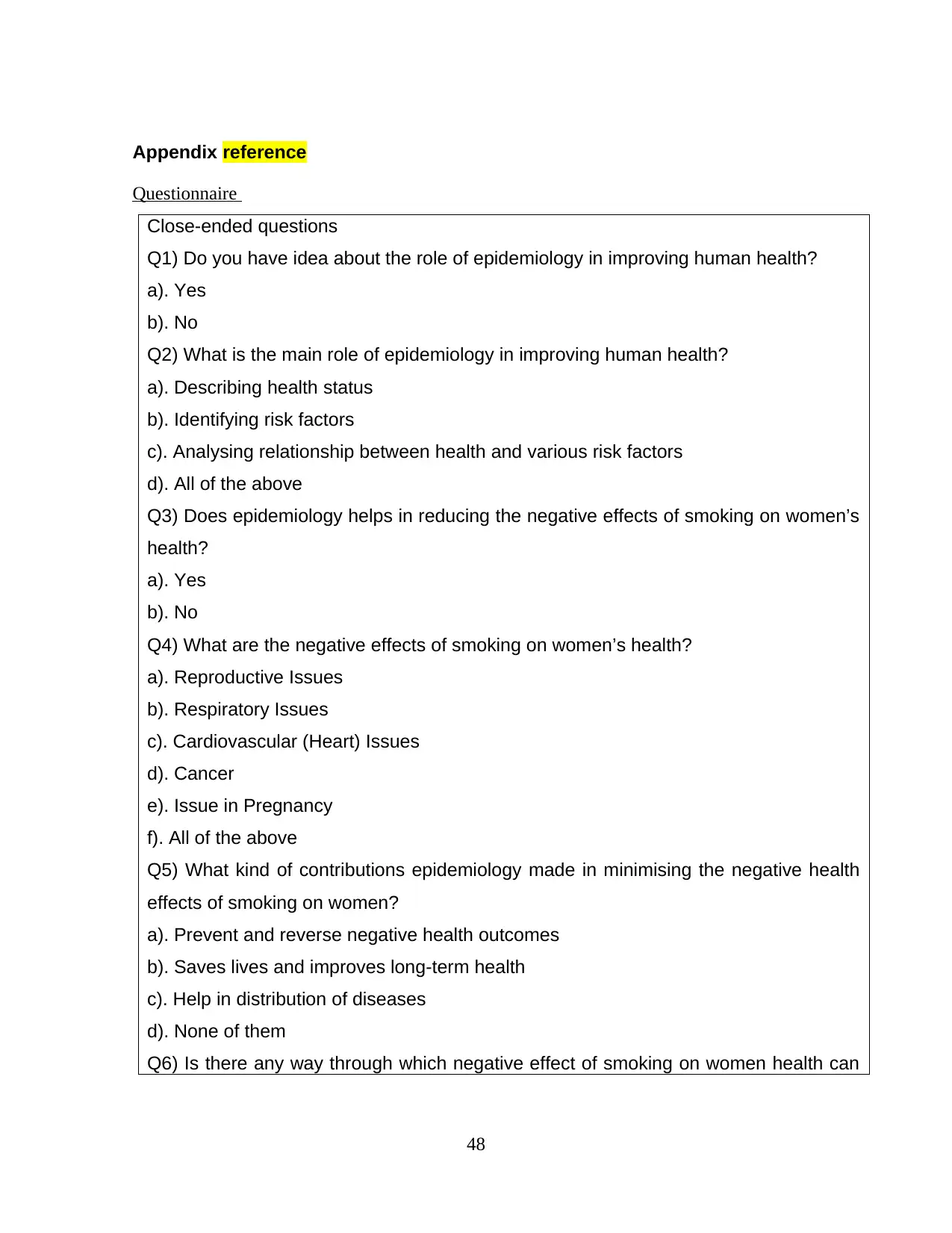
Appendix reference
Questionnaire
Close-ended questions
Q1) Do you have idea about the role of epidemiology in improving human health?
a). Yes
b). No
Q2) What is the main role of epidemiology in improving human health?
a). Describing health status
b). Identifying risk factors
c). Analysing relationship between health and various risk factors
d). All of the above
Q3) Does epidemiology helps in reducing the negative effects of smoking on women’s
health?
a). Yes
b). No
Q4) What are the negative effects of smoking on women’s health?
a). Reproductive Issues
b). Respiratory Issues
c). Cardiovascular (Heart) Issues
d). Cancer
e). Issue in Pregnancy
f). All of the above
Q5) What kind of contributions epidemiology made in minimising the negative health
effects of smoking on women?
a). Prevent and reverse negative health outcomes
b). Saves lives and improves long-term health
c). Help in distribution of diseases
d). None of them
Q6) Is there any way through which negative effect of smoking on women health can
48
Questionnaire
Close-ended questions
Q1) Do you have idea about the role of epidemiology in improving human health?
a). Yes
b). No
Q2) What is the main role of epidemiology in improving human health?
a). Describing health status
b). Identifying risk factors
c). Analysing relationship between health and various risk factors
d). All of the above
Q3) Does epidemiology helps in reducing the negative effects of smoking on women’s
health?
a). Yes
b). No
Q4) What are the negative effects of smoking on women’s health?
a). Reproductive Issues
b). Respiratory Issues
c). Cardiovascular (Heart) Issues
d). Cancer
e). Issue in Pregnancy
f). All of the above
Q5) What kind of contributions epidemiology made in minimising the negative health
effects of smoking on women?
a). Prevent and reverse negative health outcomes
b). Saves lives and improves long-term health
c). Help in distribution of diseases
d). None of them
Q6) Is there any way through which negative effect of smoking on women health can
48
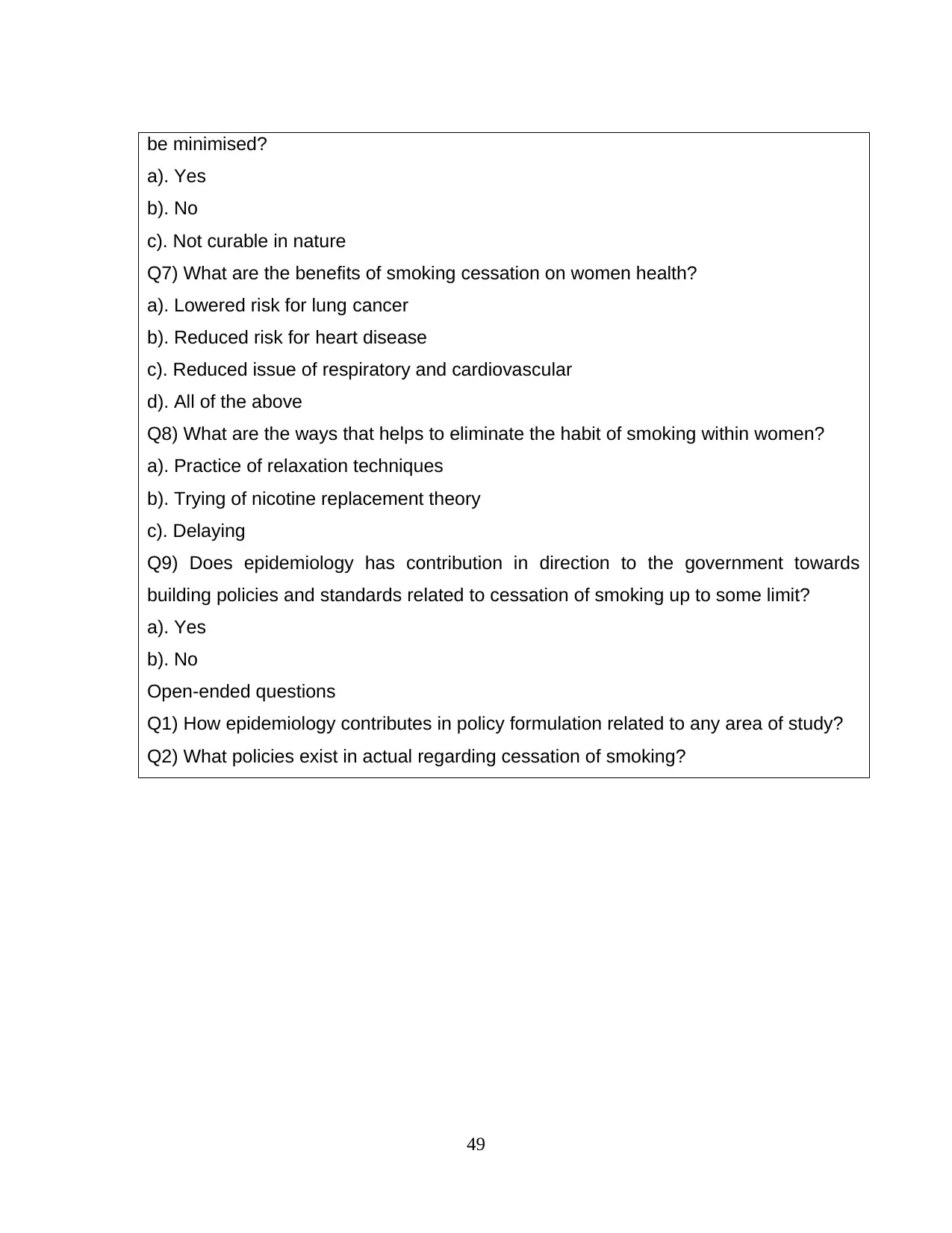
be minimised?
a). Yes
b). No
c). Not curable in nature
Q7) What are the benefits of smoking cessation on women health?
a). Lowered risk for lung cancer
b). Reduced risk for heart disease
c). Reduced issue of respiratory and cardiovascular
d). All of the above
Q8) What are the ways that helps to eliminate the habit of smoking within women?
a). Practice of relaxation techniques
b). Trying of nicotine replacement theory
c). Delaying
Q9) Does epidemiology has contribution in direction to the government towards
building policies and standards related to cessation of smoking up to some limit?
a). Yes
b). No
Open-ended questions
Q1) How epidemiology contributes in policy formulation related to any area of study?
Q2) What policies exist in actual regarding cessation of smoking?
49
a). Yes
b). No
c). Not curable in nature
Q7) What are the benefits of smoking cessation on women health?
a). Lowered risk for lung cancer
b). Reduced risk for heart disease
c). Reduced issue of respiratory and cardiovascular
d). All of the above
Q8) What are the ways that helps to eliminate the habit of smoking within women?
a). Practice of relaxation techniques
b). Trying of nicotine replacement theory
c). Delaying
Q9) Does epidemiology has contribution in direction to the government towards
building policies and standards related to cessation of smoking up to some limit?
a). Yes
b). No
Open-ended questions
Q1) How epidemiology contributes in policy formulation related to any area of study?
Q2) What policies exist in actual regarding cessation of smoking?
49
1 out of 49
Related Documents
Your All-in-One AI-Powered Toolkit for Academic Success.
+13062052269
info@desklib.com
Available 24*7 on WhatsApp / Email
![[object Object]](/_next/static/media/star-bottom.7253800d.svg)
Unlock your academic potential
© 2024 | Zucol Services PVT LTD | All rights reserved.





